Part 7 - Jerusalem

Day 9 – Ashdod (Jerusalem)
So here they were, the days we had so been looking forward to and about which we had worried so much due to the riots. THE reason for us to book this cruise... two days in Jerusalem!
Excursions had been offered en masse prior to the trip. Jerusalem, Tel Aviv, Bethlehem, the Dead Sea, all kinds of pilgrimage sites – in some cases even all in one day. We didn’t want any of that. Our goal was to see and experience Jerusalem and, if we had the time, drive to the Dead Sea and visit the Fortress of Masada. That’s why we had booked a rental car in Ashdod and a hotel right next to Jerusalem’s old city walls, where we would stay overnight.
Since the ship was to stay in Ashdod until 10.00 pm the following day and then continue to Haifa, which was only 2 hours away, this was basically a risk-free plan.
However, it wasn’t to start off quite so smoothly. At the exit of the ship people backed up. The Centrum, the corridors and stairwells leading there, simply everything around it, was packed with people. Since we were all guided through the bottleneck of the elevators, the whole scene had something of a cattle drive.
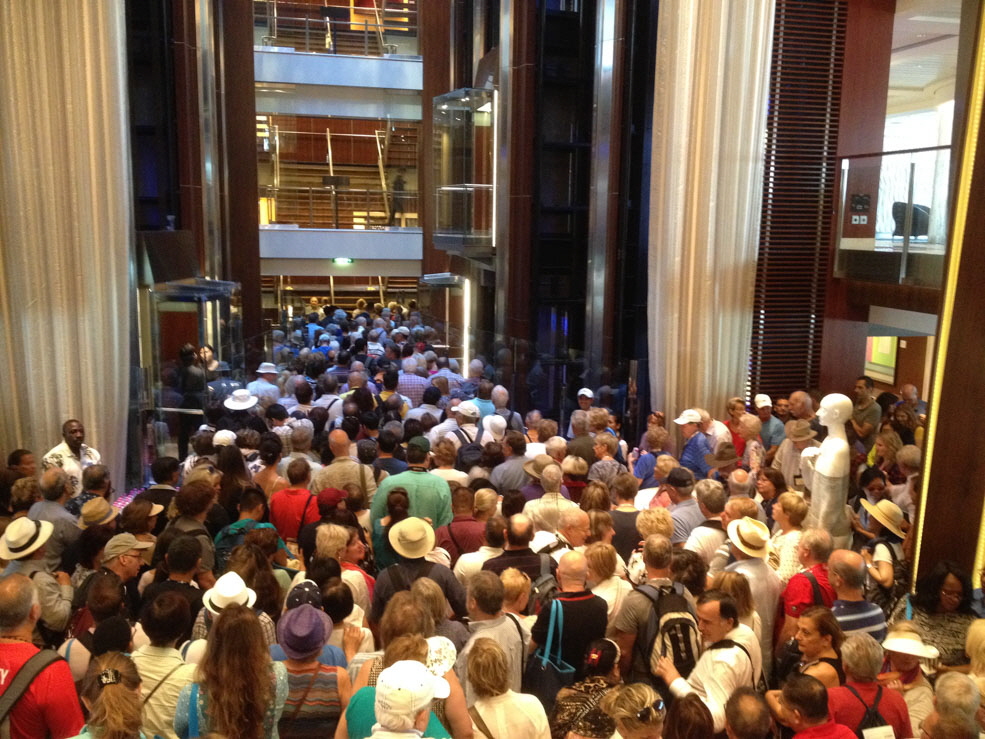
Most of the people took it with a sense of humor. Some Americans (Texans, actually), imitated mooing cattle and made for a good laugh. In fact, the whole thing only turned into a nuisance when more than an hour had passed. Repeated apologies were made via the PA system. Apparently, the Israeli authorities had decided to subject the ship to a “full screening”. As if that weren’t enough... When they finally issued the release, EVERY passenger had to have their items X-rayed at the exit and pass the scanner. And we still hadn’t seen the end of it. At the exit, both at the beginning and end of the gangway they controlled every passport again and half of the guests had to open their bags. 4000 people wanted to leave the ship, due to different screenings, groups were separated and, once released, had to find their relatives and friends on the pier again among masses of people and countless buses.
We had to find each other, too, as Birgit had to open her bag again and I was vehemently prevented from going with her. It was simply chaotic.
I felt so bad for Celebrity and their staff. They tried their best, were supportive wherever they could, and they were bawled out by guests worried about their excursions as well as Israeli border guards, while really nothing of all this was their fault.
At some stage, Birgit and I found each other again and managed to grab a cab at a taxi stand.
The address of Albar car (Thrifty/Dollar), one of Israel’s largest rental companies, was on my voucher. That’s where we asked to be taken. But the friendly driver offered to take us all the way to Jerusalem and give us a private tour of Jerusalem – for approximately USD 230.00. Not a bad price compared to the group excursions we had seen on offer. But we had already made other plans. He didn’t mind, and we chatted about the situation in Israel and how the people here dealt with it. Amazing how casual people can become towards belligerence. Inconceivable to us in our sheltered world.
When we arrived at the address, we paid the driver and went straight to the building which looked exactly like the address as I had seen it on Street View prior to the trip. A rather run down shop in a very orthodox neighborhood.
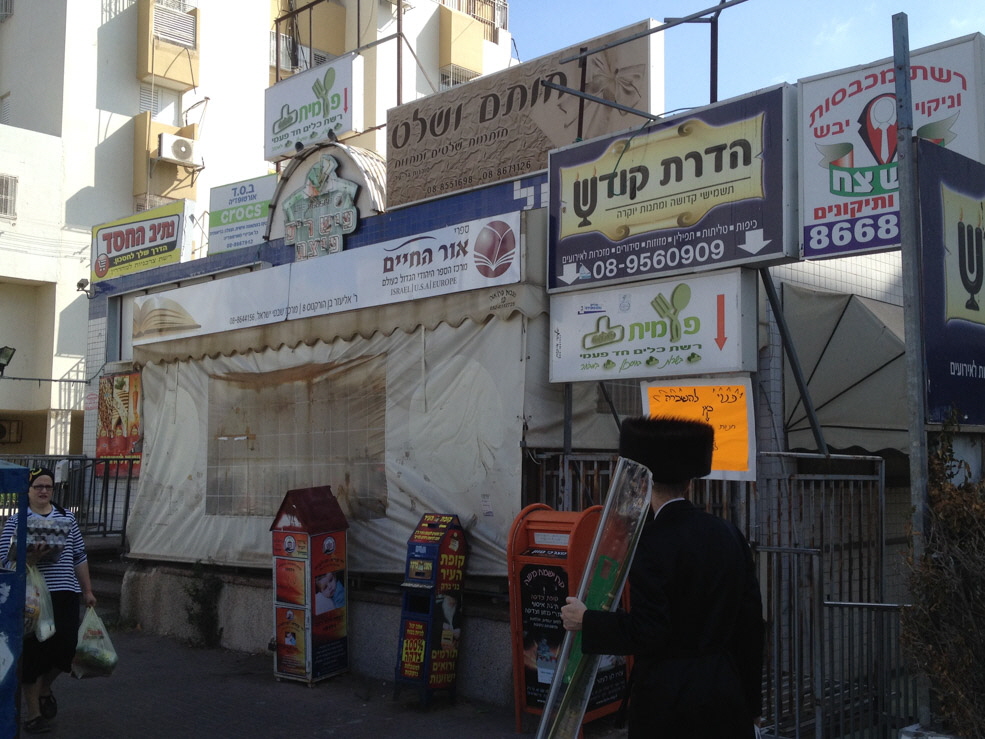
Unfortunately, all we found in the corridors was a windowless grocery store and closed, empty rooms. We asked a few passers-by, but neither could they speak English, nor could they read the voucher with the company name written in Western letters.
After a while, a youngster came towards us, all cool and rowdy. But much to our surprise he pulled out his cell phone, called the rental company and told us that they had only recently moved to the main branch in the center of town. He then called us a taxi, said goodbye, turned around and left. We had to smile as he seemed as if he really didn’t want to come across as friendly or even helpful.
The taxi took us to the main branch. A huge compound with hundreds of cars, waving flags and a large building – so we thought, we were finally on track. Not a bit of it. Please excuse the details of the following story, but the experience we had might just as well have been the script of a slapstick movie.
We entered the building where customers were already being served by staff at a couple of desks. So we waited for our turn on a leather sofa in a corner of the room. The customers kept looking at the staff’s computer screens, talked to them and chatted (in Hebrew) and every now and then I heard something like “a million shekels”. And at some point it dawned on me that this was about selling cars.
I looked around in the corridors and found an office with a large counter. Seated behind the counter were three young, attractive girls. One of them was on the phone, most likely a private call judging by her pink Iphone, the next contemplated her stylishly decorated nails and the third was writing a text message. The fourth chair was empty. I entered and asked whether this was the car rental. Visibly annoyed that I had interrupted their very important doings they looked at me and one of them pointed at the fourth seat – the empty one next to her. That’s when she realized it was empty and she probably had to deal with it. Grudgingly she took my voucher and began to study it. Meanwhile I took out my passport, my credit card and my driver’s license and put everything right in the middle of the counter.
Eventually she asked for my passport. I pointed at the one on the counter. She took the passport in one hand and with the other took out the landing card. Then she flicked through the passport and grumbled “I need your landing card!” I pointed at her left hand and thought to myself “How about that one?” Grumbling from her end. At some point she came across my Indian visa in my passport. Again grumpy, “You are from India?!” “No, this is a German passport with an Indian visa.”
“I need driver’s license” was her next request. I pointed at the one on the counter. She studied the driver’s license with a blank expression. I could swear I heard gears rattle and saw clouds of smoke rise above her head. Helpless, she interrupted the other gracefulness on the phone and the third one looked up from her nails, too. All three discussed the driver’s license which they twisted and turned in complete cluelessness. At some point one screamed into the corridor: “Haim.... Haaaiiiimmmmm!” Haim, a young man, entered the room. After a few purring words and fluttered eyelashes from the girls, Haim explained the driver’s license to them. Haim left the room, and the sweet smiles abruptly left the faces of the ladies, who just as fast turned into Medusas again.
“Do you have telephone in Israel?” “Yes, my cell phone” I replied pointing at my phone. “This in Israel?” “Yes, my good woman, unless this isn’t Israel”, I thought to myself but remained friendly. Then she wanted me to write my number on a piece of paper. OK, I wrote +49 173 ... and gave her the paper. Outraged she showed it to her colleague and asked what in heaven’s name +49 could possibly mean. “This is not phone number in Israel!” “No, but it’s my telephone number and I happen to be in Israel...” Next she wanted me to call her phone. Since I didnt’ know the number I handed her my phone and let her dial. All three girls closely watched the display of the phone - which actually started to ring - and were completely amazed that it showed +49 173 ... Stunned, they compared the number on the piece of paper with the number on the display and finally decided to simply enter 0000000 into the computer.
Now she got really productive and completed the paperwork. She wanted to explain something in English to me but noticed that she didn’t know the vocabulary. So she just stopped right in the middle ... why not. I asked how long they’d be open the next day and she replied “6 o’ clock”. OK, I pointed at the voucher and the fact that it said 5.30 pm on it. “No, no, 6 o’ clock”. Great, so we had 30 more minutes!
Outside the building a blue Mazda 3 waited for us, and one of the starlets marked the damages in a handover form. When she was done, the whole thing looked like color by numbers since the car was basically covered with dents and scratches. Never mind, I was going to the Old Town of Jerusalem, so it was just fine with me.
Finally we sat in the car! I connected my IPhone, where I had at home downloaded an inexpensive satnav app of Israel. Since we were now leaving from a different location, I wanted to save the new address of the car rental as a waypoint for our return. Unfortunately, the satnav didn’t know the street name. OK, so in the menu I chose “Save current location as favorite” and then we took off, at last.
Via the highway and through a few traffic jams we reached Jerusalem some 1 ¾ hours later. The satnav app was seriously getting on my nerves because it broke down whenever there was a crucial waypoint. By the time it was rebooted and reset, we were obviously way past that waypoint. Never mind, we found Jerusalem. In the city we began to realize what it meant to be there during Sukkot. All the roads were blocked. To top it off, the big main road just two turns away from our hotel was closed and police were directing the traffic. Since our satnav app didn’t allow for an alternative route and always wanted to return to the roadblock – or simply kept crashing - it was totally useless. Eventually I simply went by sense of direction and gut feeling through rat runs and narrow alleys, and we reached the city walls. From there I knew how to get to our hotel: Turn right at a roundabout in front of the Herod’s Gate and you get directly to the “Holy Land Hotel Jerusalem”.
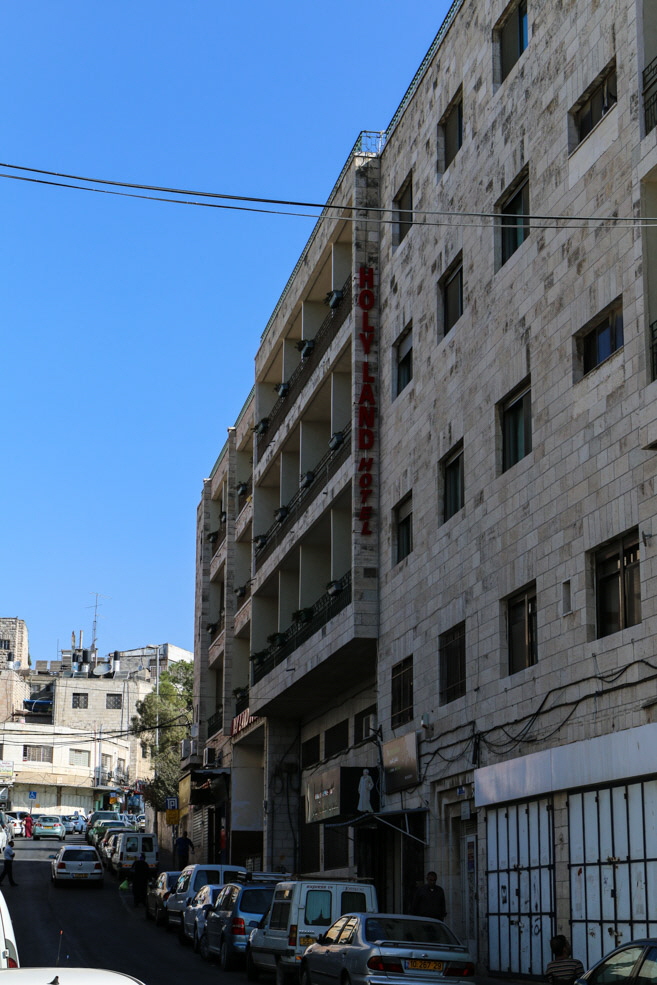
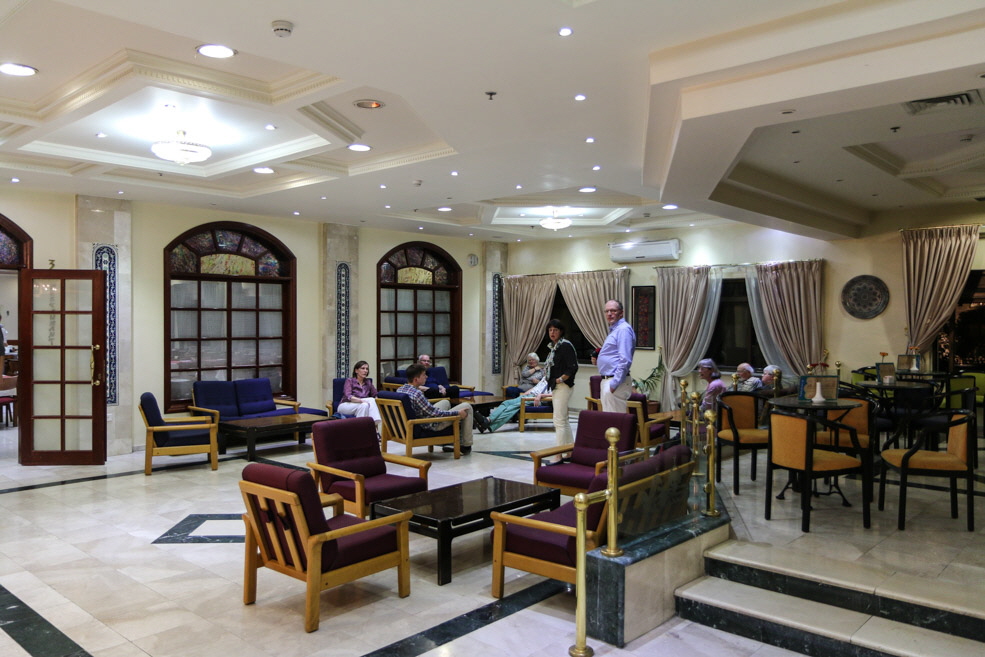
Meanwhile it was past 1.00 pm. We parked our car in the courtyard of the hotel and asked inside whether we could leave our luggage until we’d check in later. The lady asked us to wait 5 minutes, and then she gave us the key to a room which had just been cleaned. Excellent, so we were able to drop our bags, use the bathroom and just leave
From the balcony we were greeted by this view of the city walls, the Temple Mount and the golden cupola of the Dome of the Rock:
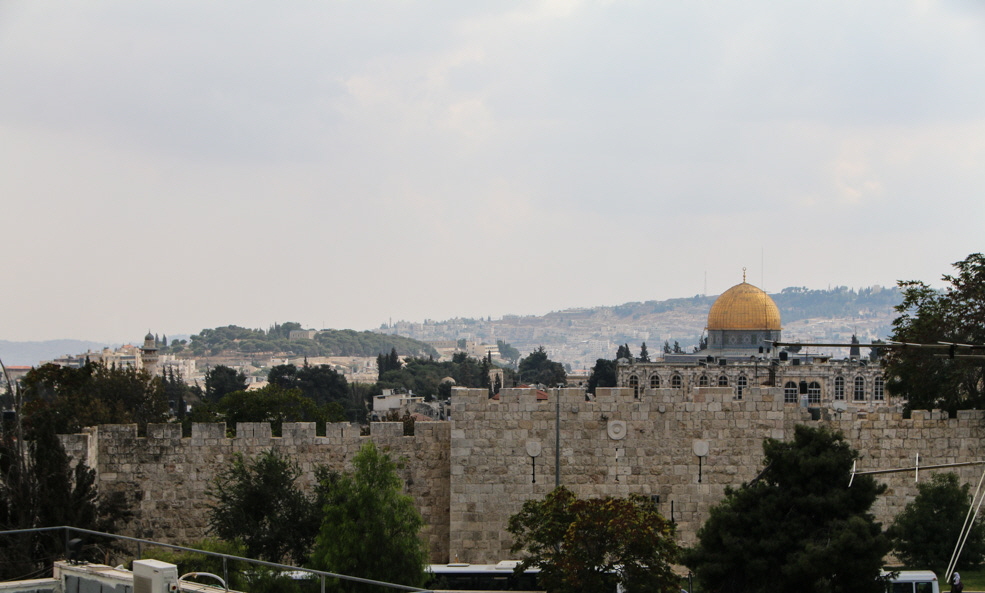
Phantastic, awesome! The location was unbeatable.
A little impatient we finally set off for our discovery tour of the Old Town. The Herod’s Gate leading to the Muslim Quarter wasn’t even two minutes away. That made it easy.
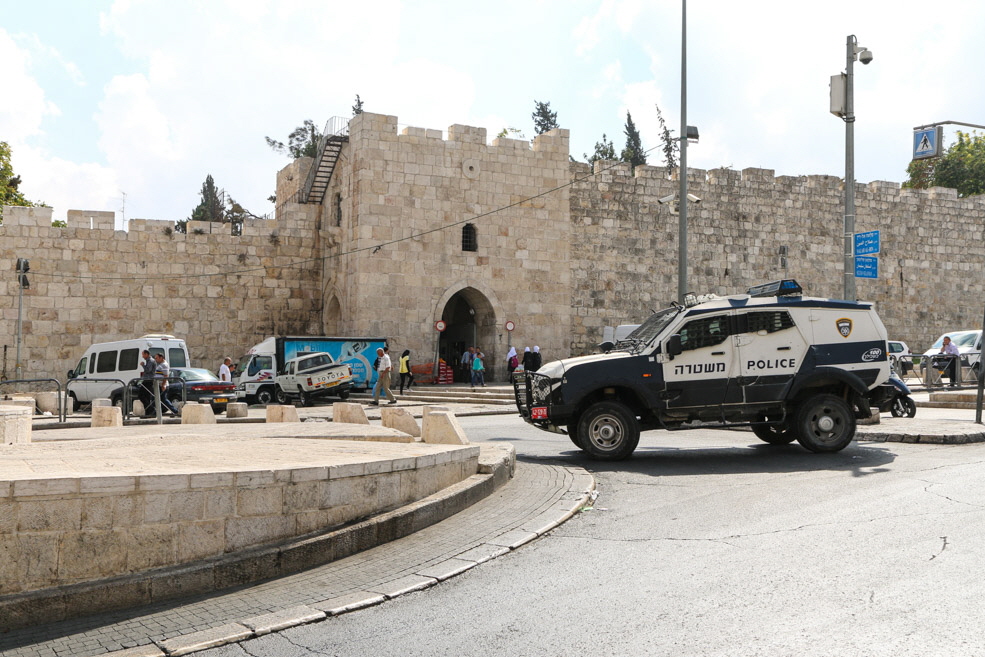
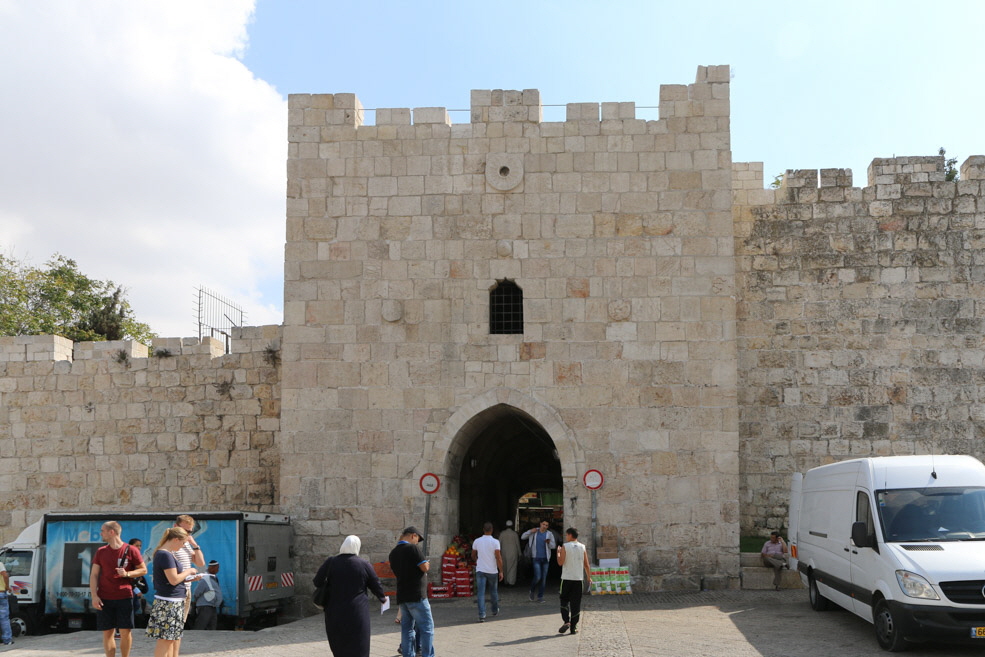
I now invite you to go with us through this gate and enter the Old Town, which seemed like a completely different world - and I hope I get anywhere near conveying the atmosphere. The narrow streets and walls, witnesses to thousands of years of conflicts and different eras of various rulers, told the stories… and we were eager to listen!
To this day, Jerusalem’s Old Town is divided into 4 different quarters: The Muslim, Jewish, Armenian and Christian Quarters. Perched above them is the Temple Mount with the Dome of the Rocks and its golden cupola visible from afar, as well as the Al-Aqsa Mosque. There are no borders, but if you turn around a corner from one quarter to the next, everything changes abruptly. Language, people, clothes, impressions, buildings – everything is different. It is a completely fascinating experience.
The ubiquitous presence of the heavily armed police in riot gear on almost every corner testified, however, that the calm was deceptive.
Through the Herod’s Gate we entered the Muslim Quarter. These photos could just as well have been taken in an Arabic country. Indeed, everything here was Arabic. The shops, the language and also the clothes of most of the men and women.
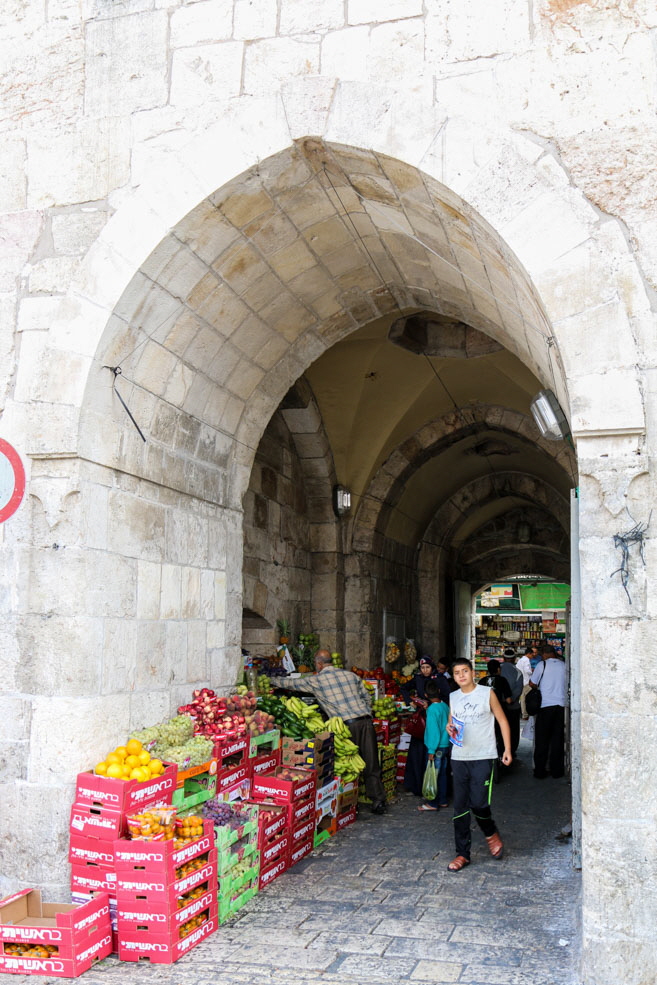
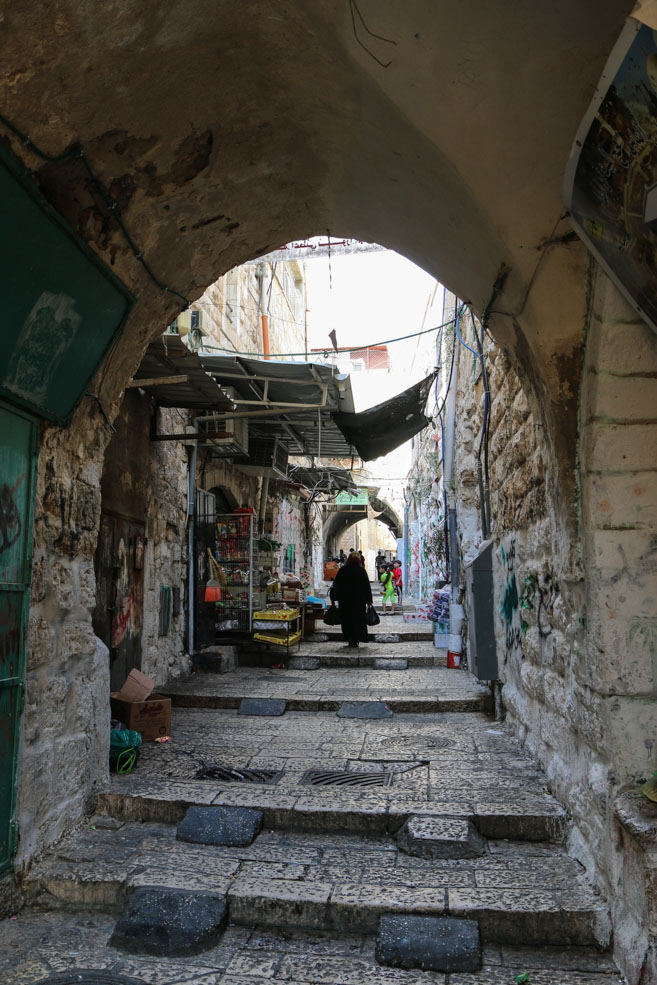
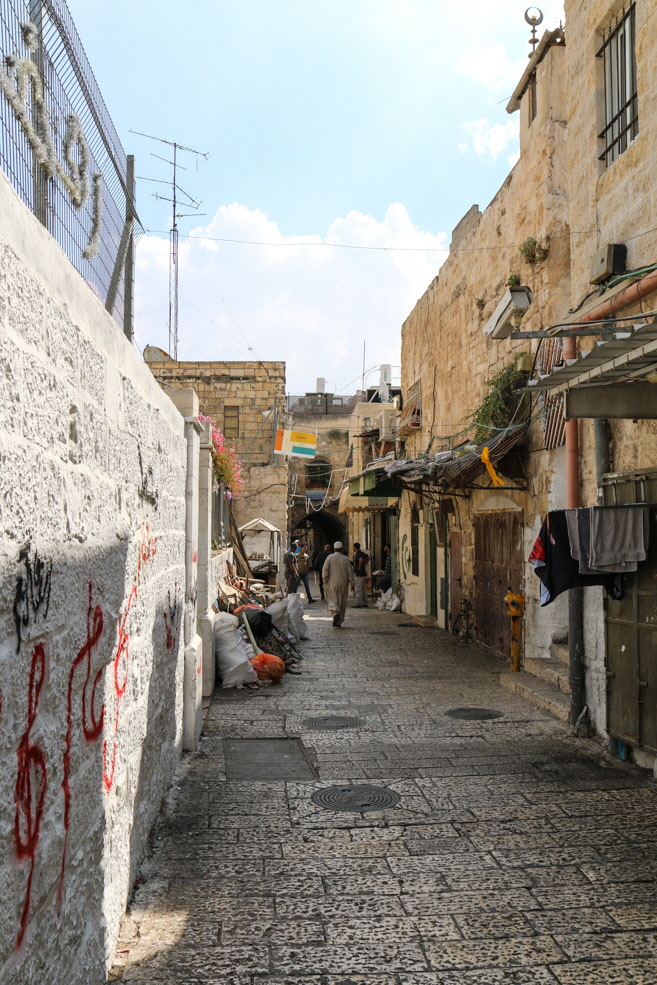
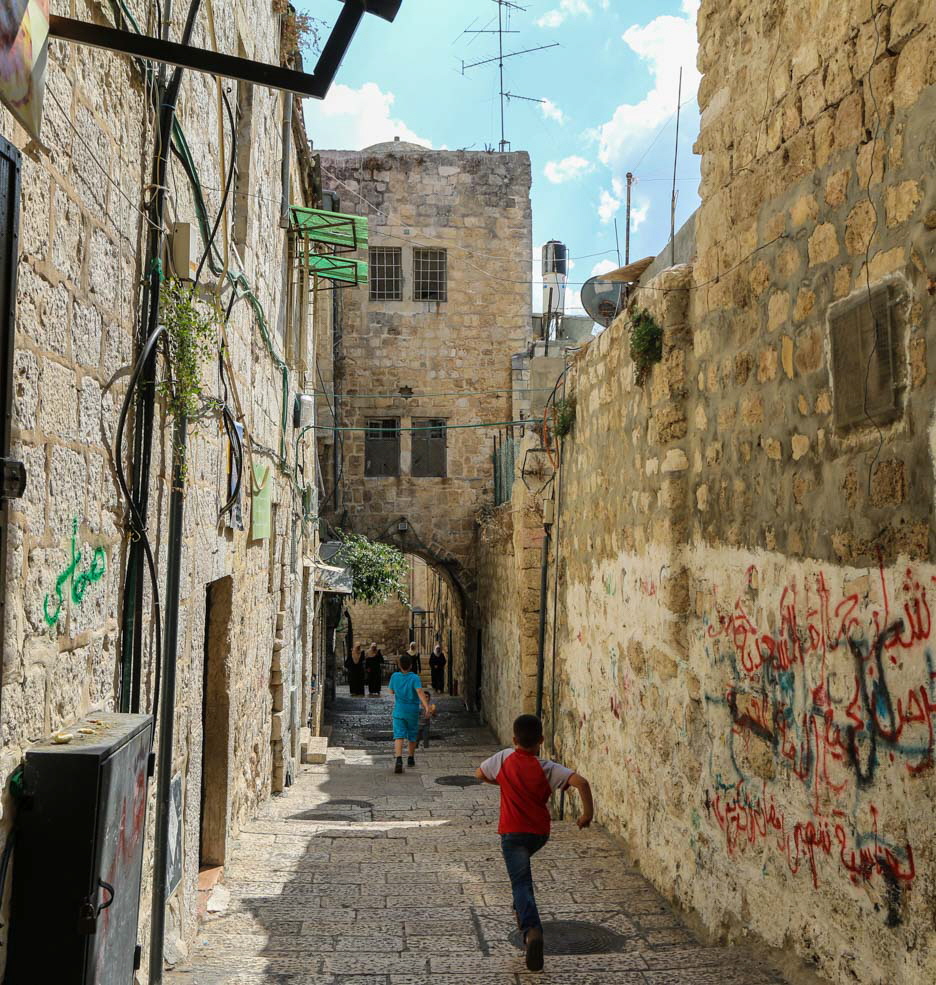
We followed the streets a little downhill and soon reached the Via Dolorosa – the “way of the cross”.
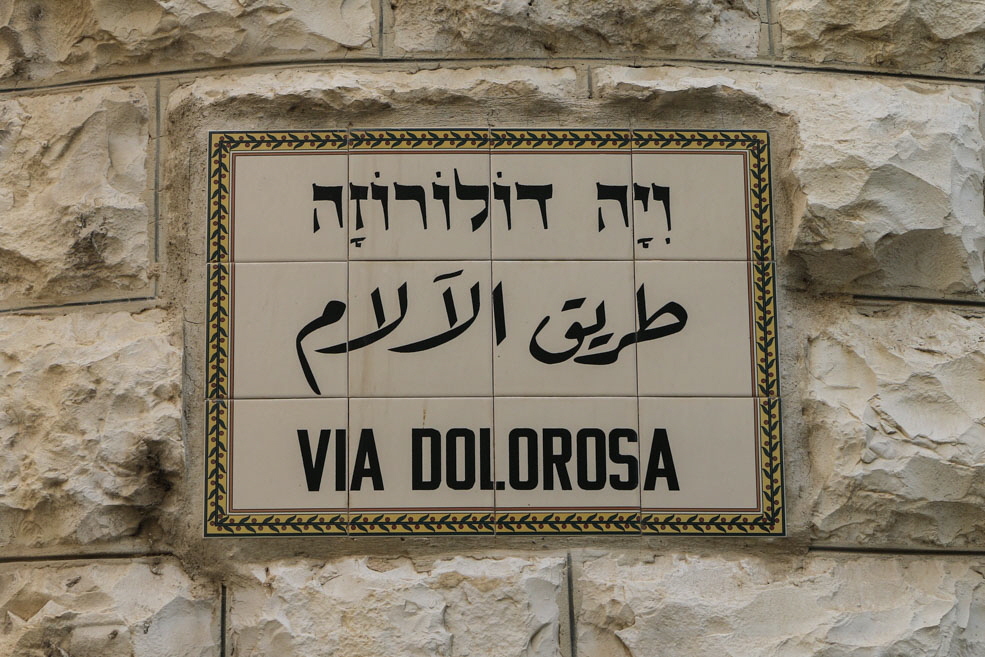
The Via Dolorosa is held to be the last path that Jesus walked, i. e. his last walk from condemnation and flagellation to his crucifixion. The stations of his suffering are marked on buildings; some are also described on plaques. I had previously downloaded a free app which provided an audio tour along the way.
First I should say that I am not a believer myself and left the church a long time ago. Therefore, my explanations aren’t based on my conviction but on what has been passed down. Believer or not, I followed the stations with interest and fascination.
The first stations were the condemnation and the flagellation. They are said to have taken place in the Antonia Fortress which is purported to have stood at the site which is now home to the “churches of condemnation and flagellation”.
You can reach these sites through a little gate on Via Dolorosa.
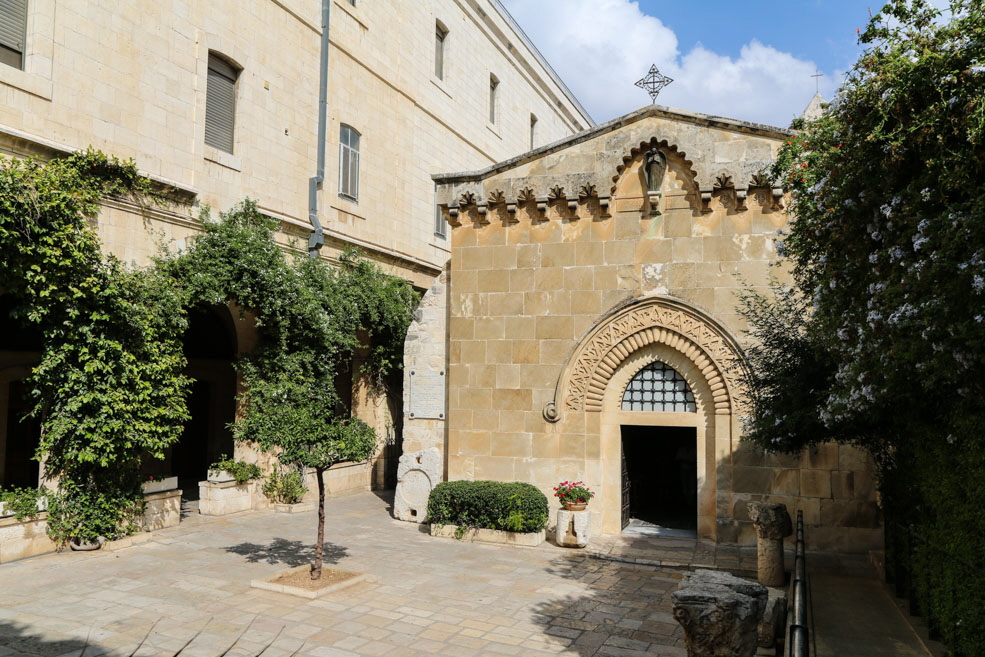
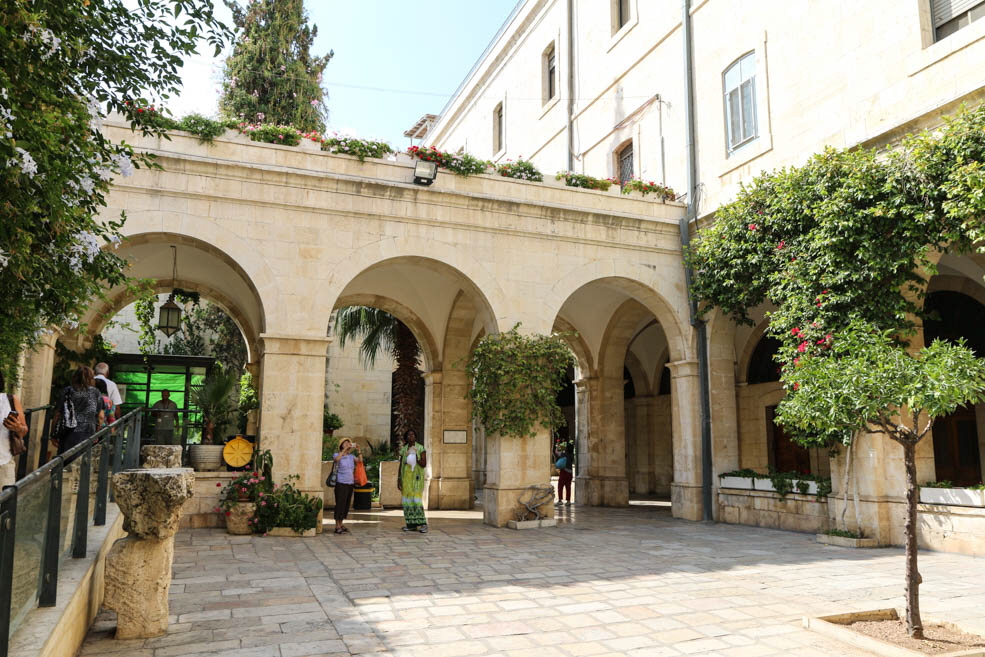
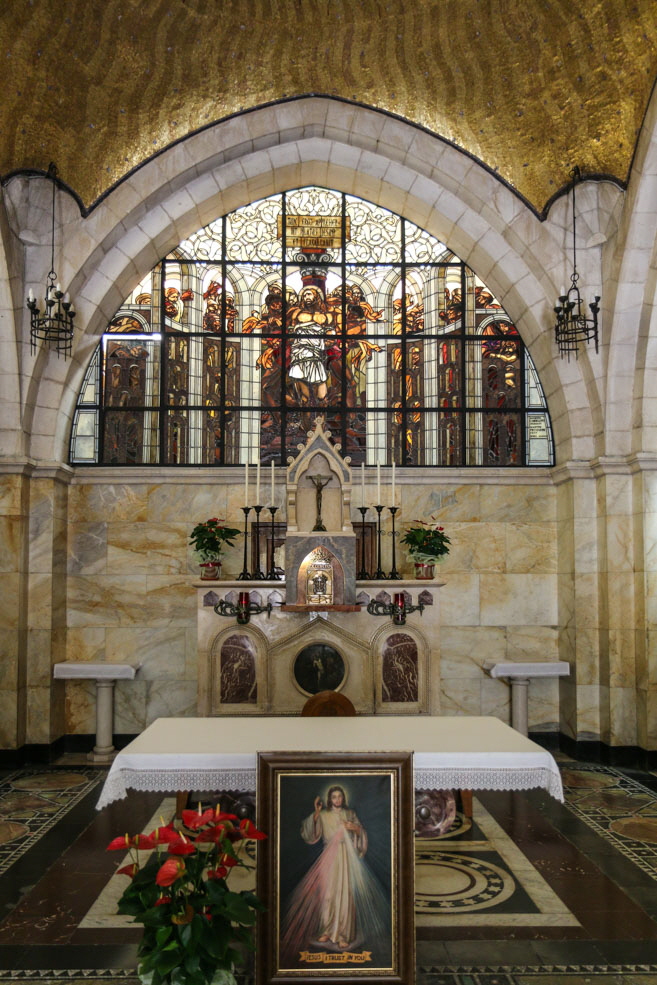
The next station is the Ecce-Homo Arch („Ecce homo“ = “Behold, the man”). This is where, according to tradition, Pilate presented the tortured Jesus to the people.
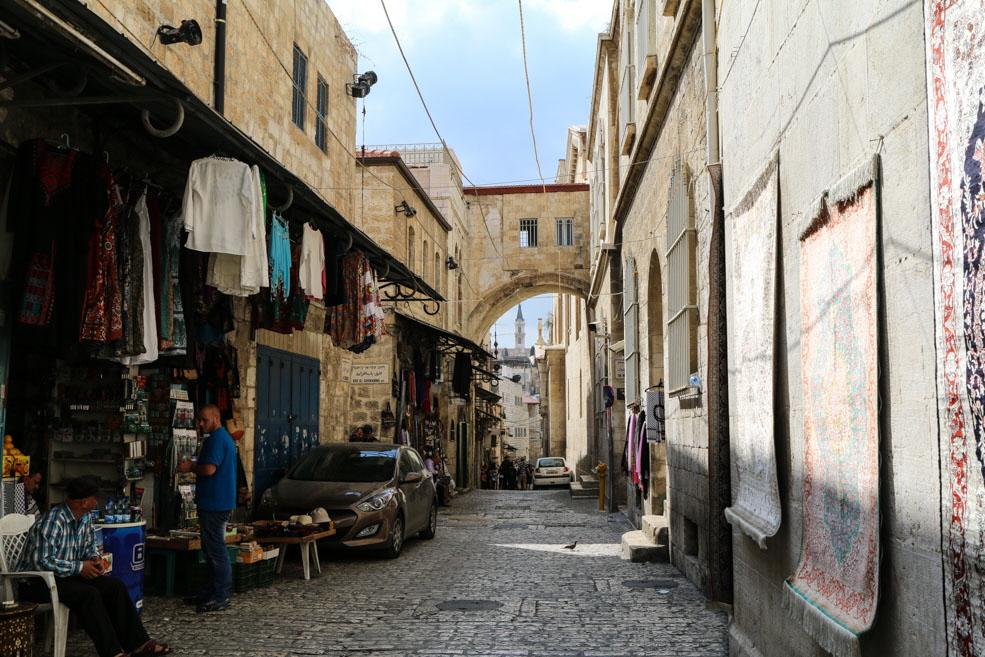
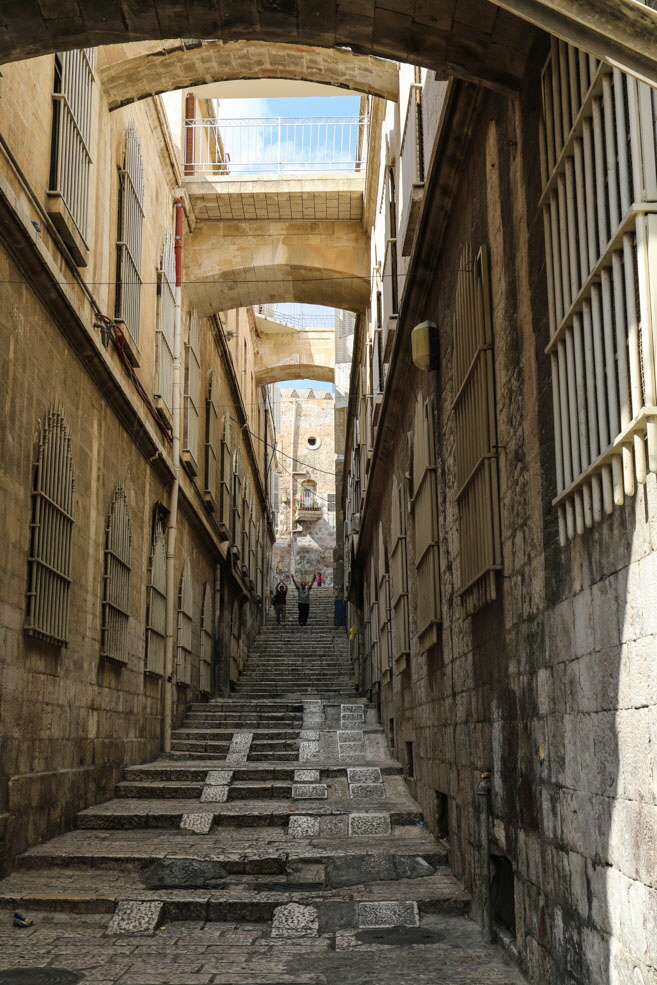
A little further along Via Dolorosa you reach Station 3, where Jesus is said to have collapsed under the cross. A little chapel at this site bears witness to it. The chapel almost seamlessly merges into the fourth station, today another church, where Jesus is said to have met Mary who stood on the side watching her son in agony.
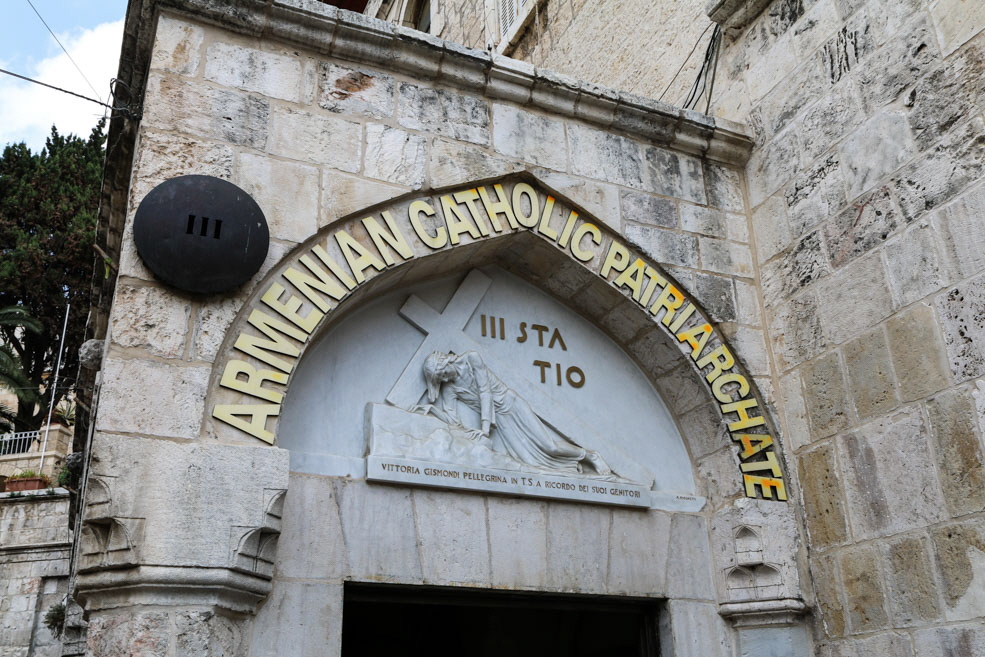
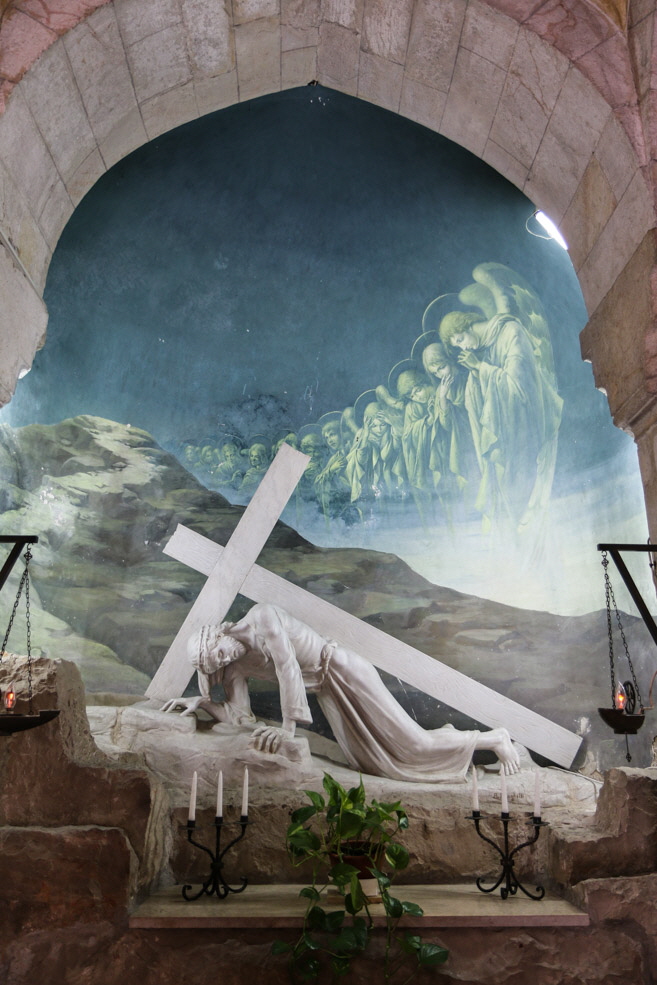
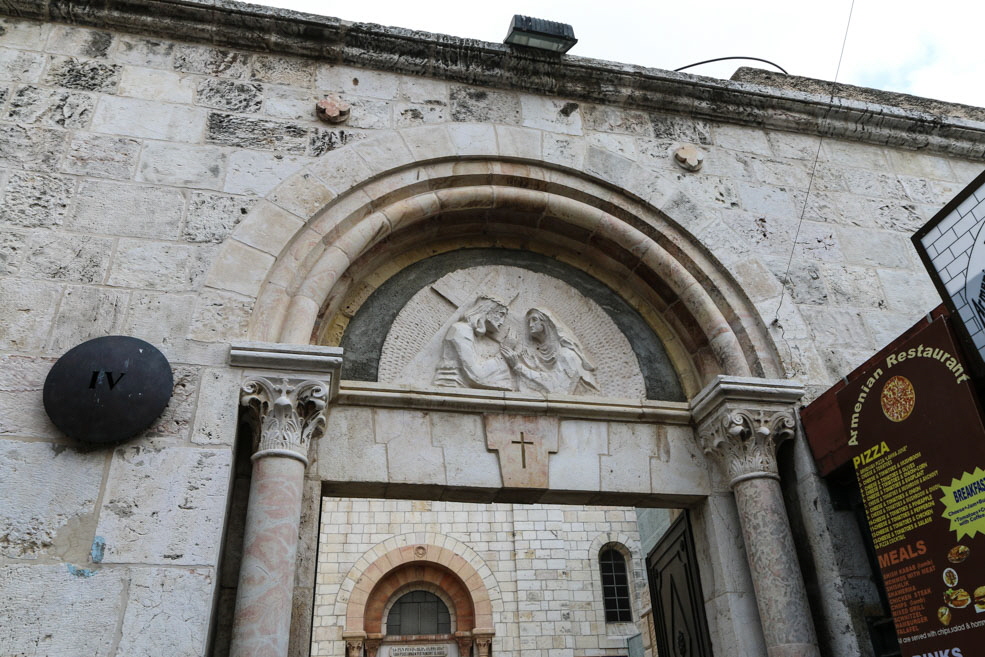
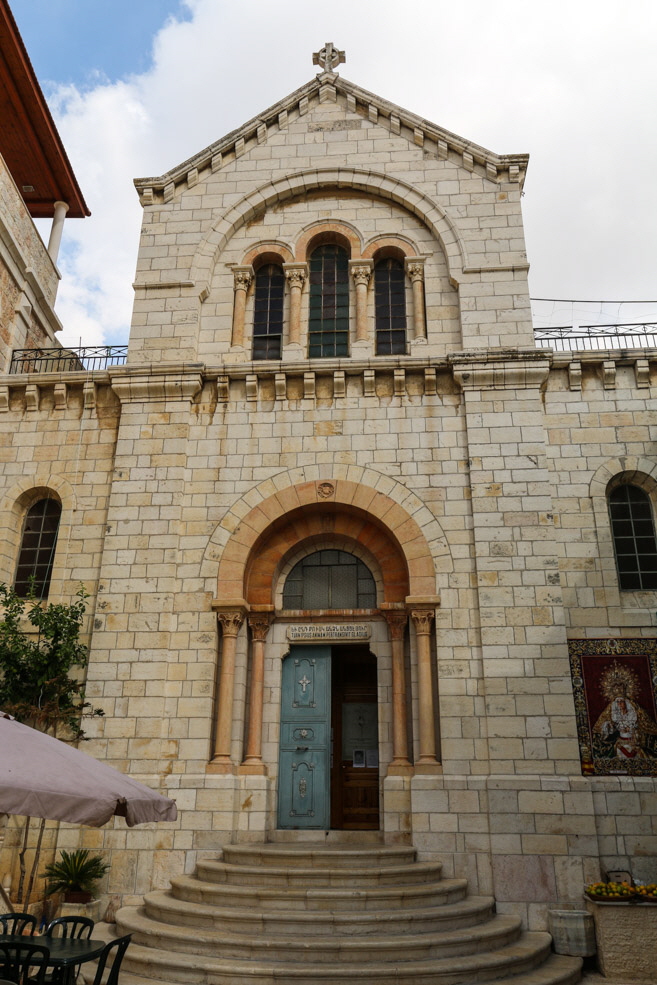
The crypt below the chapel is decorated with a Byzantine floor mosaic from the 4th – 6th century, and they say the footprints are Mary’s.
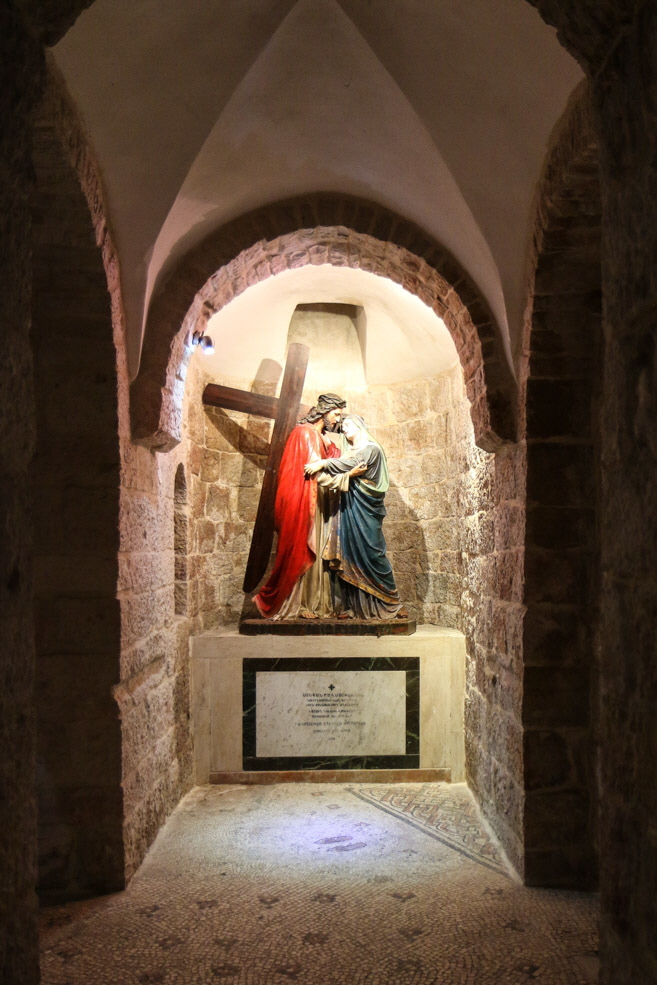
Further along Via Dolorosa you’ll reach Station 5, where according to tradition Jesus collapsed again. This station refers to the biblical episode in which Simon of Cyrene takes Jesus' cross, and carries it for him
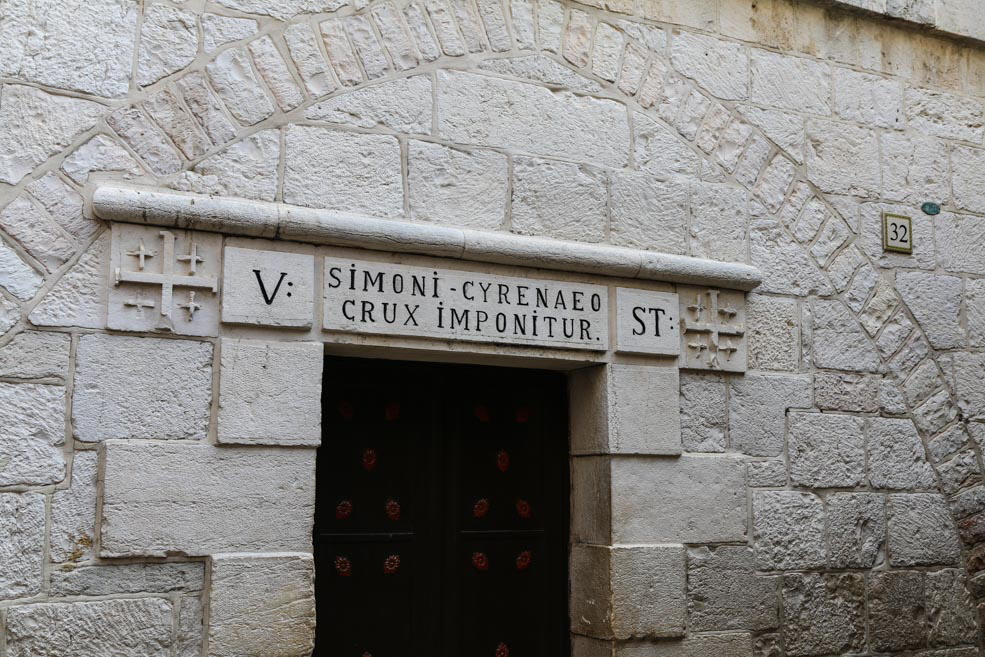
A brick in the wall marks the spot where Jesus apparently supported himself against the wall. For centuries, pilgrims have touched this spot and thereby continued to cave it.
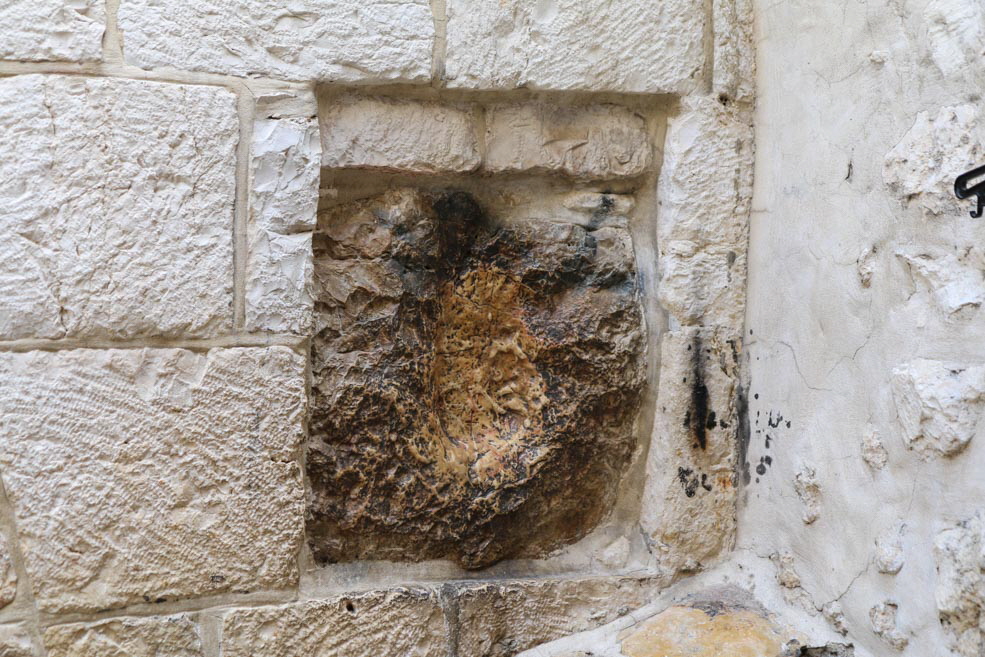
Here, Via Dolorosa makes a turn into an Arab souk.
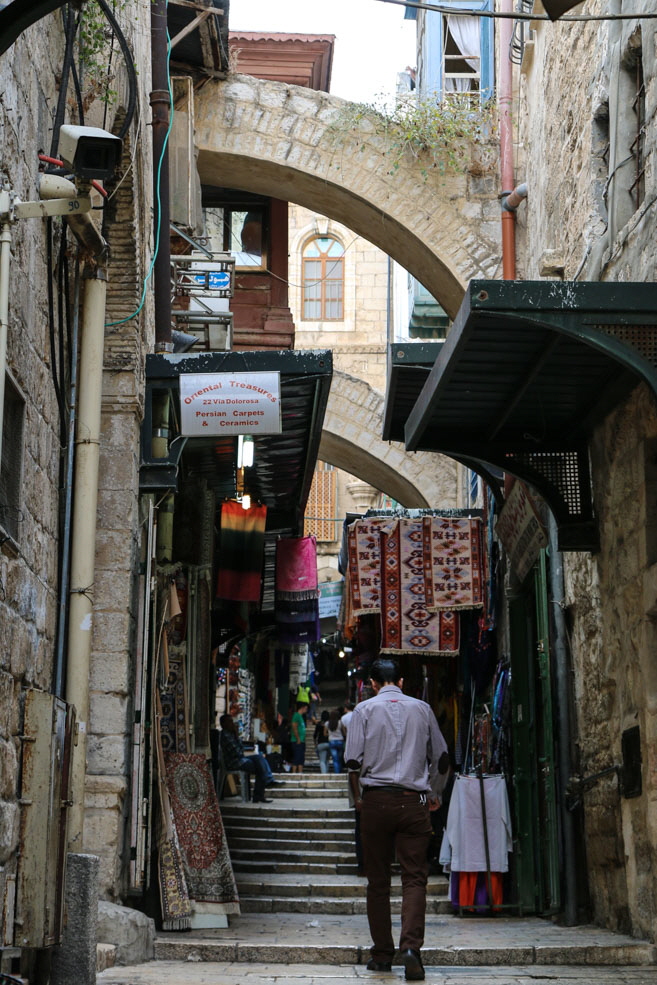
We didn’t follow Via Dolorosa at this point but continued straight ahead towards the Wailing Wall, also called Western Wall.
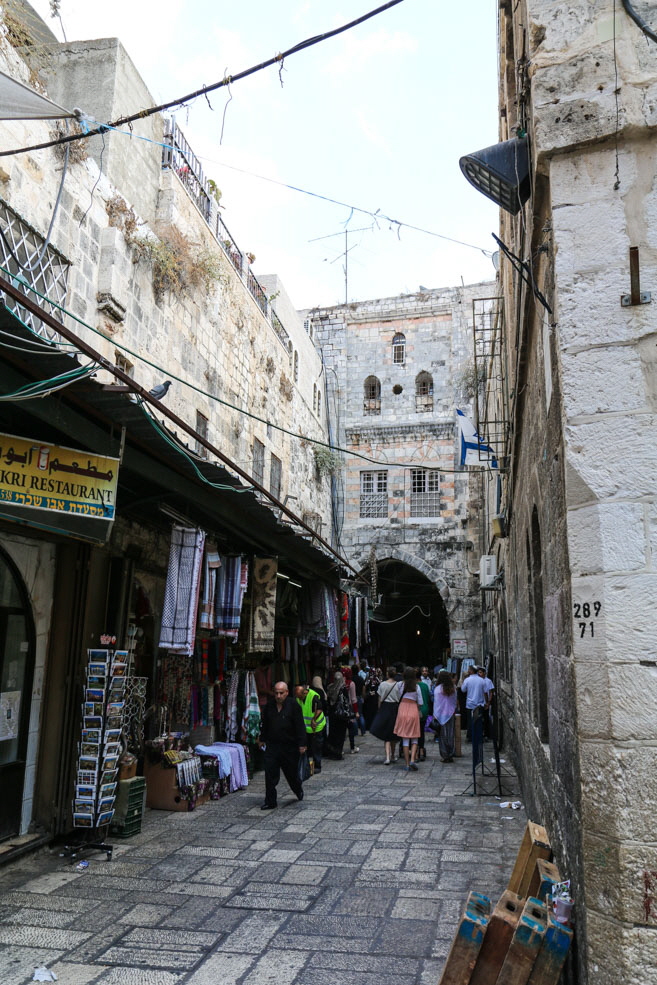
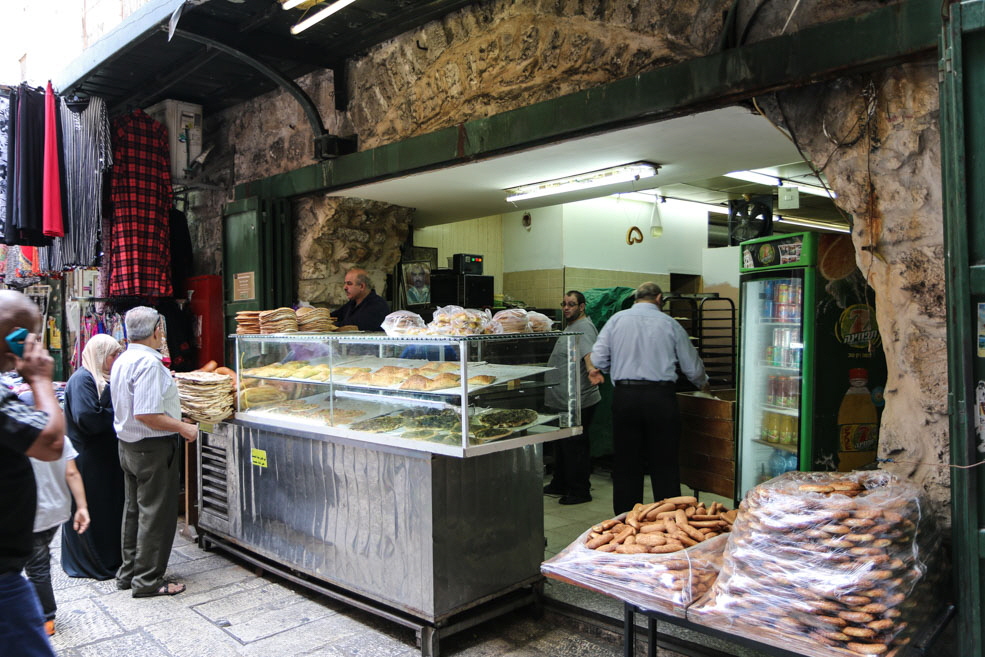
On either side we found more market halls and more souks.
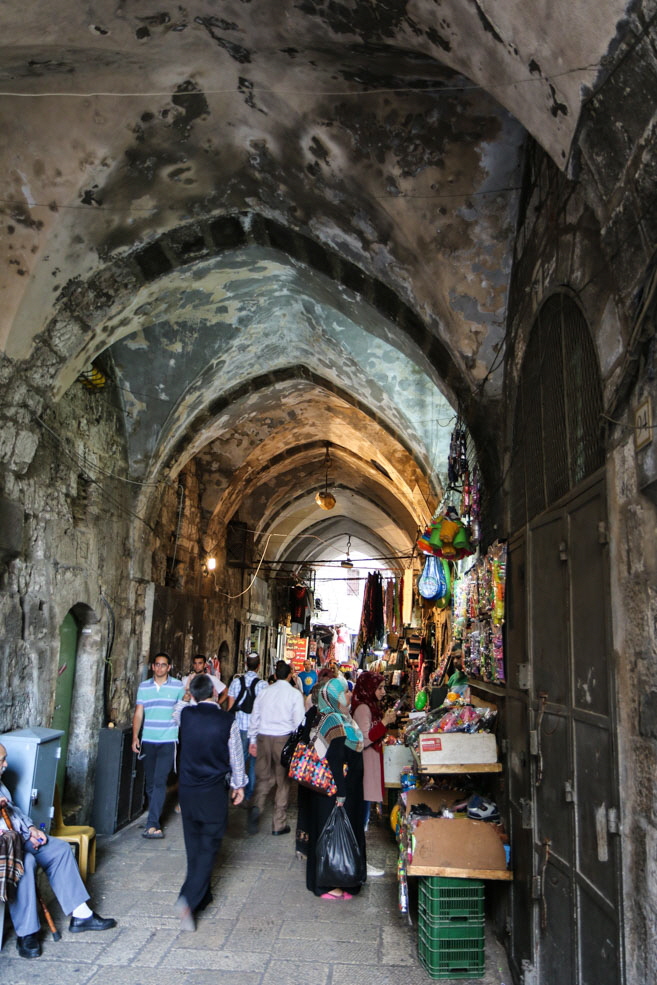
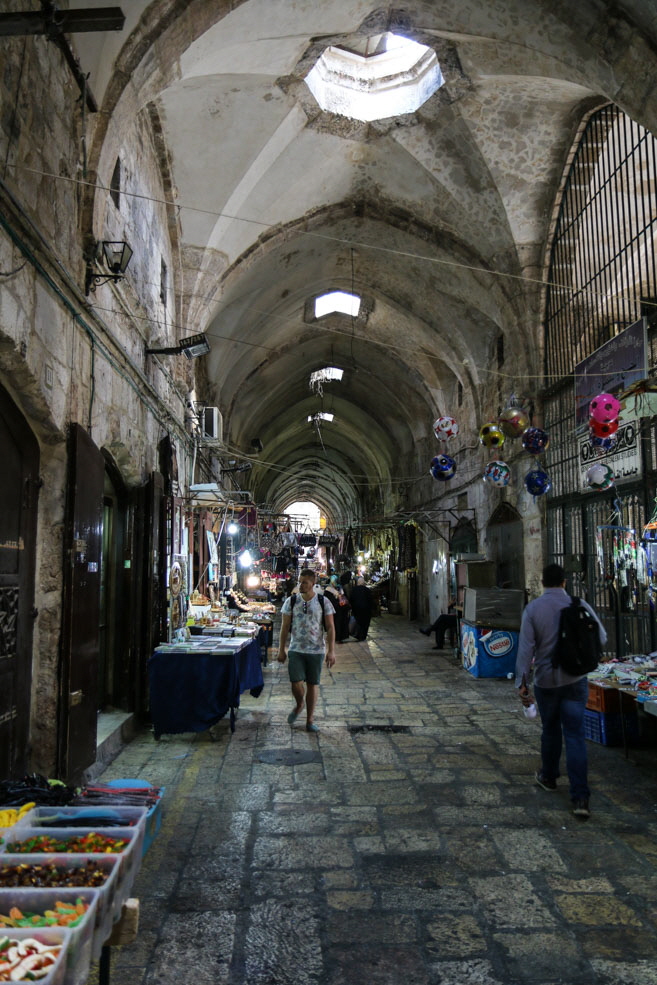
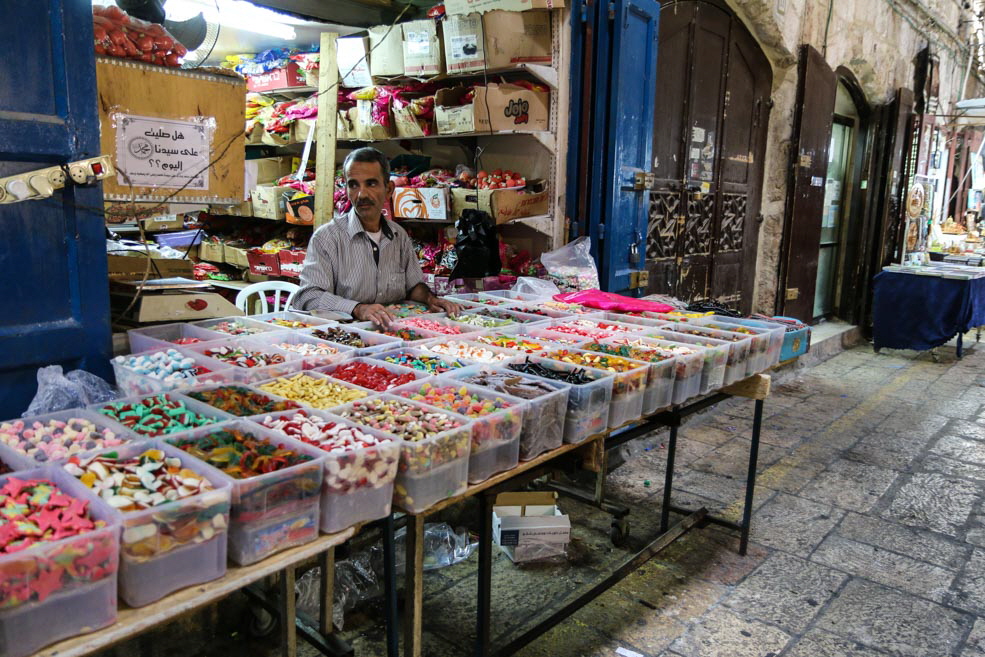
Through a tunnel and a security checkpoint with X-ray scans you get directly to the Western Wall Plaza – the square in front of the Wailing Wall – and therefore the Jewish Quarter.
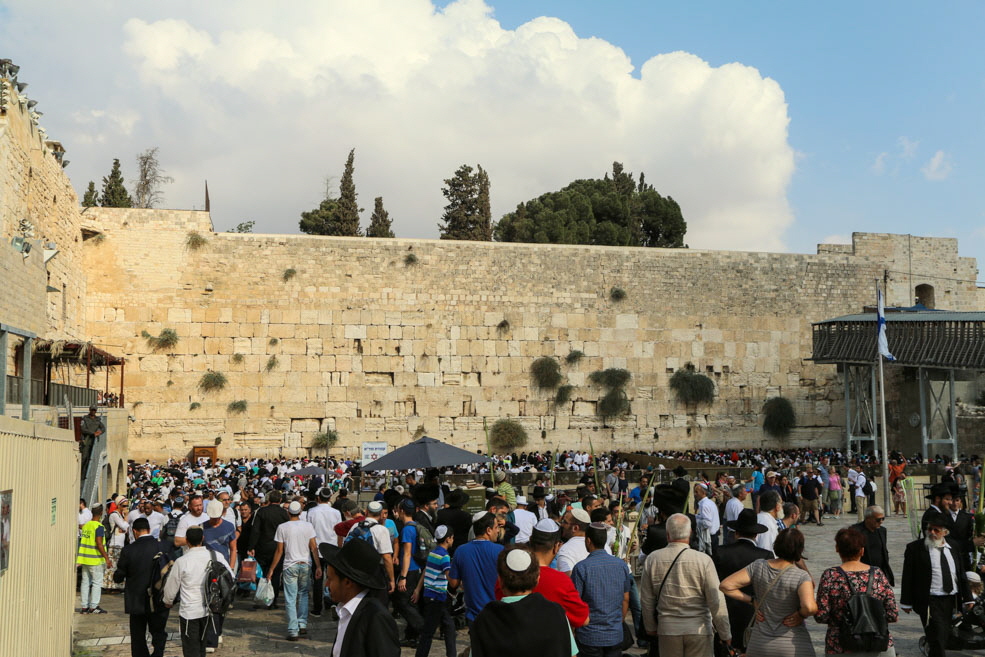
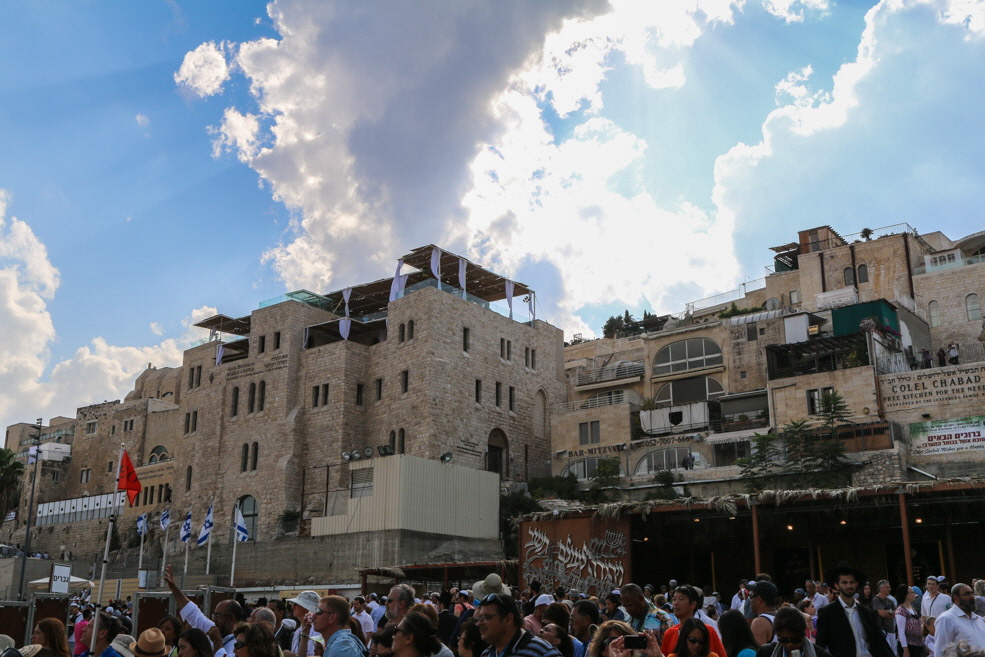
Due to the Sukkot Festival, this Jewish pilgrimage site was extremely busy and many Jews were dressed in their festive apparel.
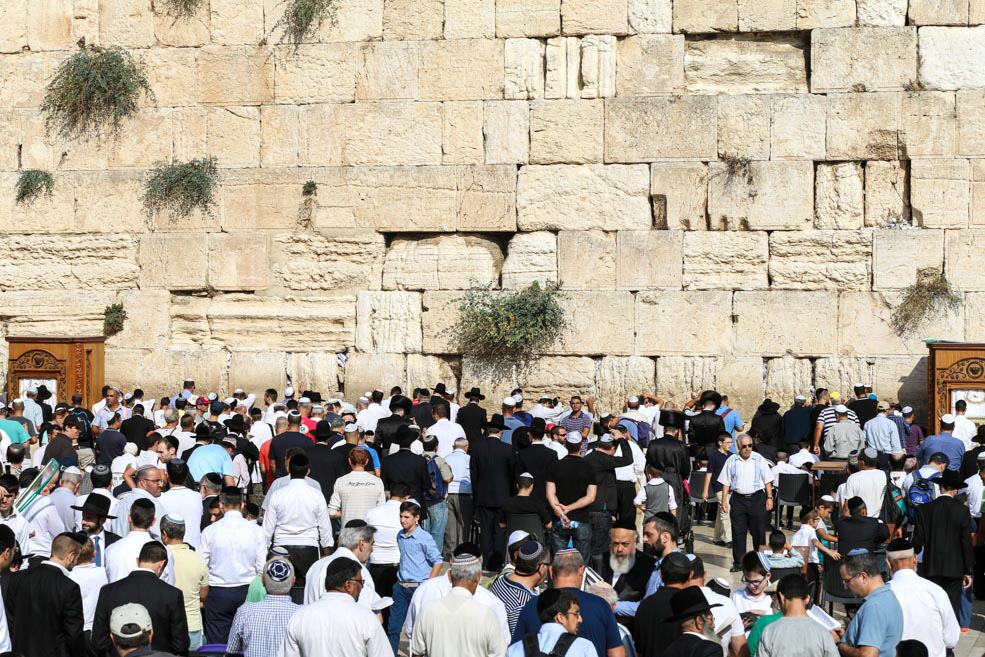
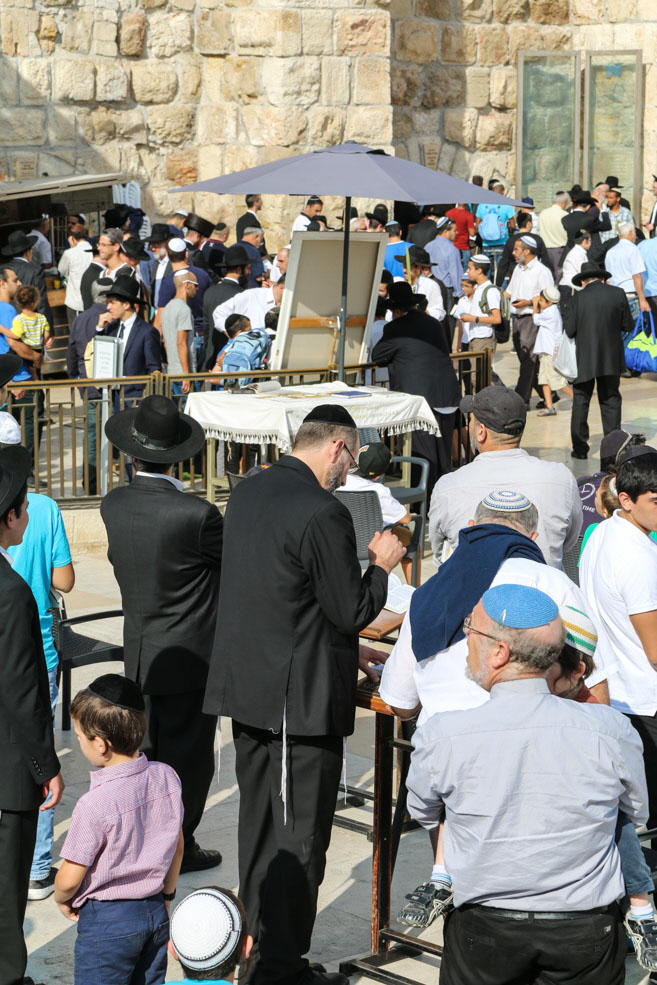
Particularly striking were the Hasidic Jews with their big fur hats called the Shtreimel.
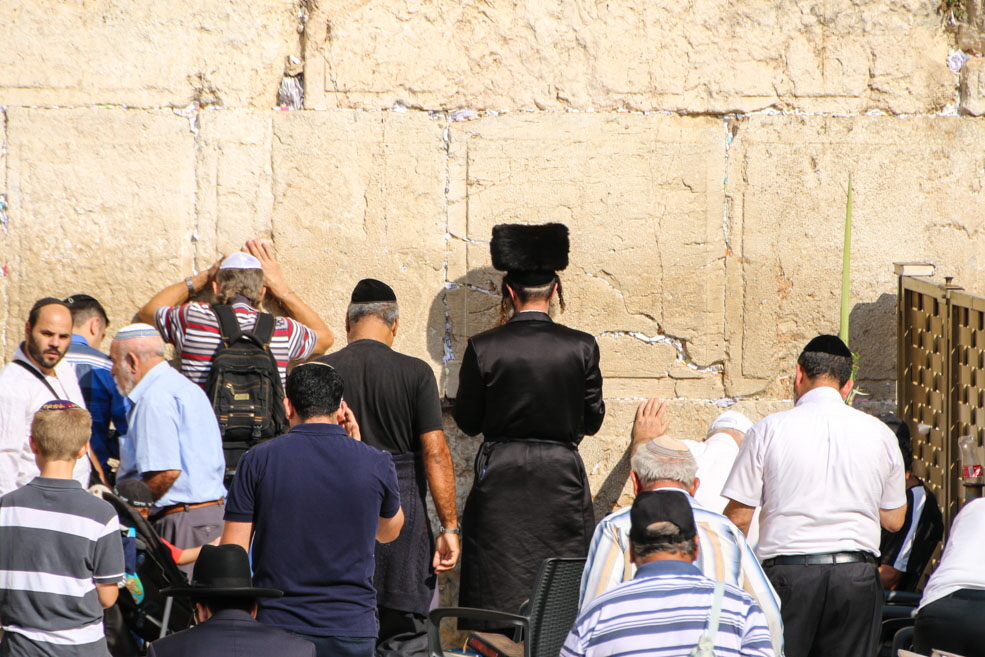
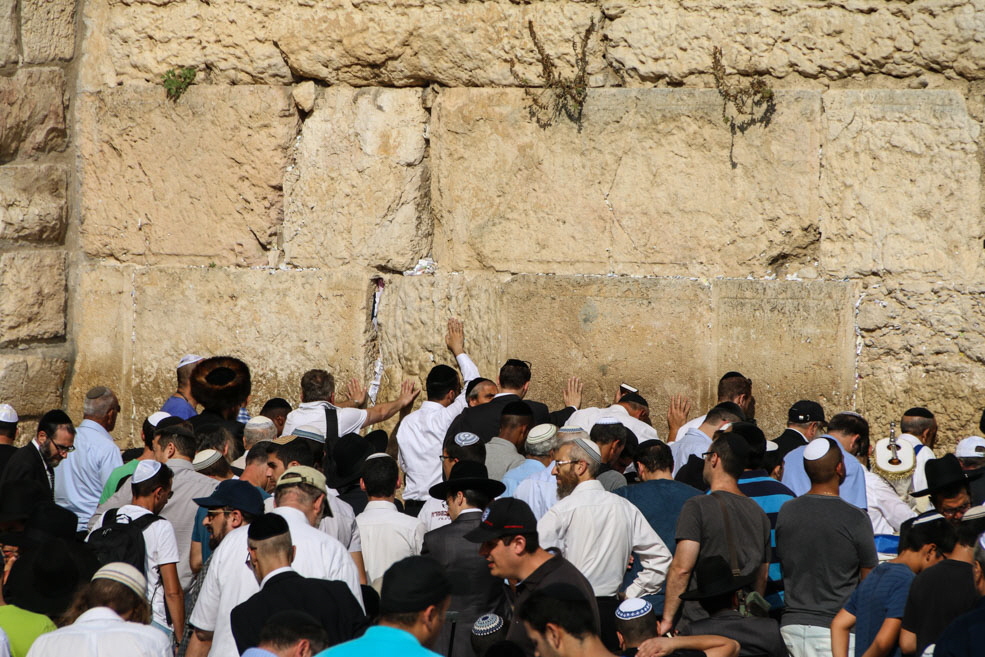
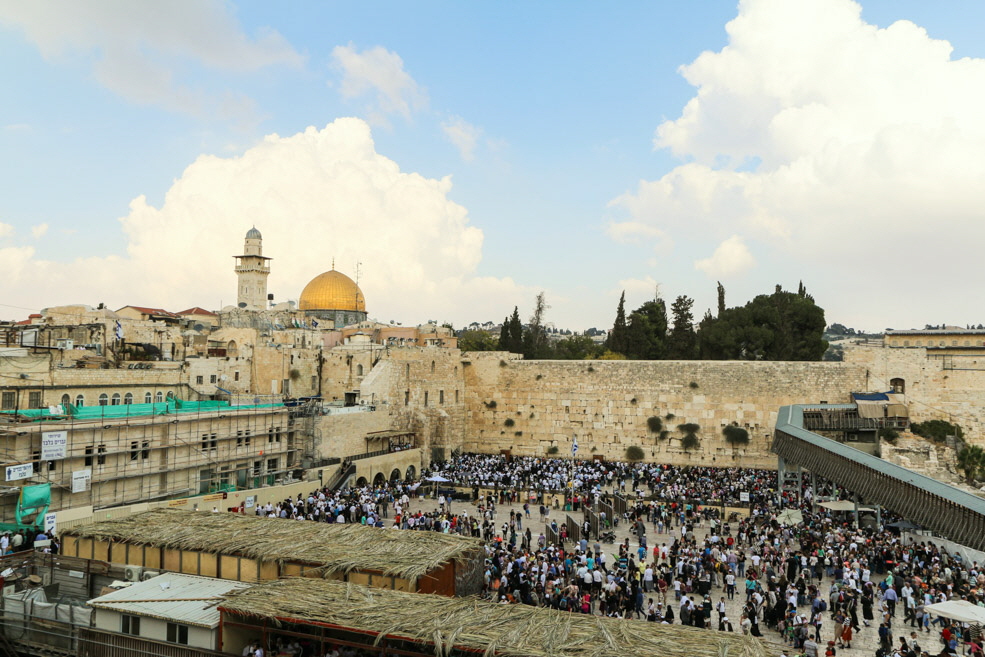
The Wailing Wall, a most holy site in Judaism, is the retaining wall on the western side of the Temple Mount, home to the Dome of the Rock and the Al-Aqsa Mosque, which, in turn, are highly important sites for Muslims.
To the right you can see the Mughrabi Bridge, the only access to the Temple Mount for non-Muslims. In its place, until 2004, there was an earth ramp which was destroyed during an earth quake. The bridge was built as a provisional solution. In order to build a new, final replacement, the remnants of the mound were eroded in 2007 and archaeological examinations were carried out. Israel’s way to proceed was strongly criticized, and Arab states threatened with war, insinuating that with those works Israel only wanted the Mosque to collapse. Since then, there have always been disputes regarding the bridge and the Temple Mount, and peace is a very fragile affair.
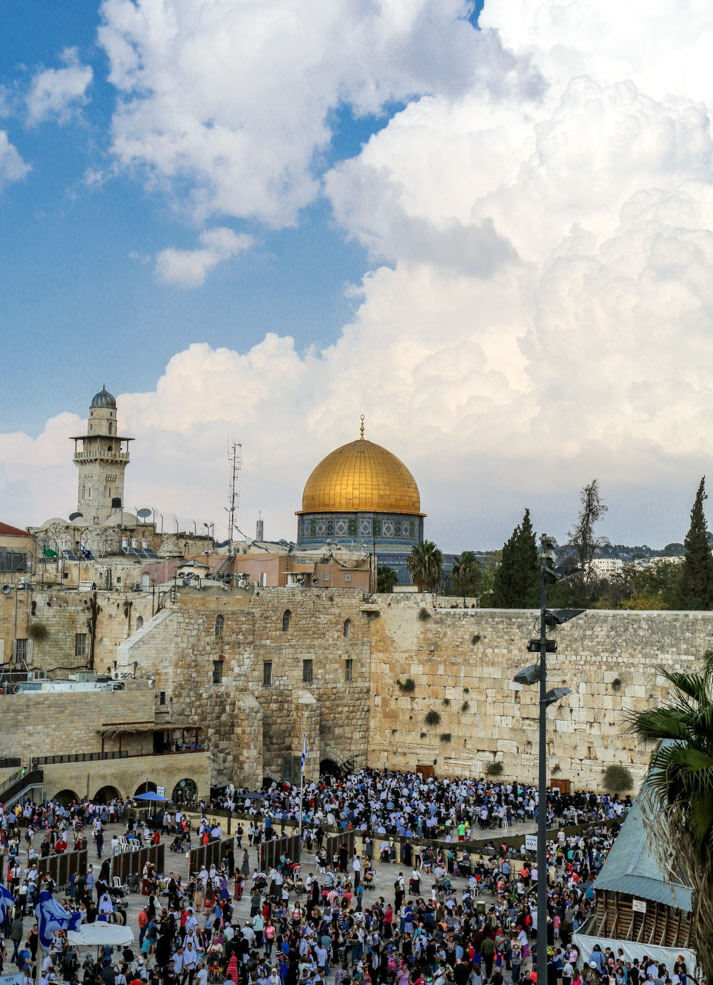
We climbed a few steps towards the Jewish Quarter and braced ourselves at a little snack stall.
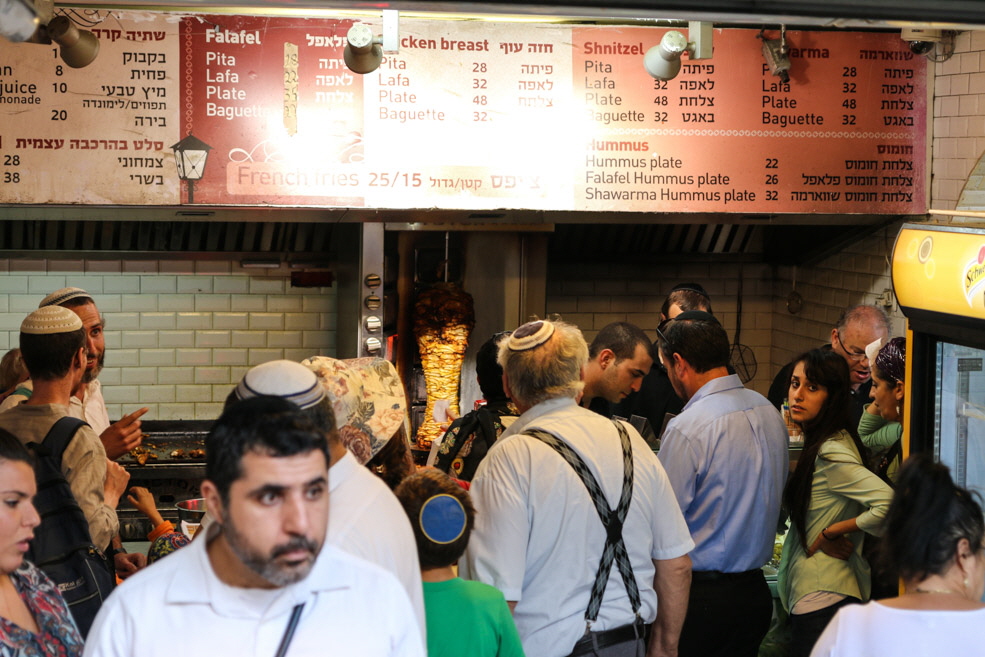
Coincidentally, we bumped into Bob and Debby from the ship, who had taken a guide to show them Jerusalem.
Hurva Square, a big square around the Hurva-Synagogue, is another center of the Jewish Quarter besides the Wailing Wall. Obviously, due to the festivities, it was also extremely busy.
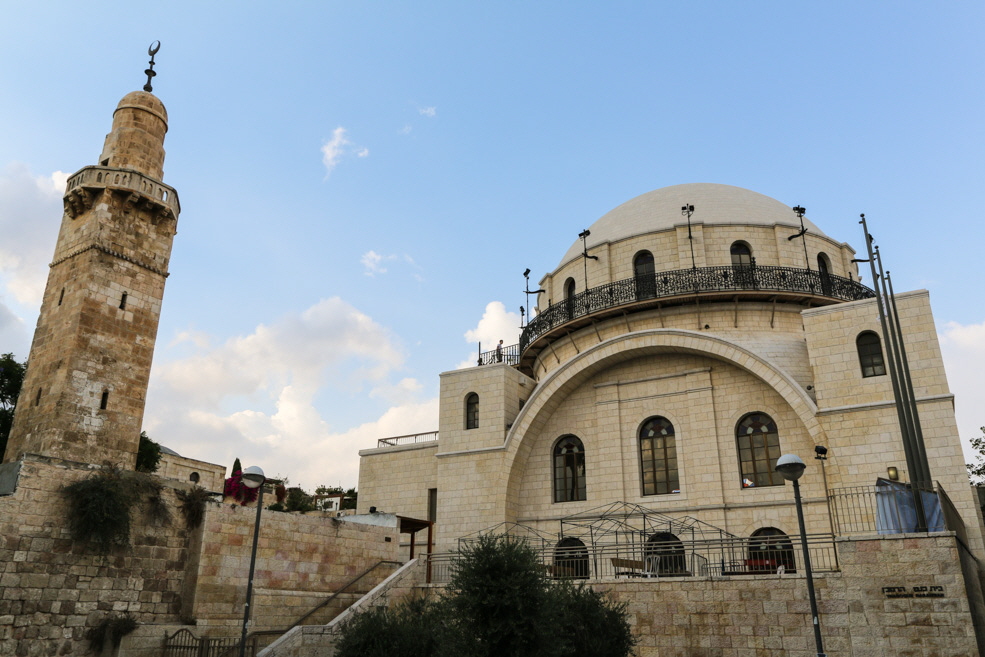
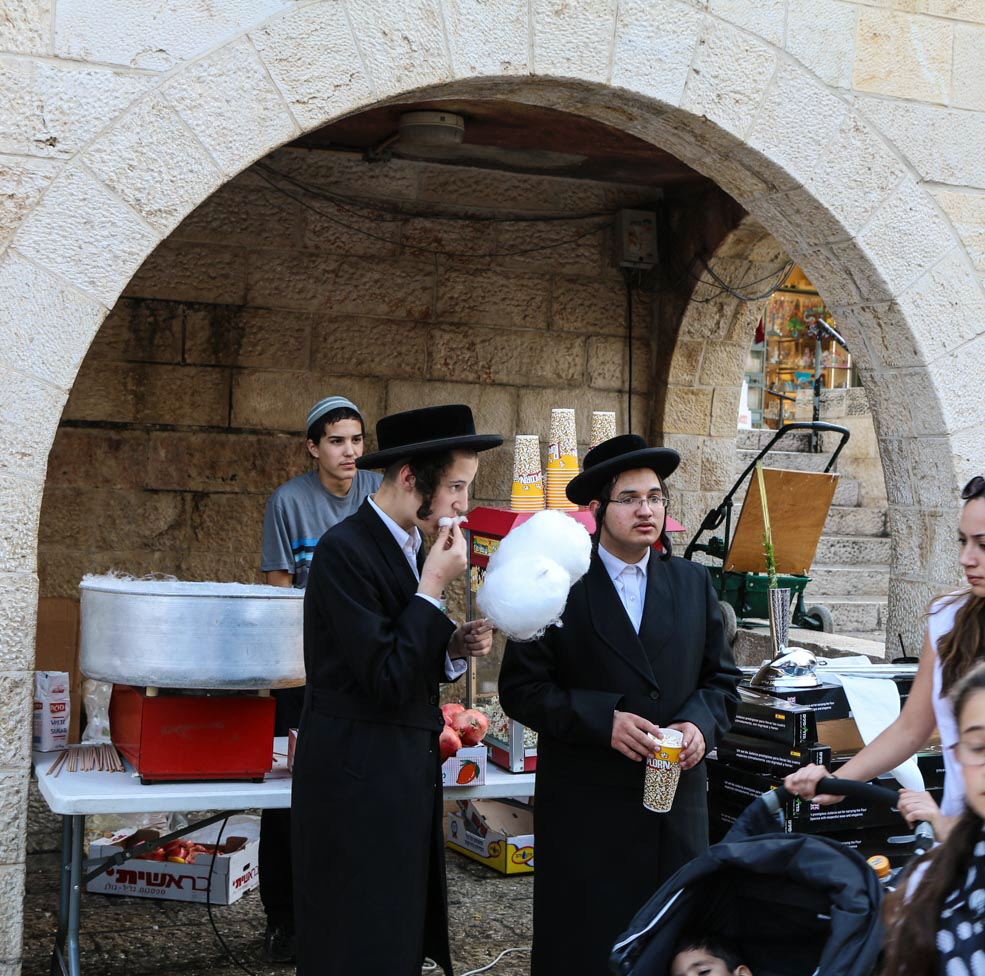
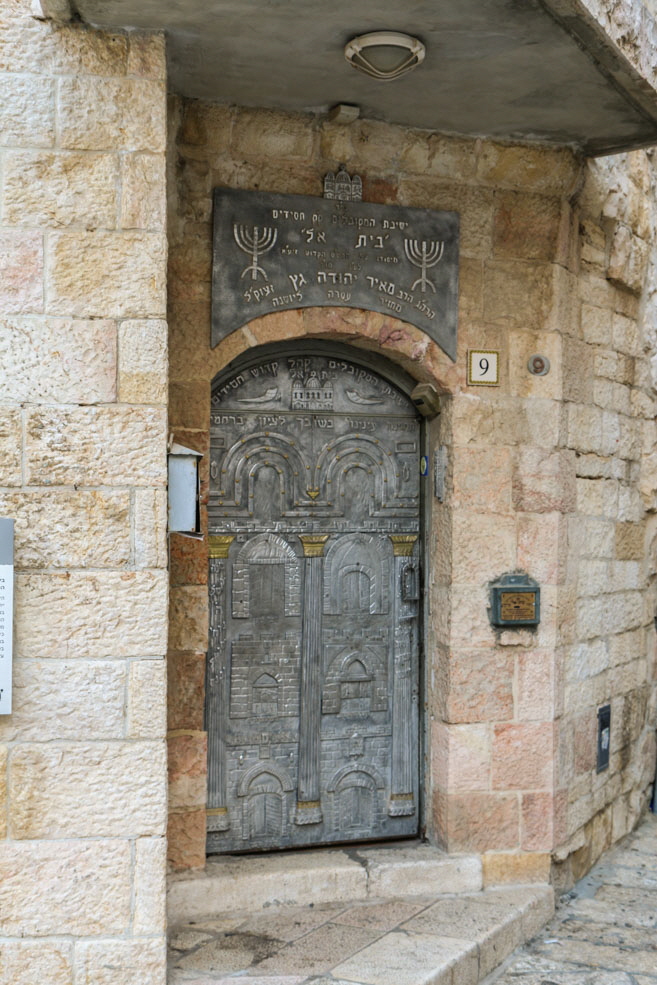
Located just outside the Armenian Quarter is the Cardo. This a partially exposed section of a main road dating back to the Roman-Byzantine era.
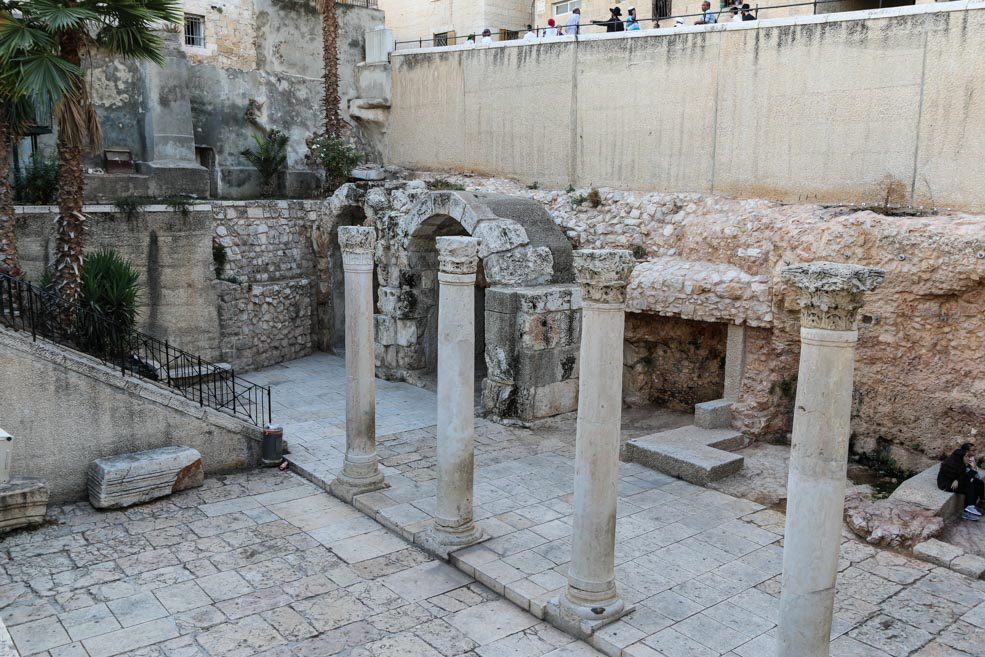
We followed the narrow streets and alleys through the Armenian Quarter.
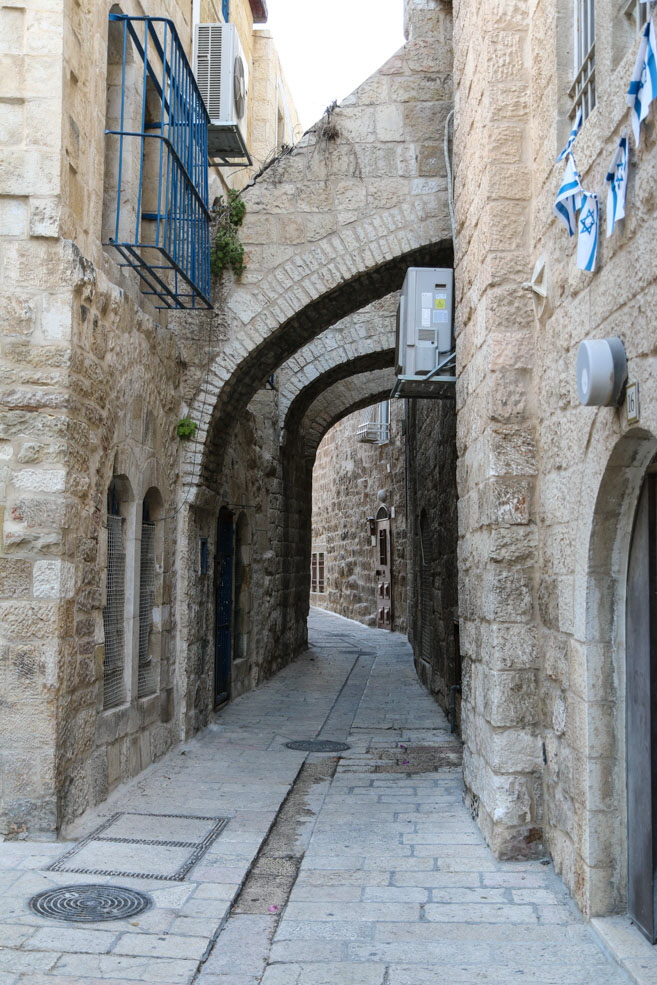
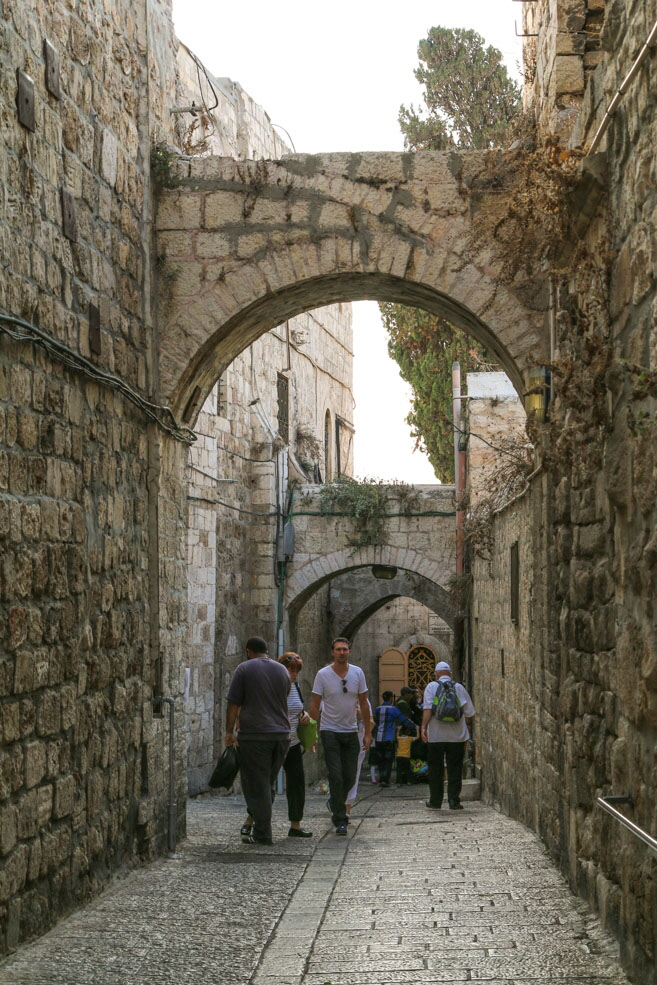
Following the city walls along the Armenian Quarter you reach the Tower of David or the David Citadel.
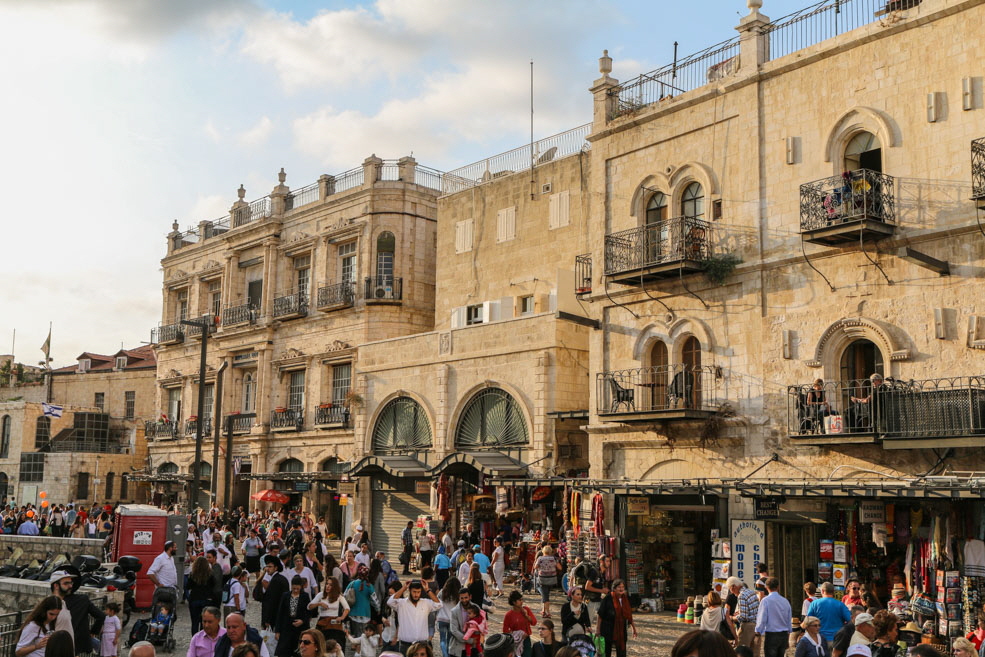
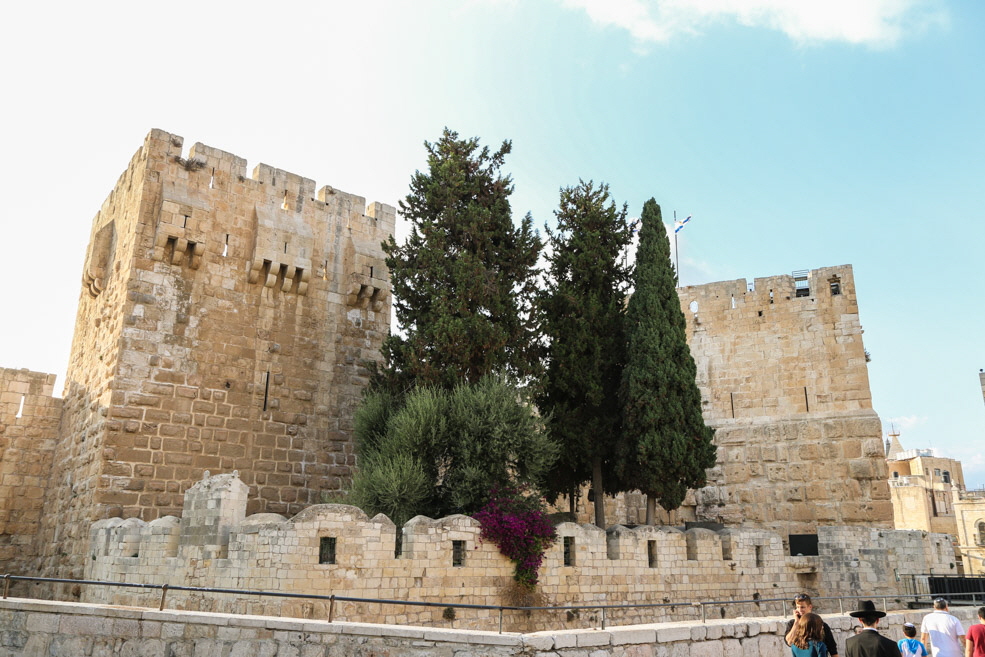
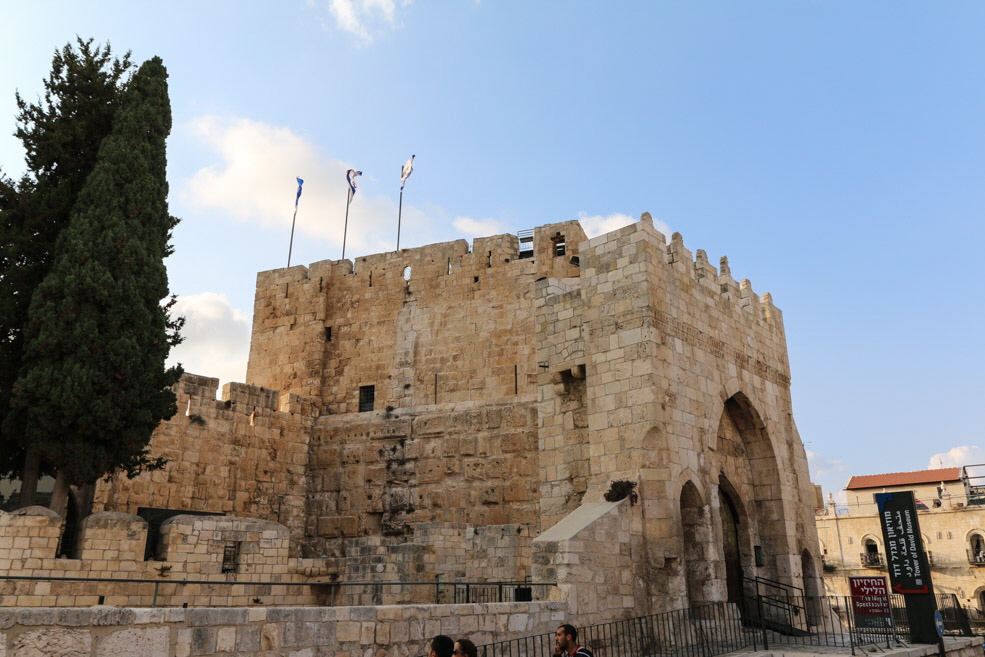
One tower of the citadel is adjacent to the famous Jaffa Gate, which marks the border between the Armenian and the Christian Quarters, the point where East meets West.
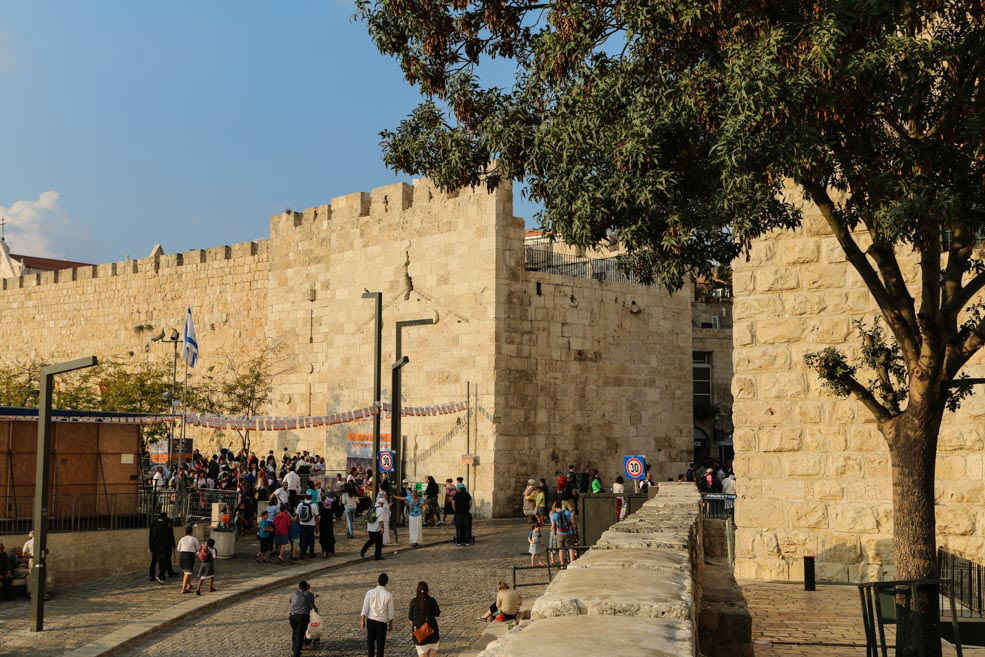
Located at the city walls outside the Jaffa Gate you come across this monument representing Richard Lionheart and Saladin, who conquered Jerusalem from the Crusaders in 1187.
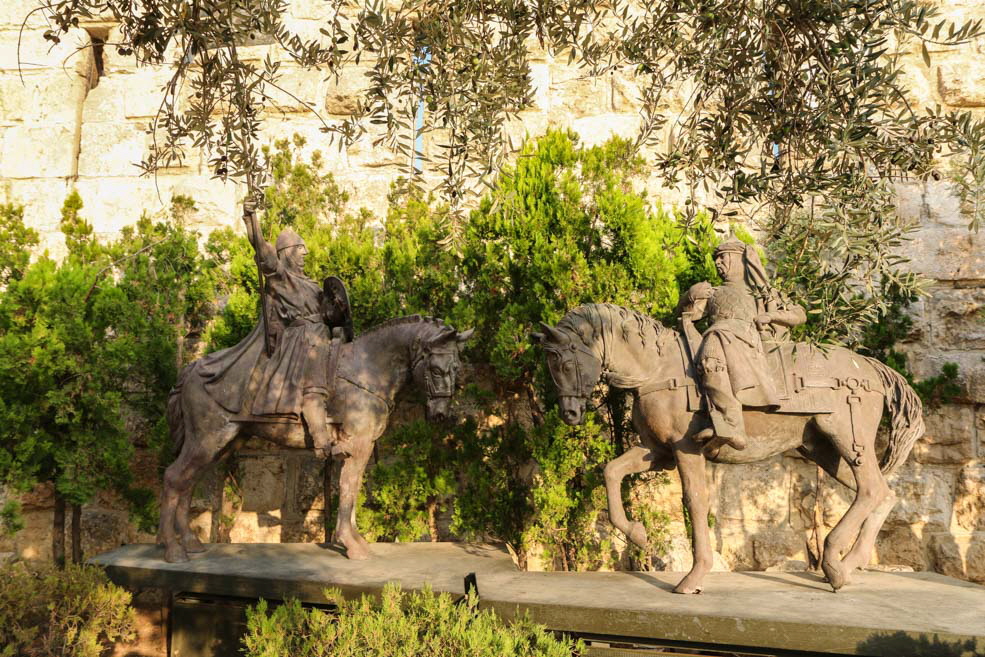
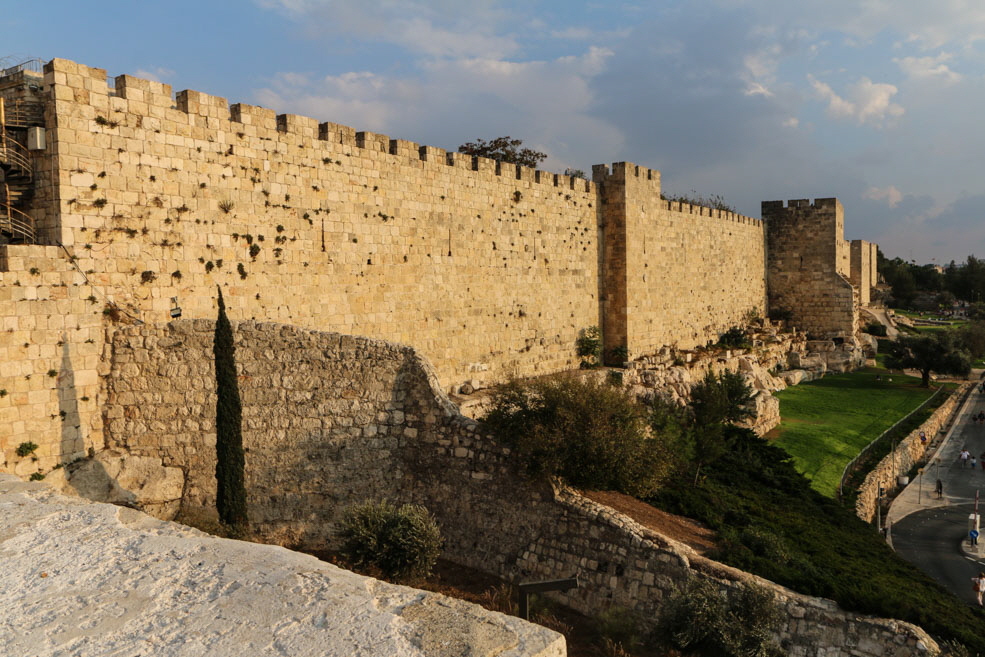
The passage of the gate describes a 90° angle which was designed to make it more difficult for invaders to fight their way into the city. Today we didn’t find any assailants but a harp playing angel.
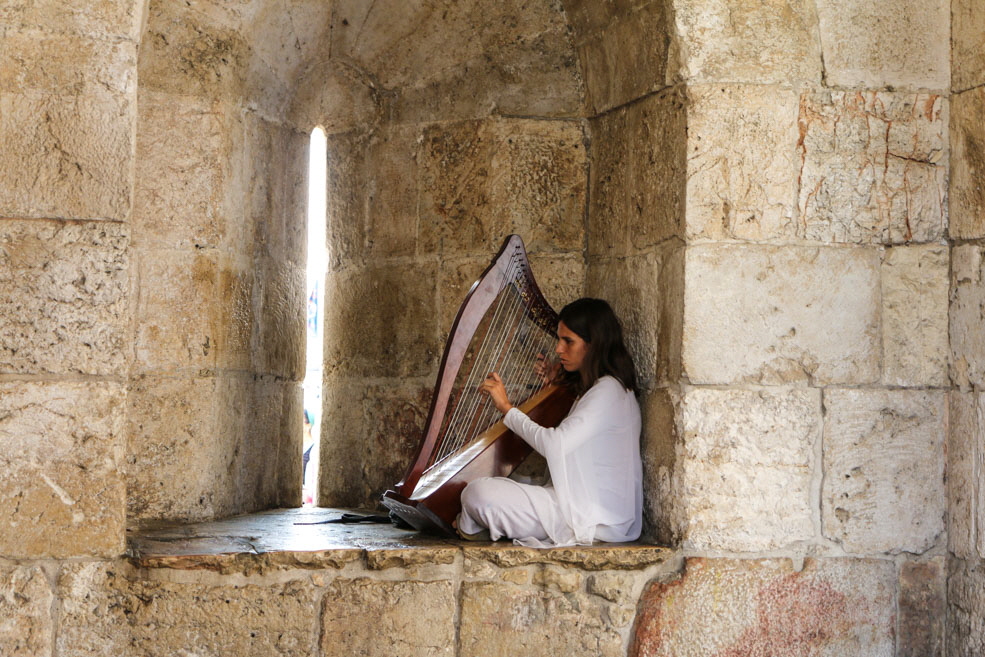
Through the Christian Quarter we made our way towards the Church of the Holy Sepulchre.
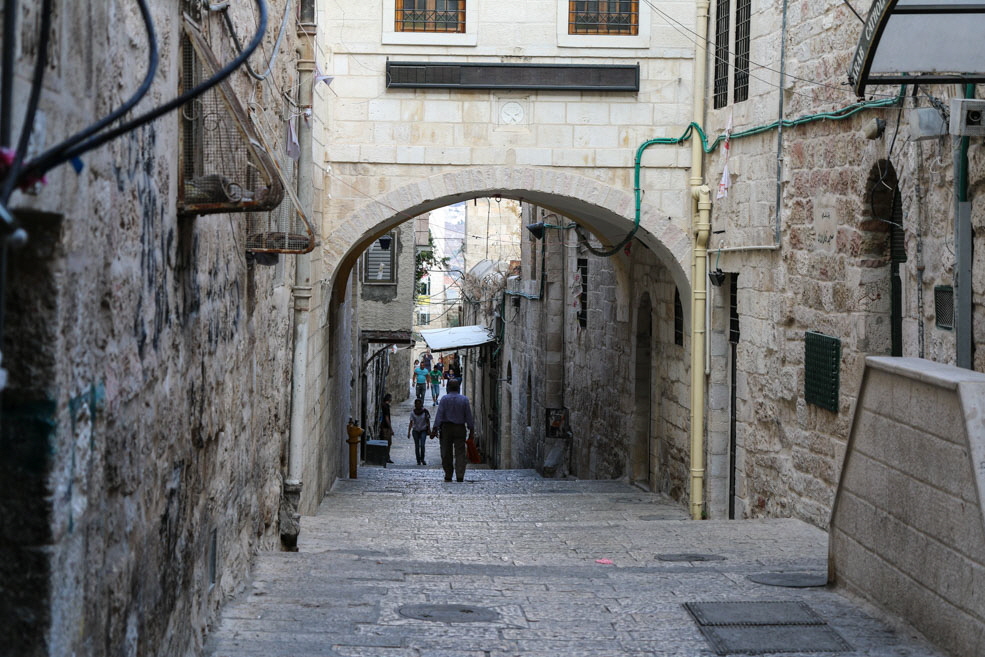
This was another example of the fluent transition between the quarters. The road towards the Christian Church of the Holy Sepulchre led again through Arab souks.
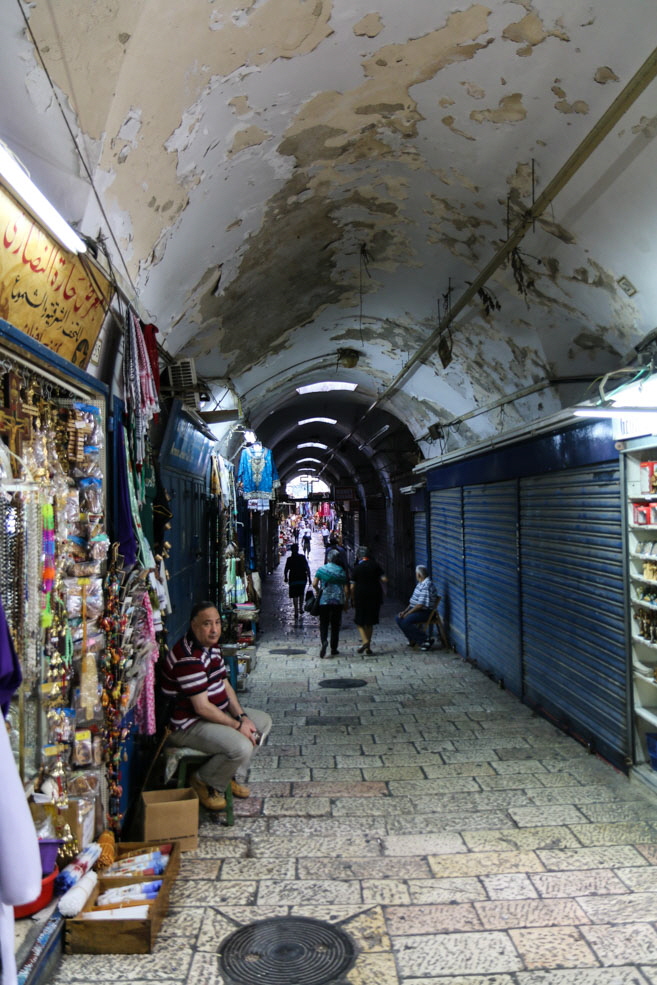
One more passage and you are in front of the Church of the Holy Sepulchre.
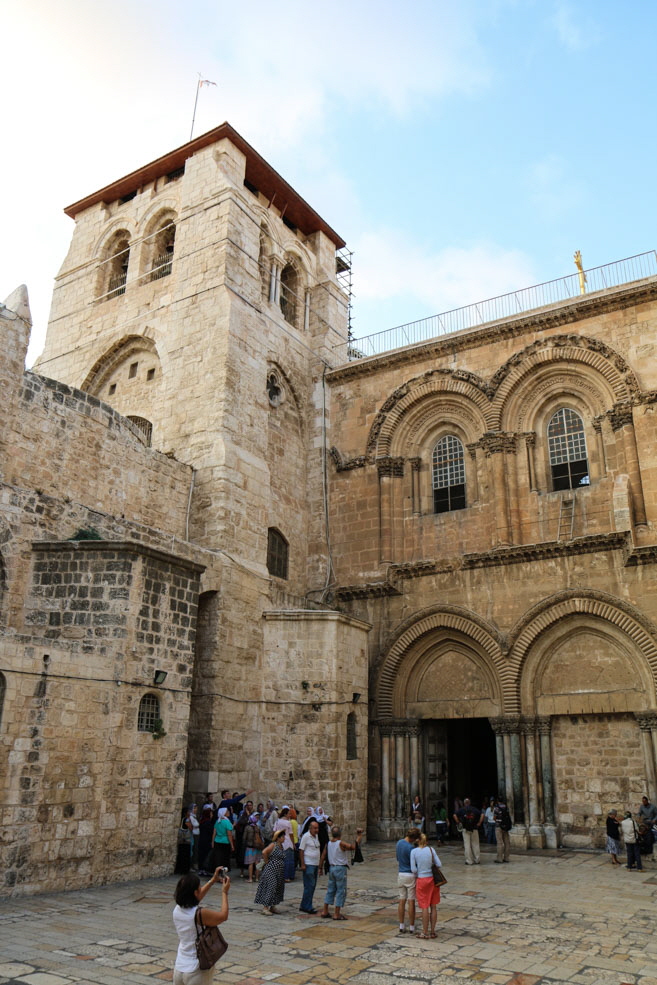
The Church of the Holy Sepulchre is one of the largest sanctuaries of the Christian Church, but at the same time it illustrates the dilemma of lacking union within the Christian faith. The church itself is in the hands of six Christian denominations. The central administration is subject to the Greek Orthodox, the Roman Catholic (represented by the Franciscan Order) and the Armenian Apostolic Church. In the 19th century, the Syrian Orthodox Church of Antioch, the Copts and the Ethiopian Orthodox Tewahedo Church were added. Each group was given certain responsibilities and specific areas inside the Holy Sepulchre. The times of masses, processions and prayers are exactly allocated. From time to time there have been conflicts among the groups, even resulting in fistfights among the monks. In sharp contrast to the message of peace and unity, here the coexistence is characterized by competition.
For centuries, due to the continuous and permanent disputes, the key to the church has been kept by a Muslim family, who opens and closes the church every day.
After the Six-Day War in 1967, after which the Old Town of Jerusalem came under Israeli administration, Israel retained this division, also known as the Status Quo. Nobody wants to rock it, which thwarts even badly needed building measures on parts of the building in danger of collapsing. Nobody feels responsible. The craziest example is a ladder, which was used by the monks in the 19th century to get into the closed building. It has been redundant ever since, but nobody dares to remove it in order to not jeopardize the Status Quo.
As a result, the ladder has stood under a window above the main entrance for decades.
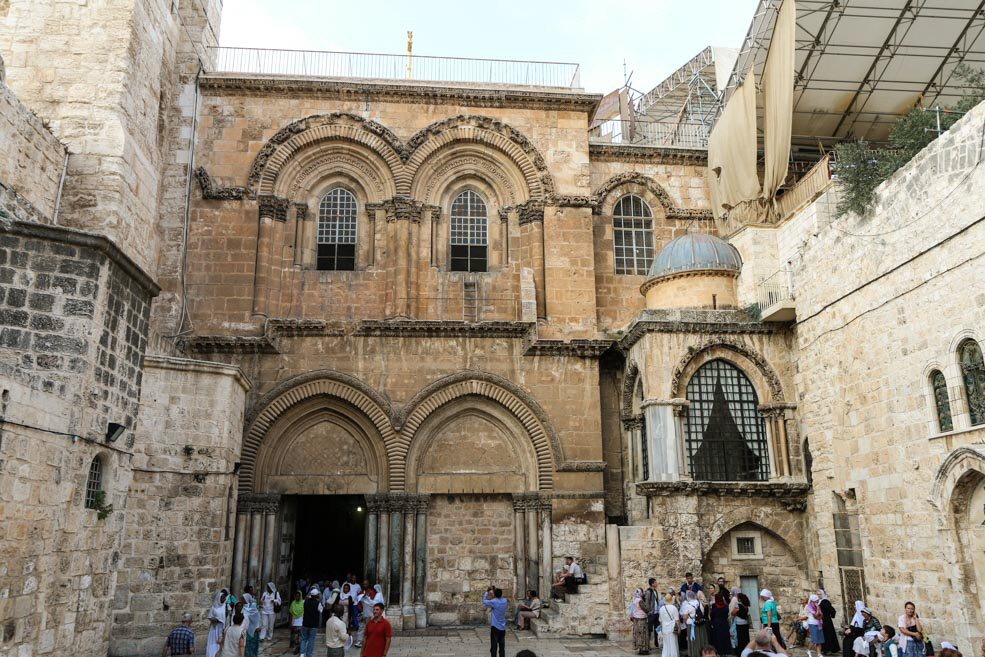
Just like when we accessed the Old Town through the Herod’s Gate, entering the Church we felt like stepping into a different world. Inside, the church resembles no church I have ever seen and it has no recognizable structure of a typical church. Instead, there are interlaced vaults and corridors as well as different levels. The church is said to have been built on the mount of Calvary, also known as Golgotha. This is why the various holy sites of that mount are locaded on different levels within the church.
At the entrance to the right via a narrow flight of stairs you reach Calvary, the site of the crucifixion. A Roman Catholic altar marks the site where Jesus is said to have been nailed to the cross.
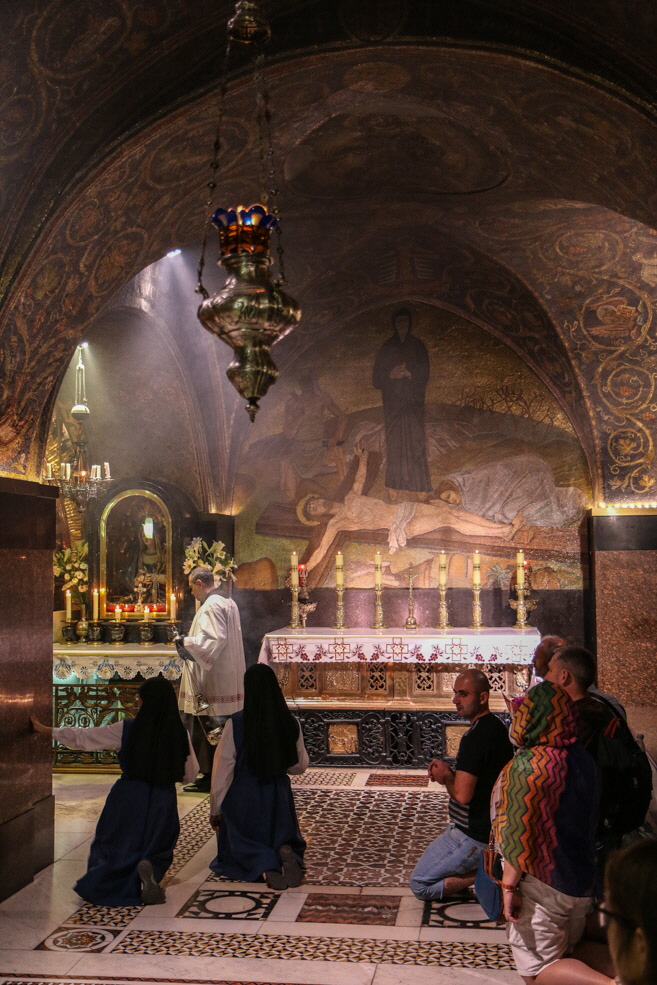
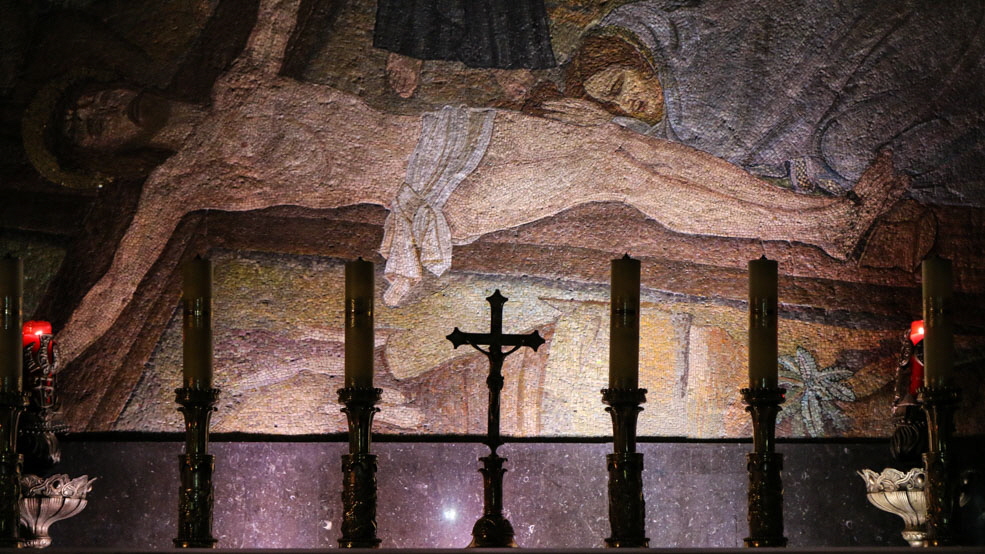
Right next to it, a Greek Orthodox Crucifixion Altar has been built at the site of the cross.
The depictions of Jesus and Mary are only two-dimensional, as sculptures aren’t common in the Orthodox church.
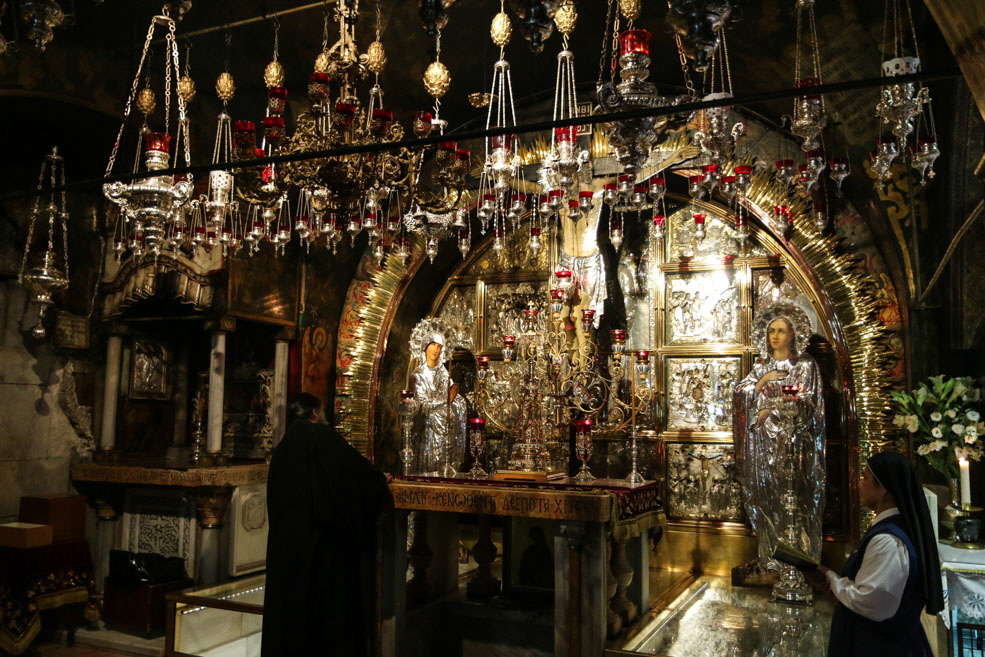
By the way, these stops also count among the Stations of the Cross.
Chants and prayers in various languages resounded from everywhere inside the chruch creating a very mystical atmosphere.
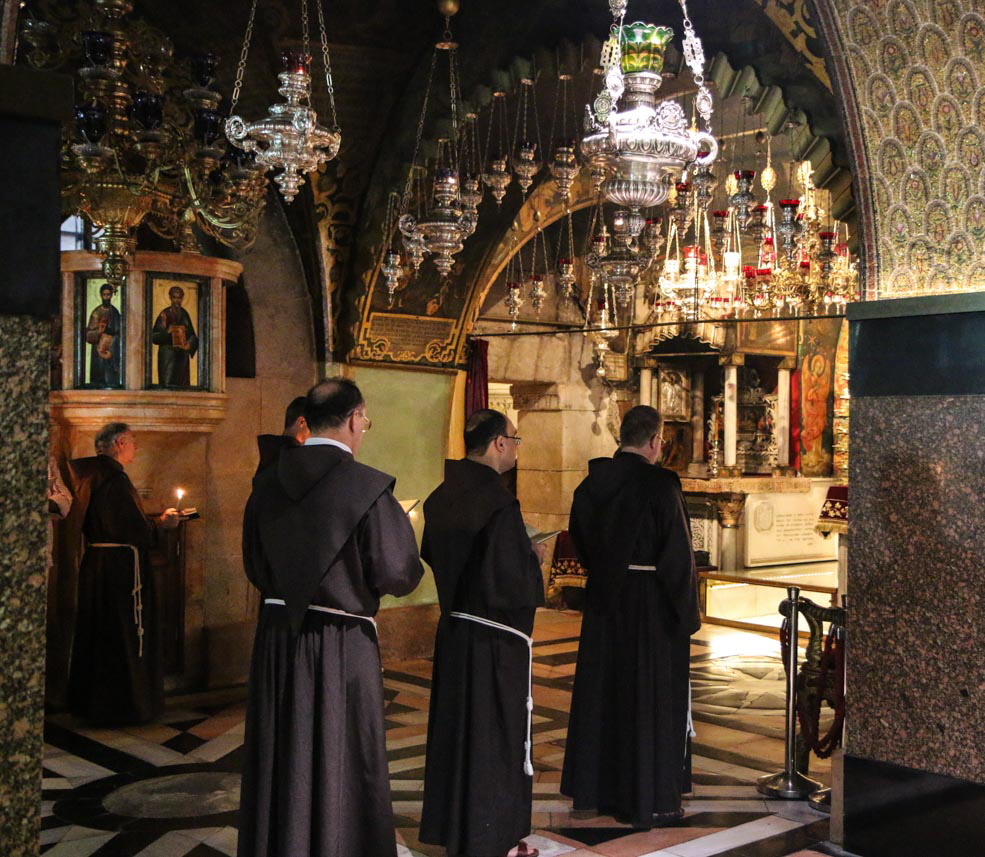
Below the Crucifixion Altar there is a rock with a gap in which the cross is said to have stood. Many pilgrims crawl underneath the altar to touch the stone.
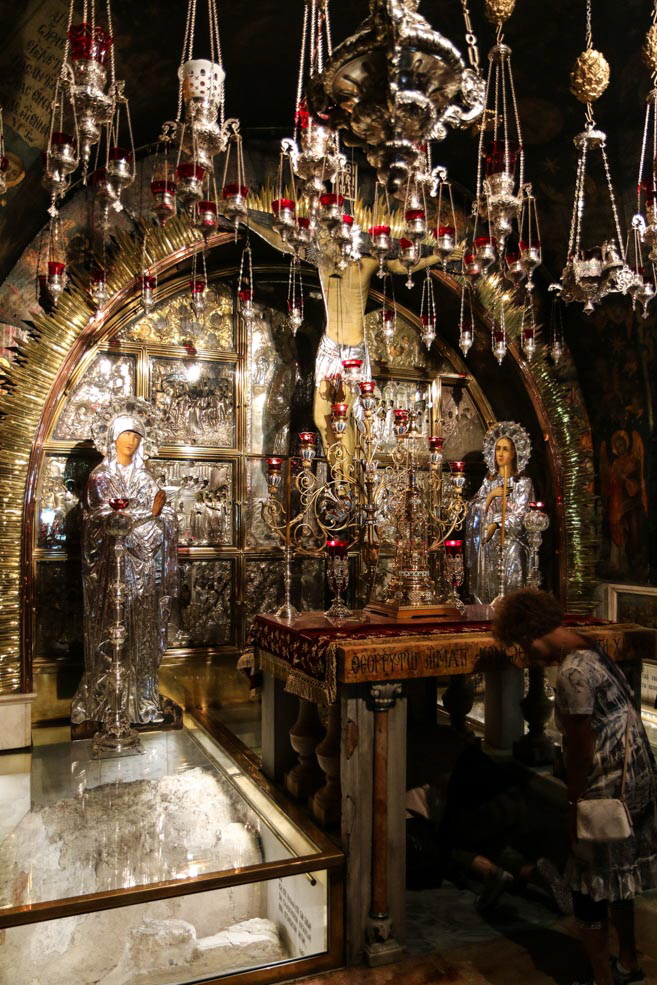
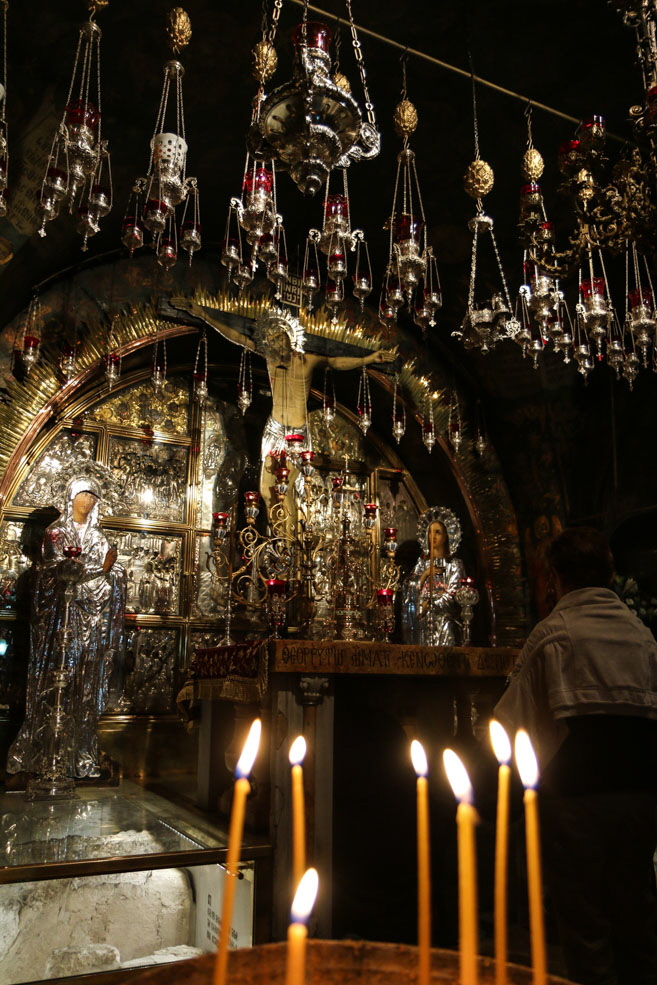
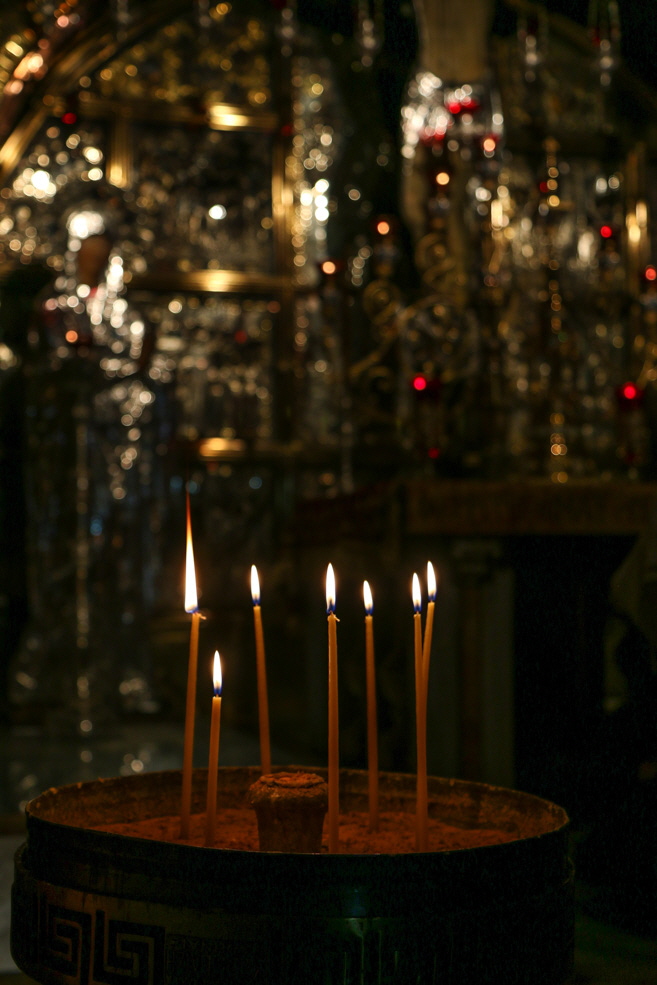
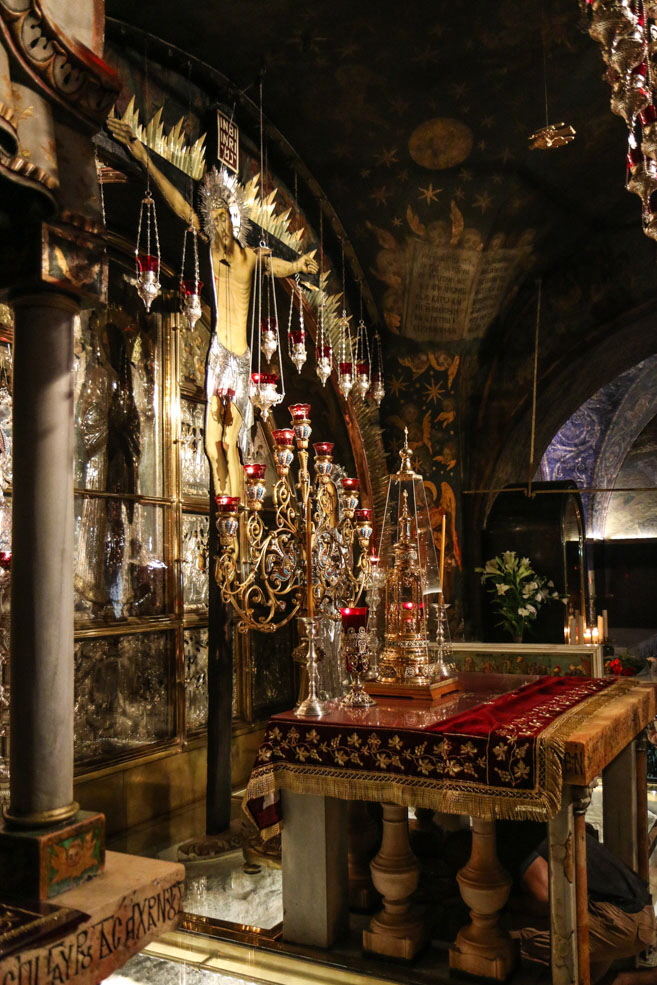
At the level of the main entrance you find the “Stone of Anointing. This is the stone on which Jesus, after he was taken from the cross, is said to have been anointed and wrapped in cloths. A magnificent mosaic at the wall behind the stone bears witness to it.
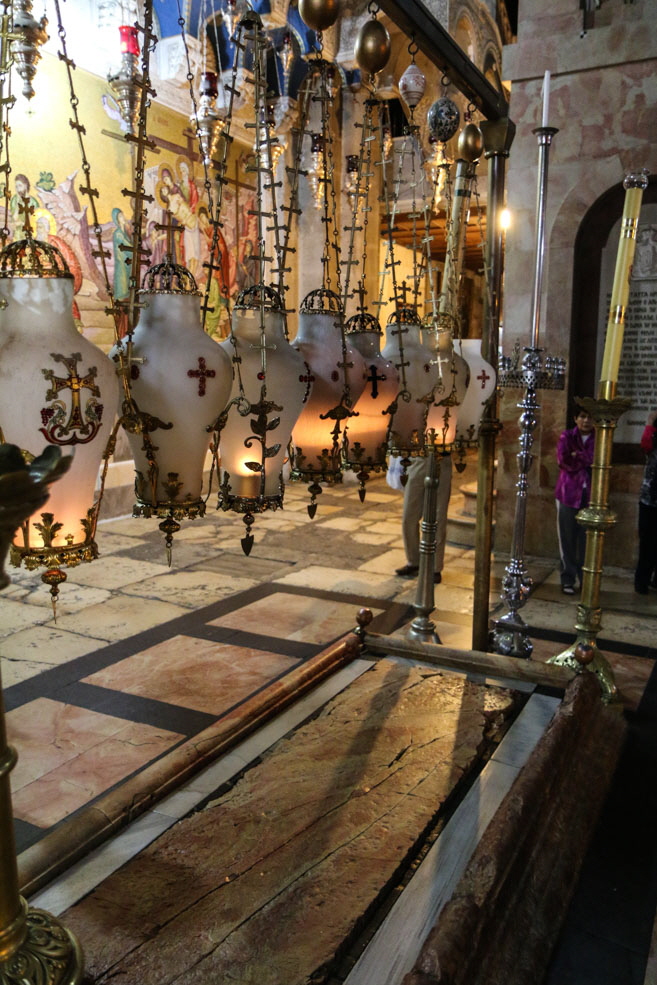
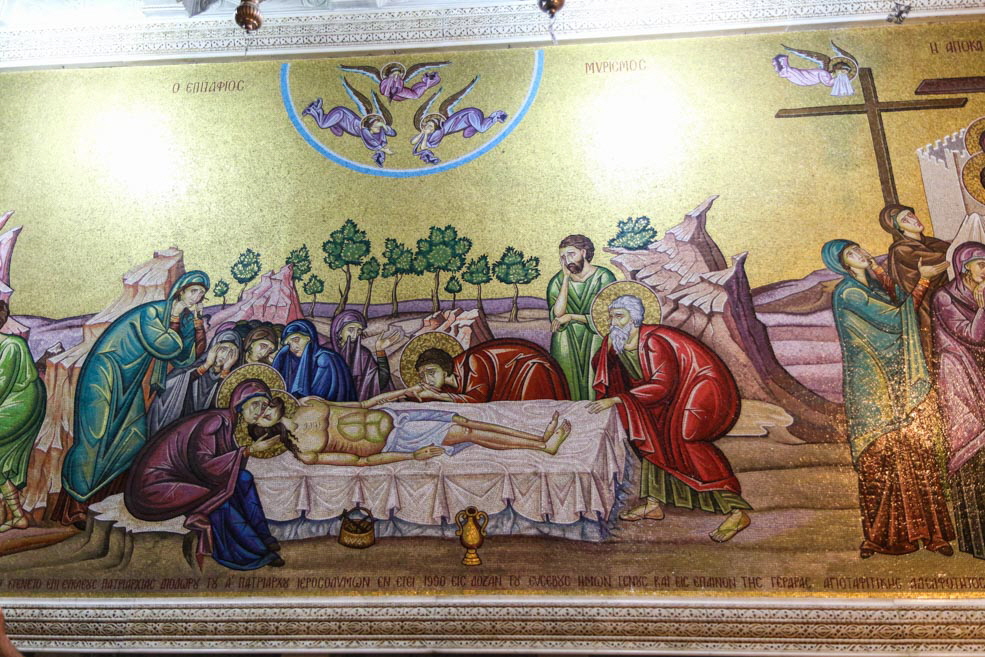
The passage continues below a huge cupola of the church which spans the entire Holy Tomb. The tomb is covered by a 300-year old structure of wood and stone (Aedicule). According to tradition this is the site of the cave in which Jesus was laid to rest.
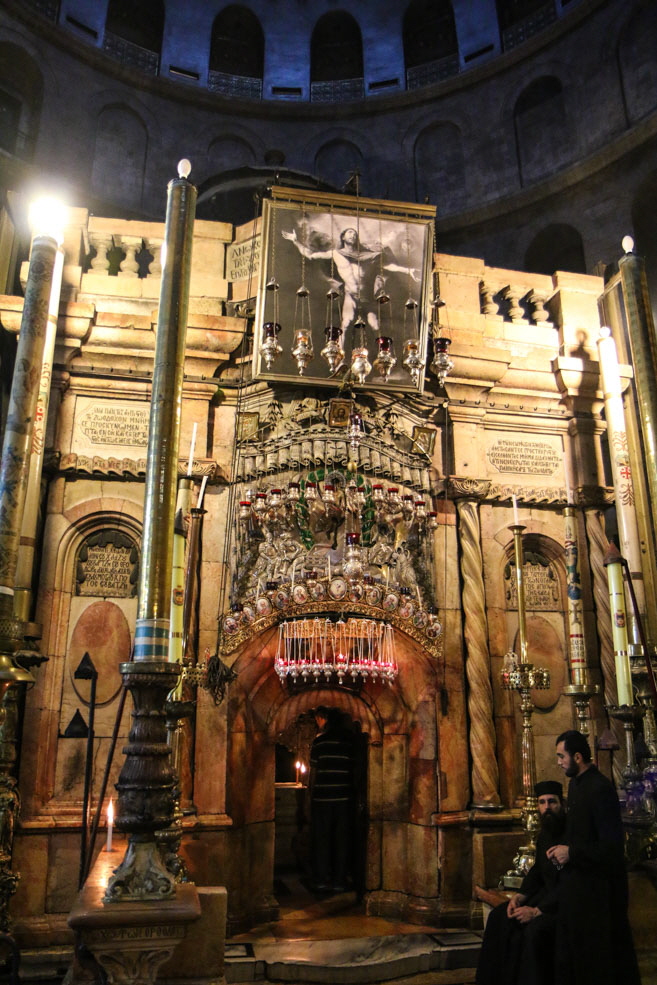
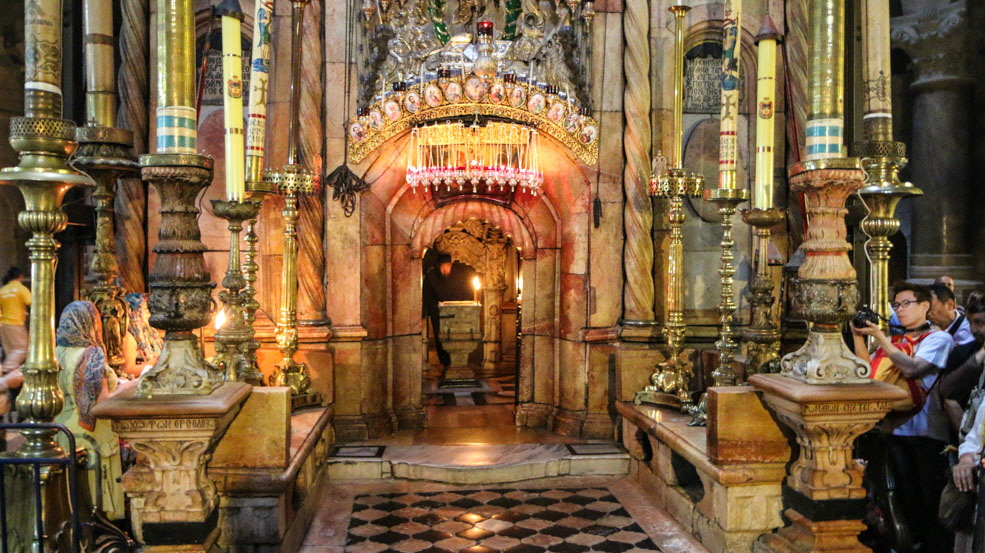
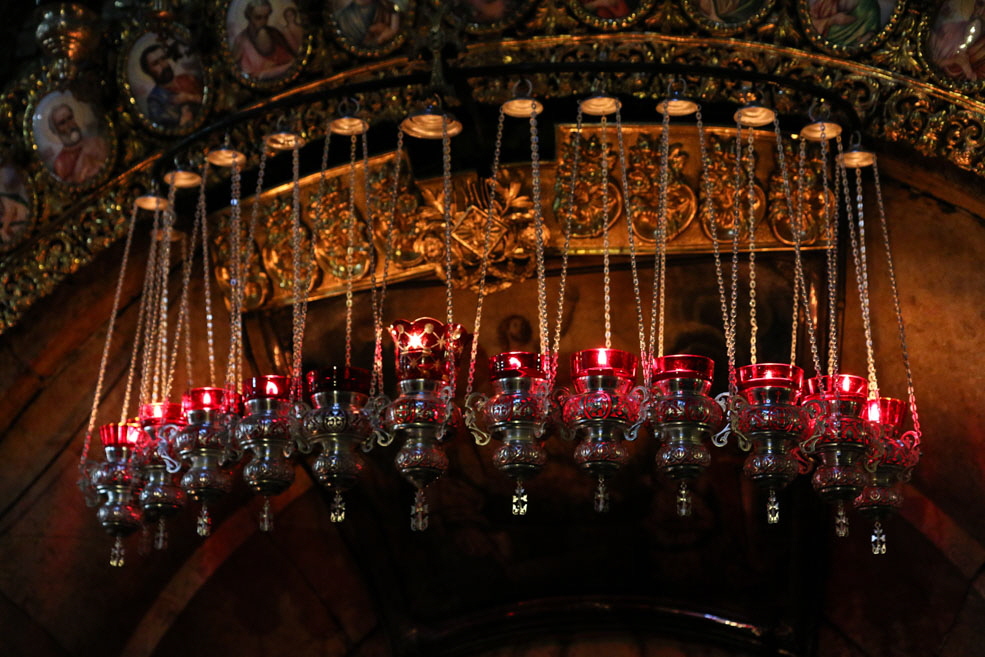
Just when we were wandering around the Rotunda, the Franciscan monks celebrated a mass. The sounds of the organ echoed through the vault and filled the church with their tones.
The sacral atmosphere inside the church and the pervading sounds really went under my skin and touched me deeply. As I mentioned earlier, I am not a believer. And yet I couldn’t resist the spell of this place steeped in history. One can be divided about whether the story actually happened or not, and whether these venerated sites were actually the exact real sites. For a large part of the world’s population, however, there is no doubt about it. Standing in a place which has been essential for a movement which has significantly influenced the fate of humanity for over 2000 years evoked a lot of reverence in me as well, and I found it to be a very emotional experience.
After the prayer of the monks in front of the tomb, the mass in the Chapel of Mary Magdalene right next to it was continued.
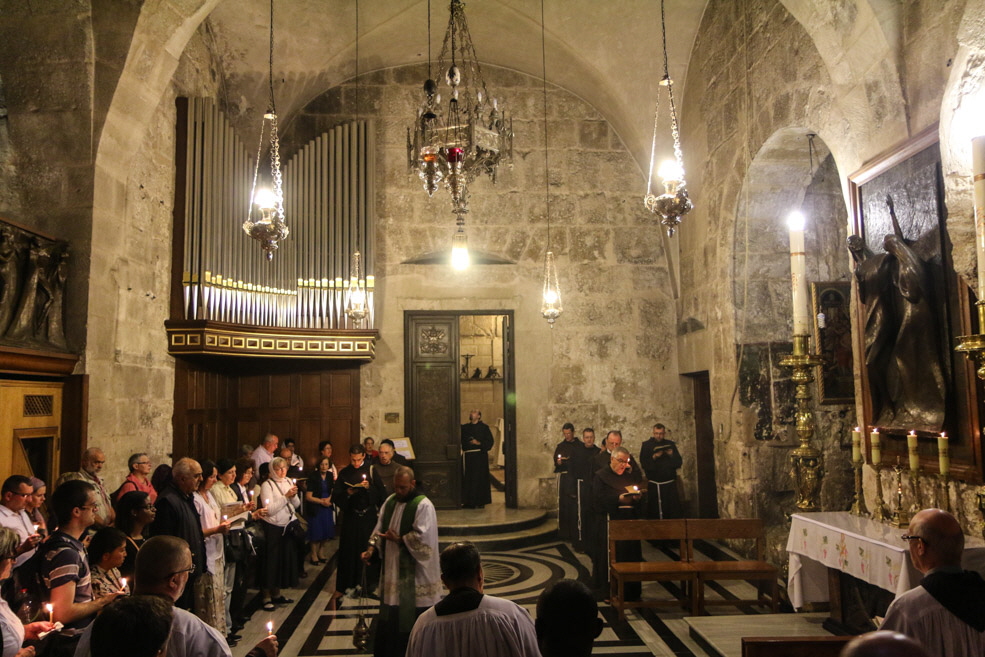
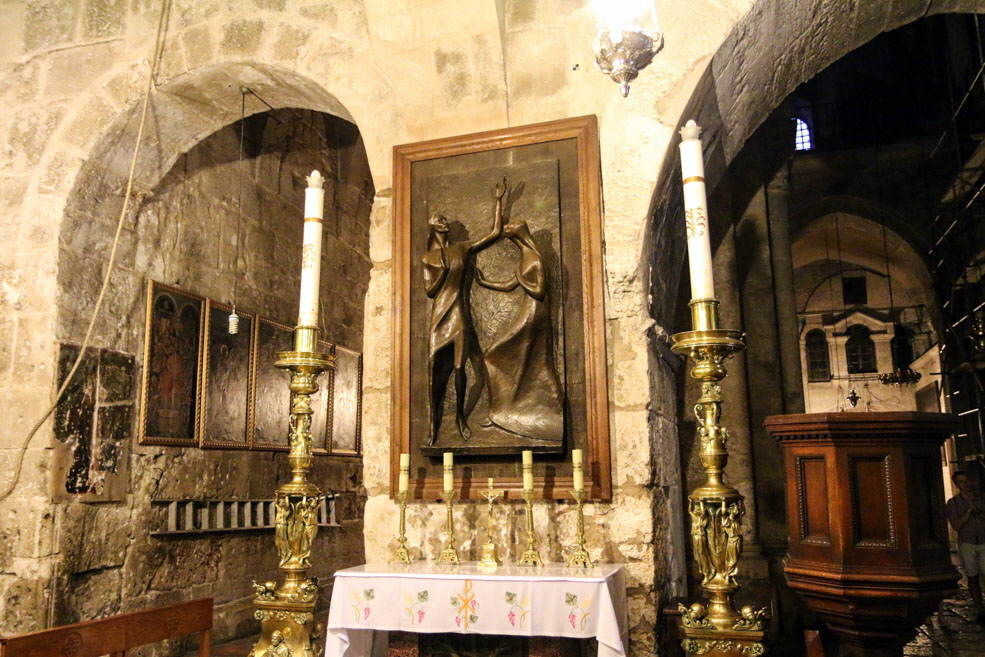
You can also visit the tomb itself. In groups of three you can enter the “Chapel of the Angel” in the Aedicule, from which you reach the actual sepulchre through another low opening. After a short moment of reverence a priest gently taps against the stone and you have to leave the sepulchre again.
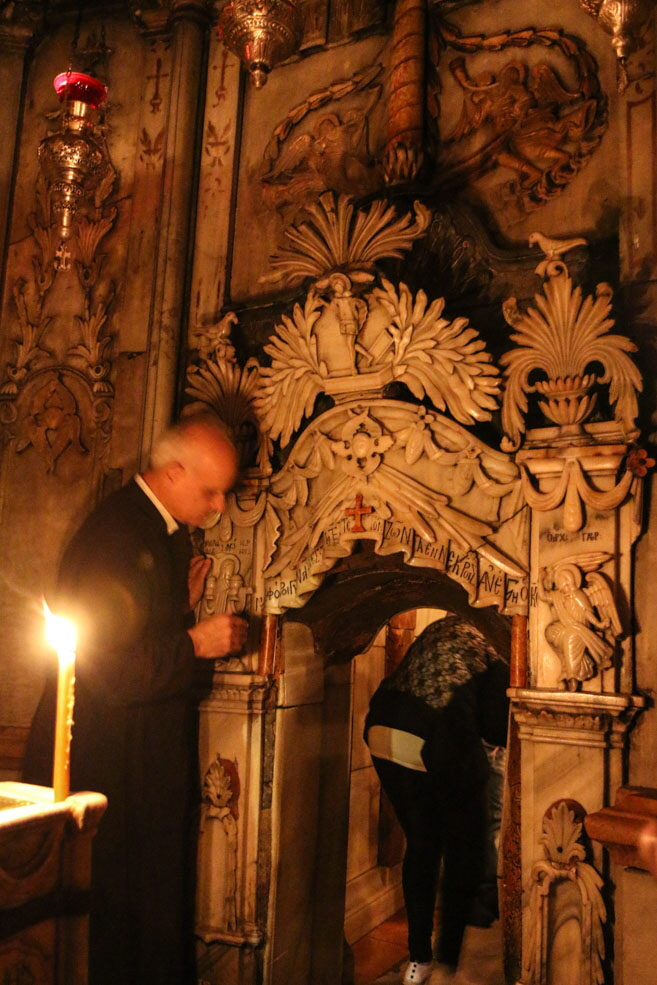
We also visited the sepulchre. Inside, a lady who had come inside with us, broke down crying on the slab that covered the tomb.
When we came out, the area in front of the sepulchre was cleared again, as it was now the turn of the Armeninan monks and their procession.
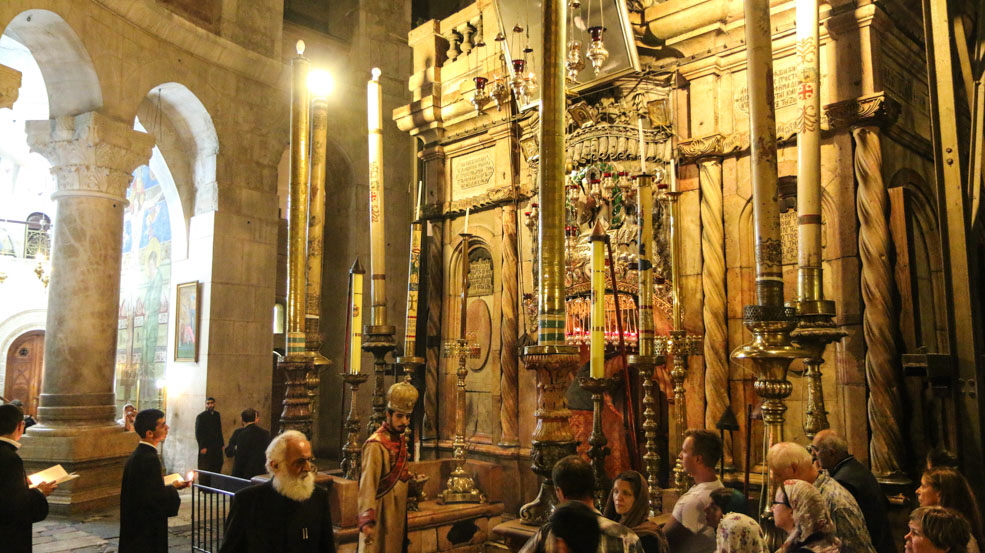
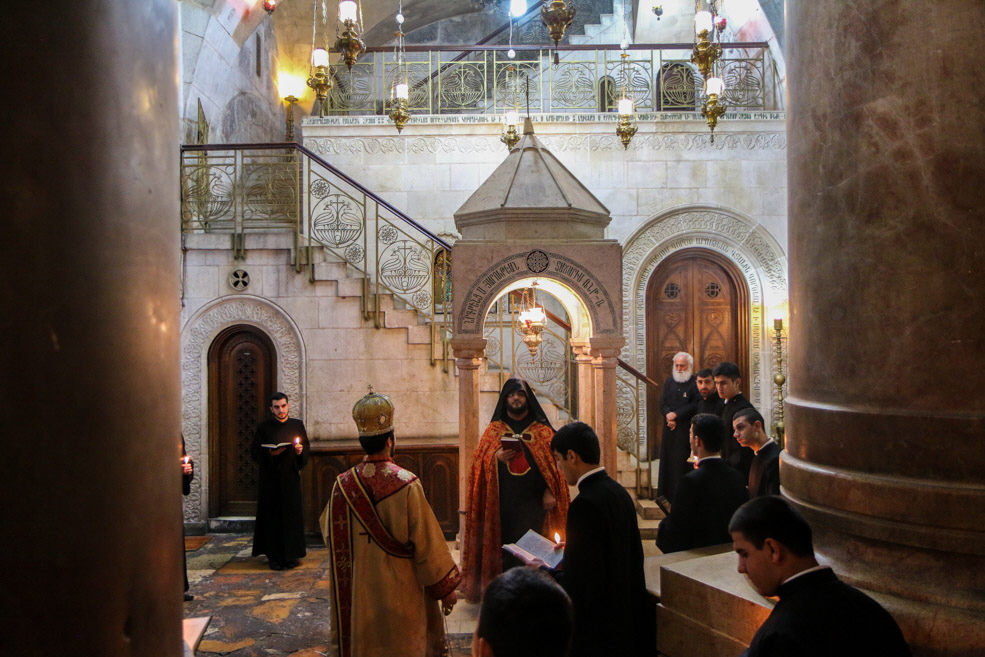
The central area of the church is known as the Katholicon. A light in the ground is to indicate the center of the earth. Unfortunately, this area was closed.
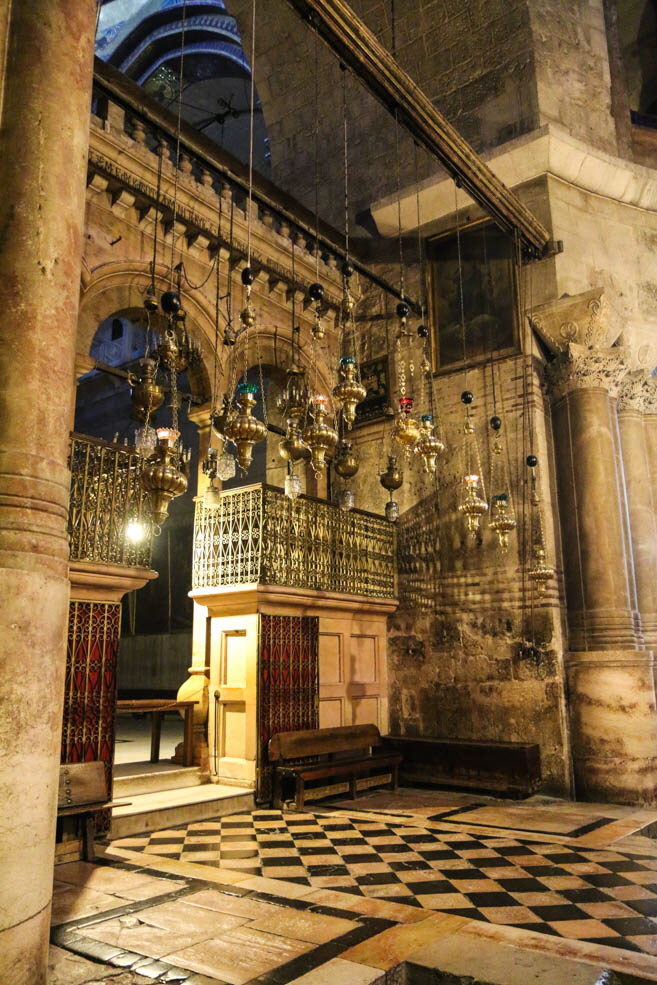
We left the Rotunda through a lateral vaulted passage leading past three smaller chapels.
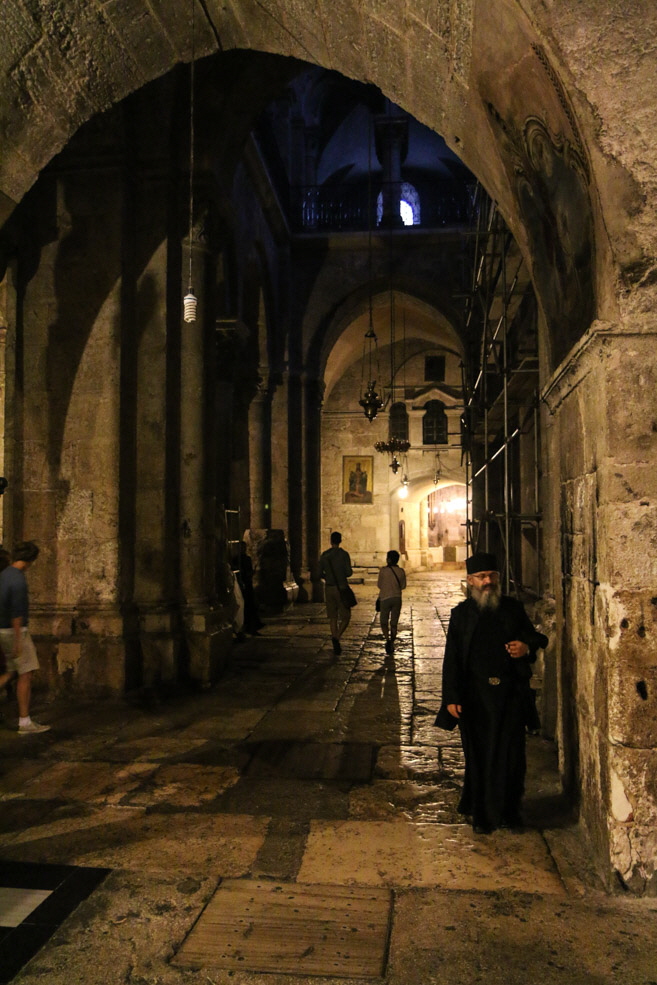
Chapel of the Division of the Robes (Greek Orthodox):
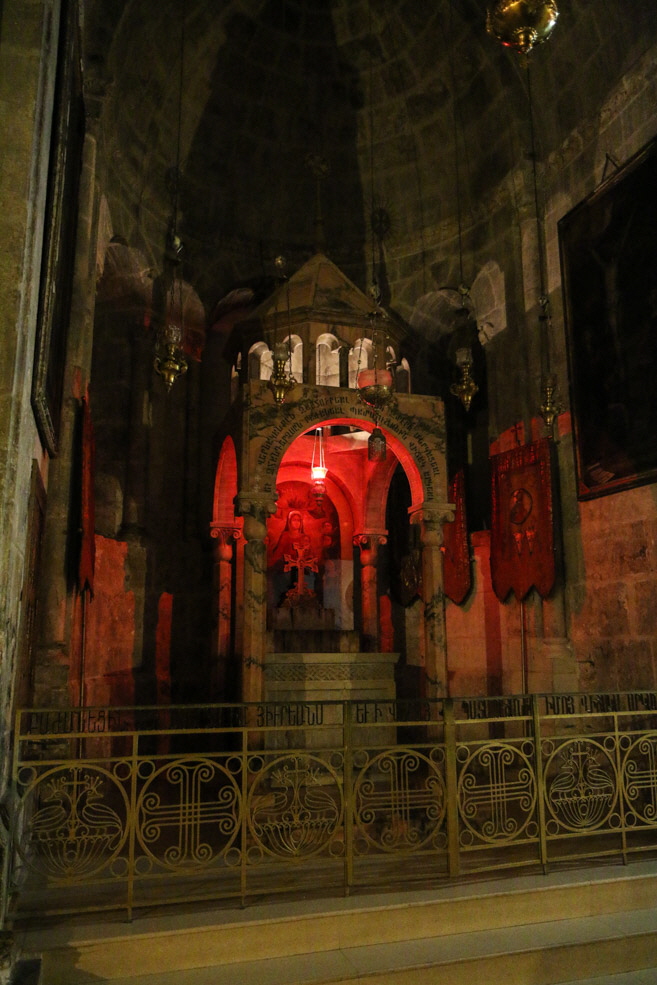
Chapel of St. Longinus. Longinus was a Roman Centurion who attended the crucifixion and later became a Christian.
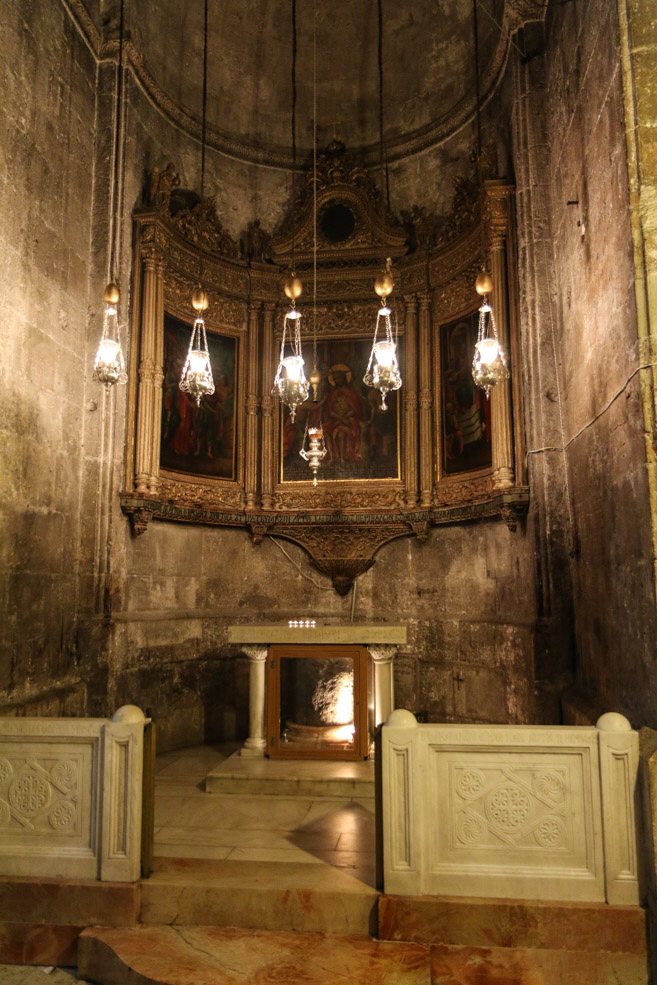
From this corridor, 29 steps lead downstairs to the Chapel of St. Helena. On the walls to the left and right of the stairs you can see carved crosses which were cut by prilgrims in the Middle Ages.
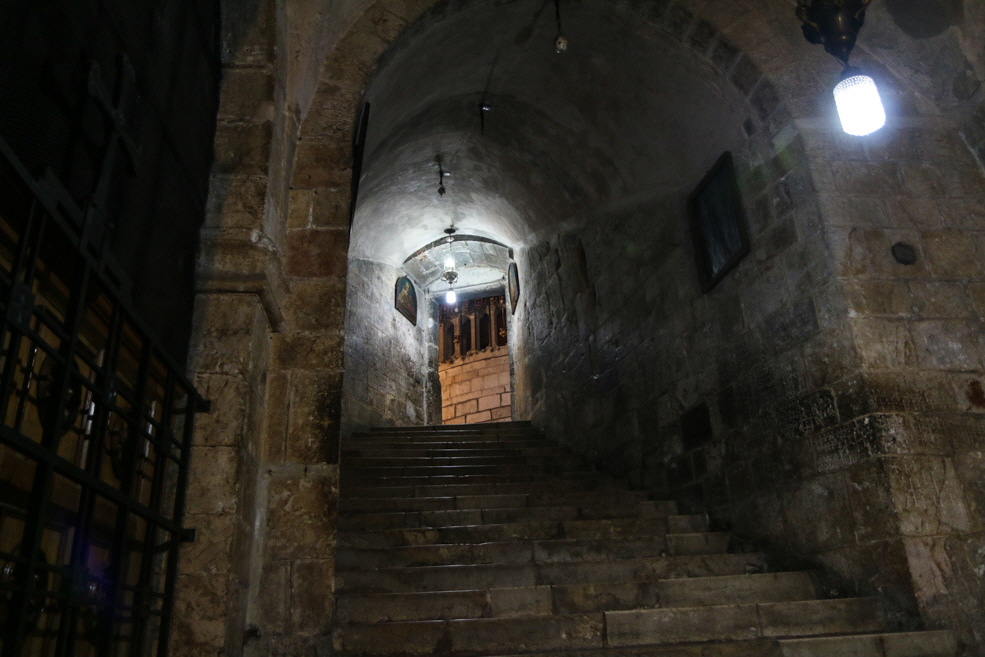
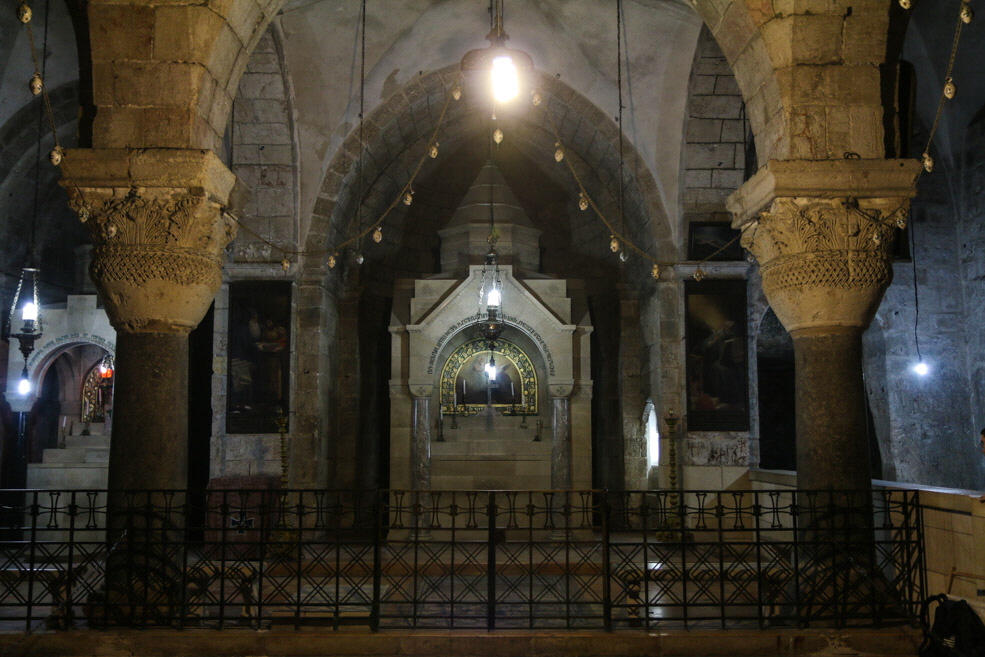
Next to the shrine you go down another staircase and reach the lowest point of the church, the Chapel of the Finding of the Cross.
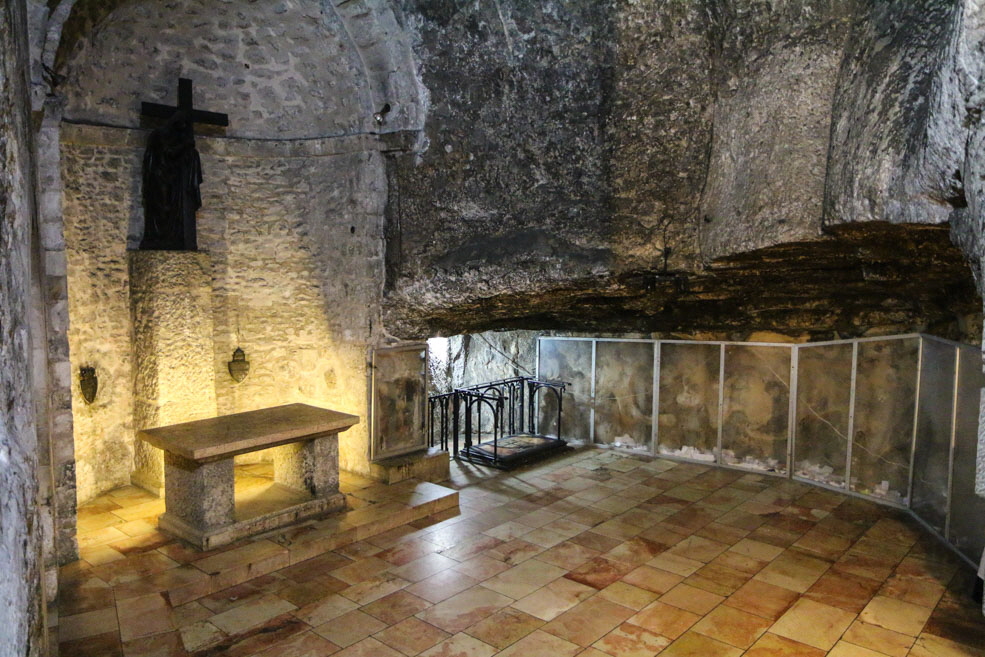
Originally, the Church of the Holy Sepulchre didn’t play an important role with regards to my expectations of Jerusalem, but now we were leaving this site steeped in history profoundly impressed and moved. Exiting the church we noticed that it had turned dark outside.
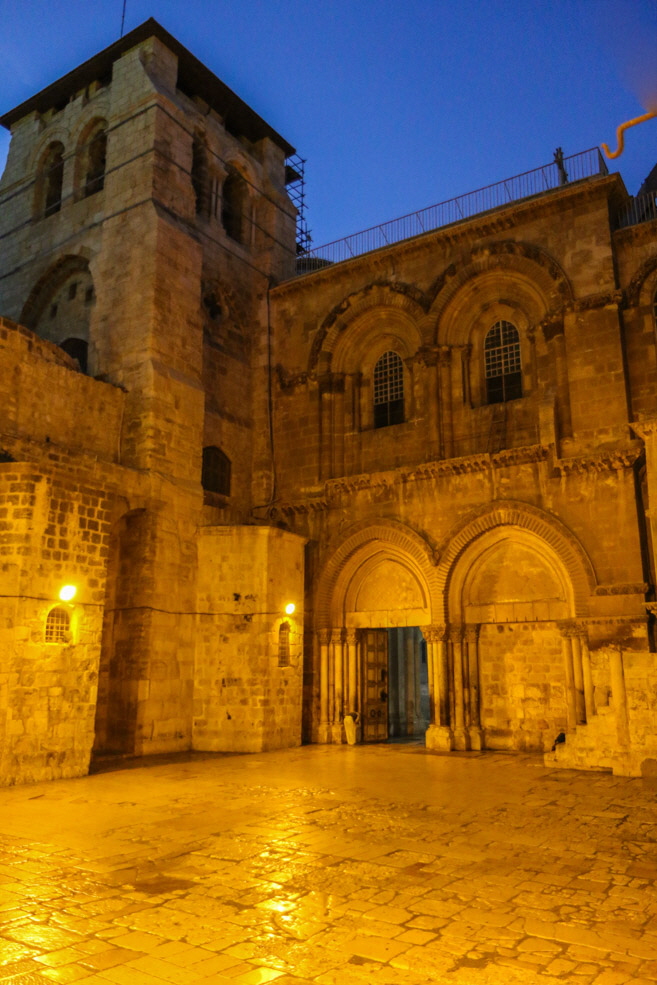
Not far from the Church of the Holy Sepulchre you come past the entrance of the Muristan Market (Suq Aftimos), which is located opposite the Church of the Redeemer.
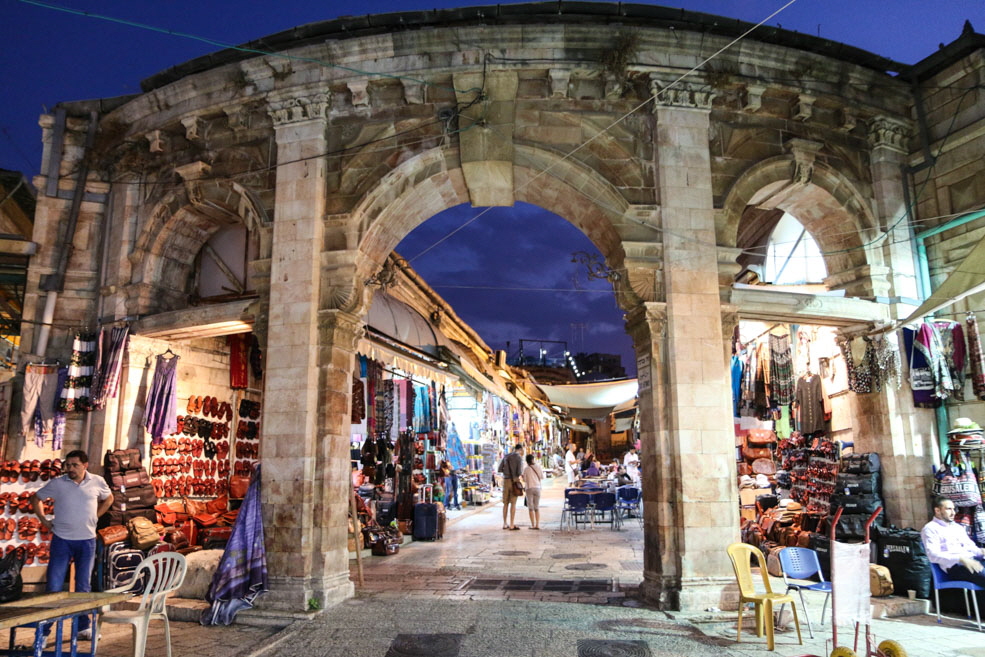
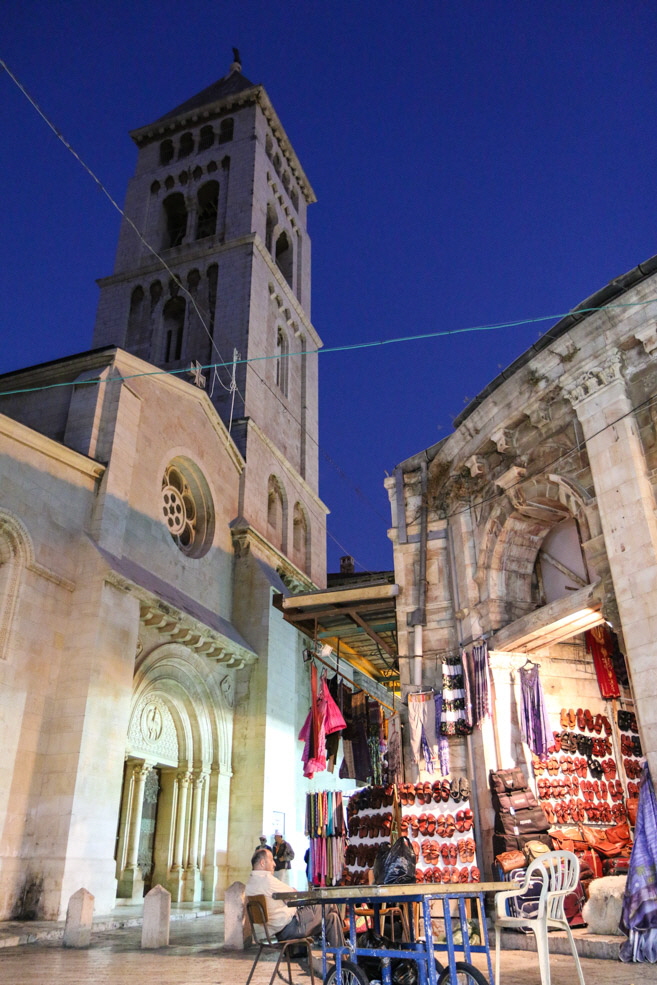
The alleys, which had been packed with tourists during the day, were now empty and bathed in an eerie light.
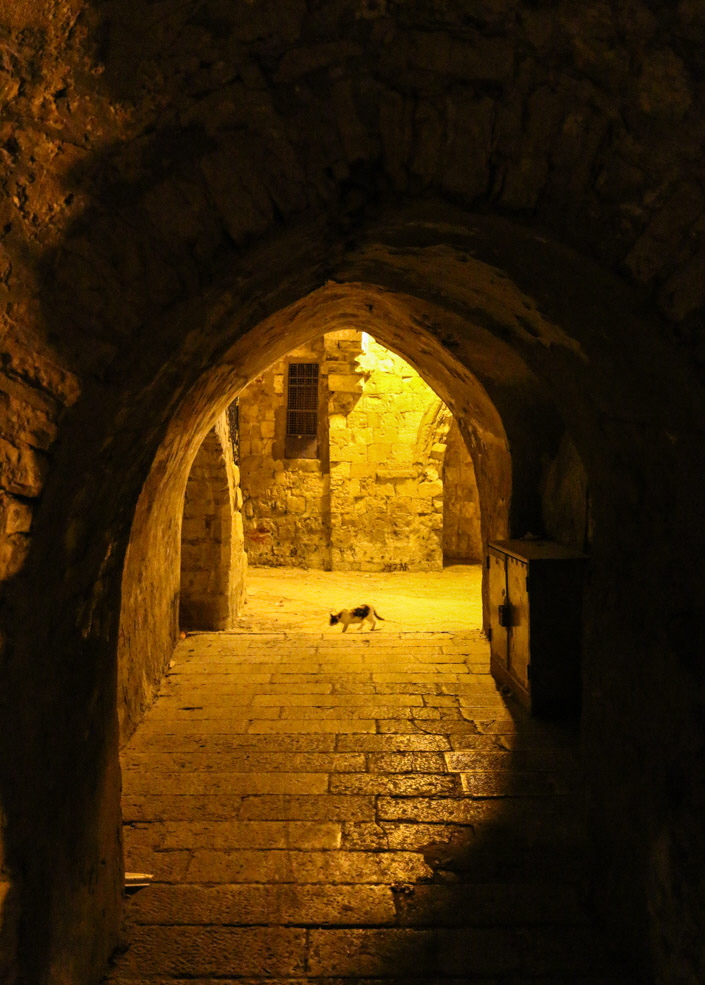
The Wailing Wall was the only place where the Sukkot festival was still being celebrated. At this time, the square was almost exclusively populated by Jews. The hordes of tourists had left the city in the meantime.
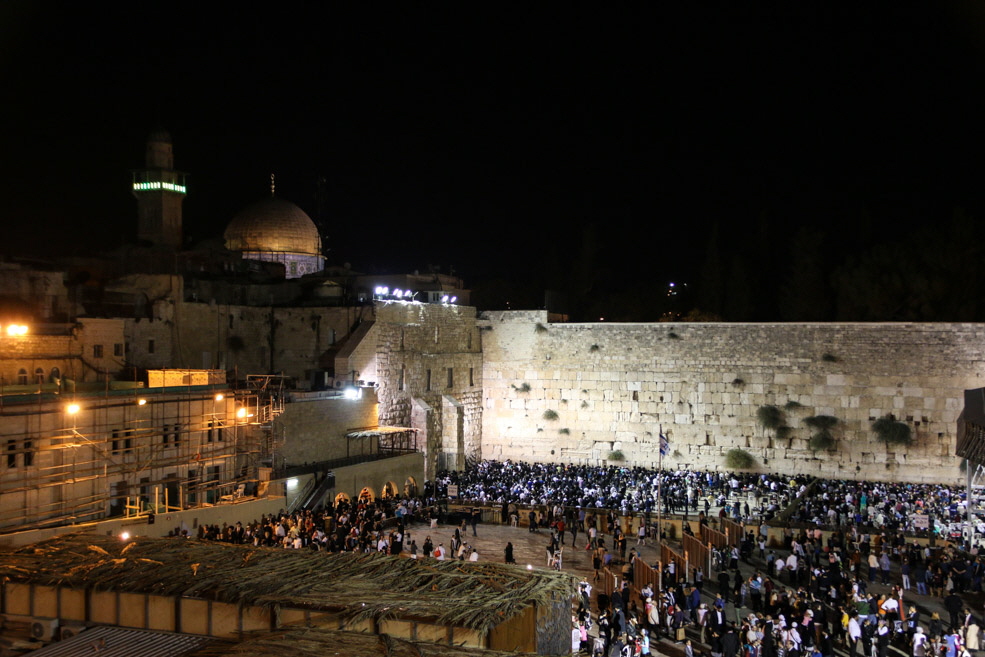
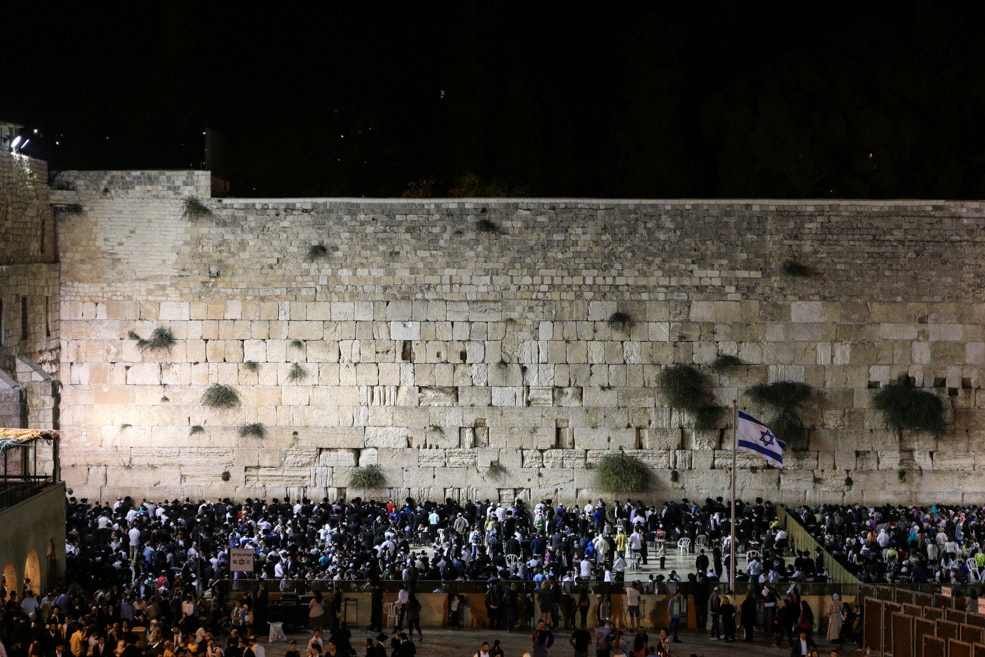
In the square the Jews were celebrating happily and exuberantly in their festive robes. There was singing and dancing and we felt privileged to witness it, as this was another face of Jerusalem we were lucky to see.
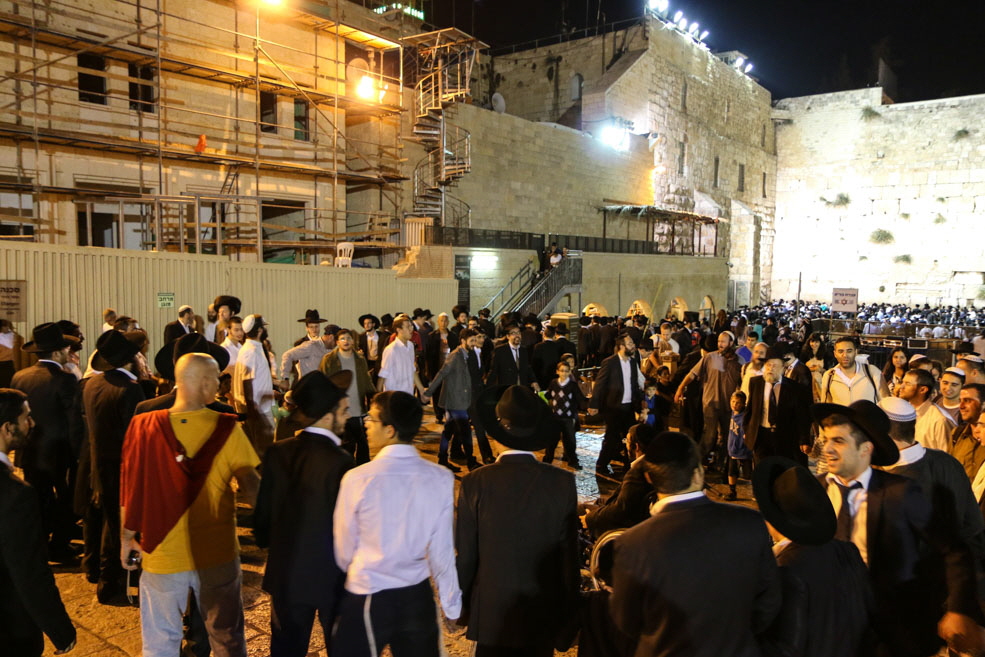
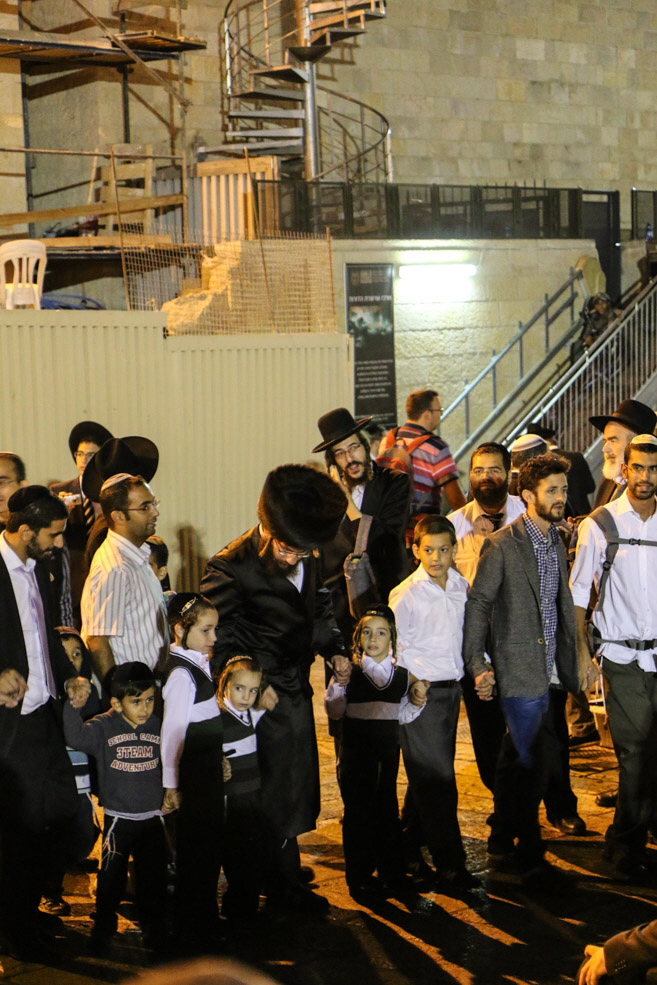
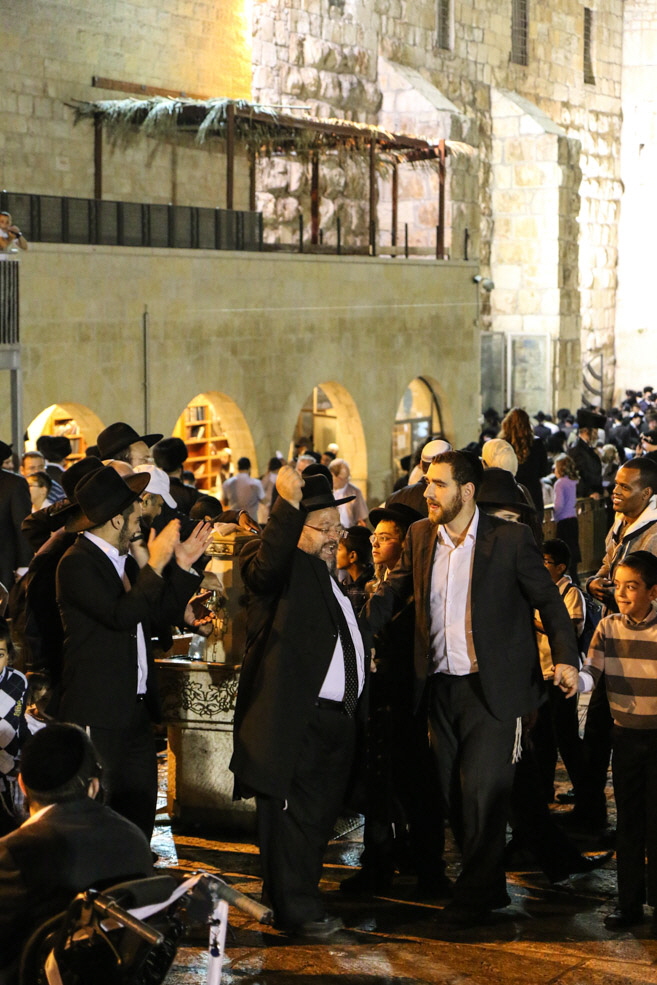
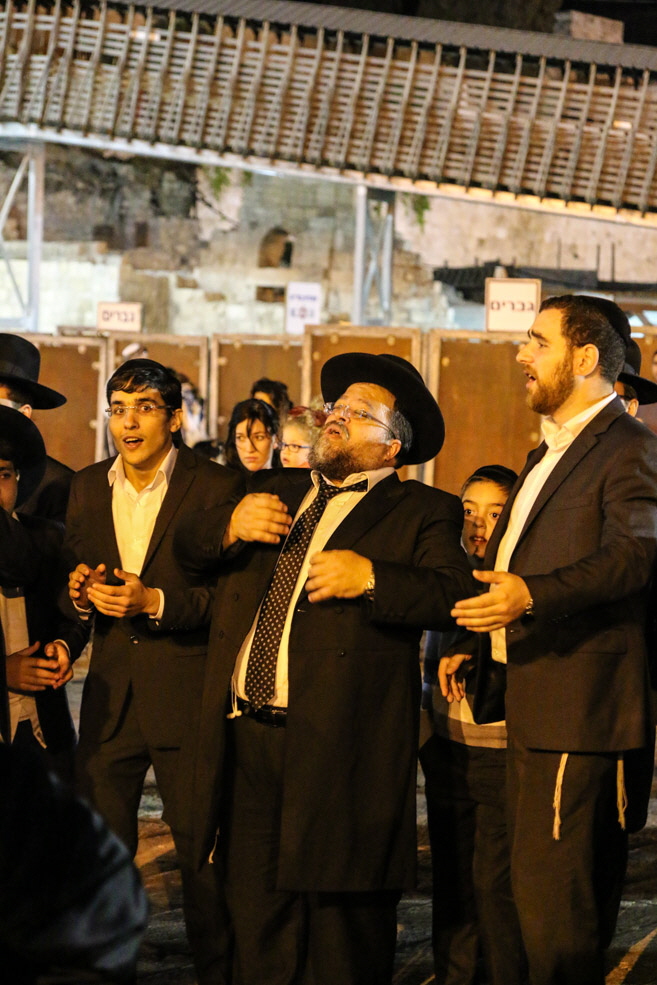
We broke away and returned through the small streets of the Muslim Quarter to leave the Old Town through the Herod’s Gate again. It seemed to us as if they were completely different streets.
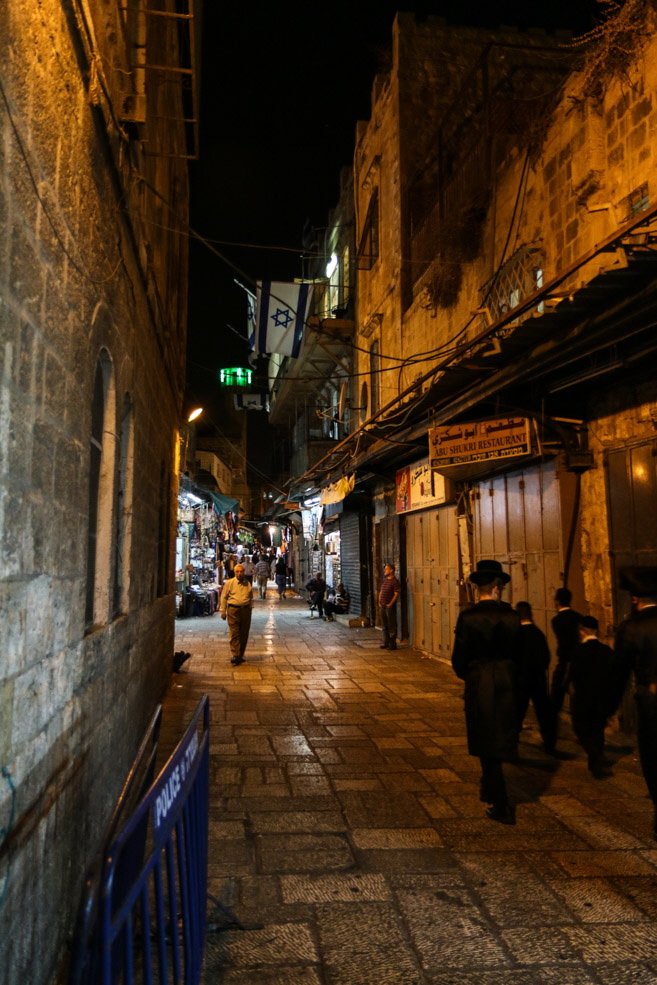
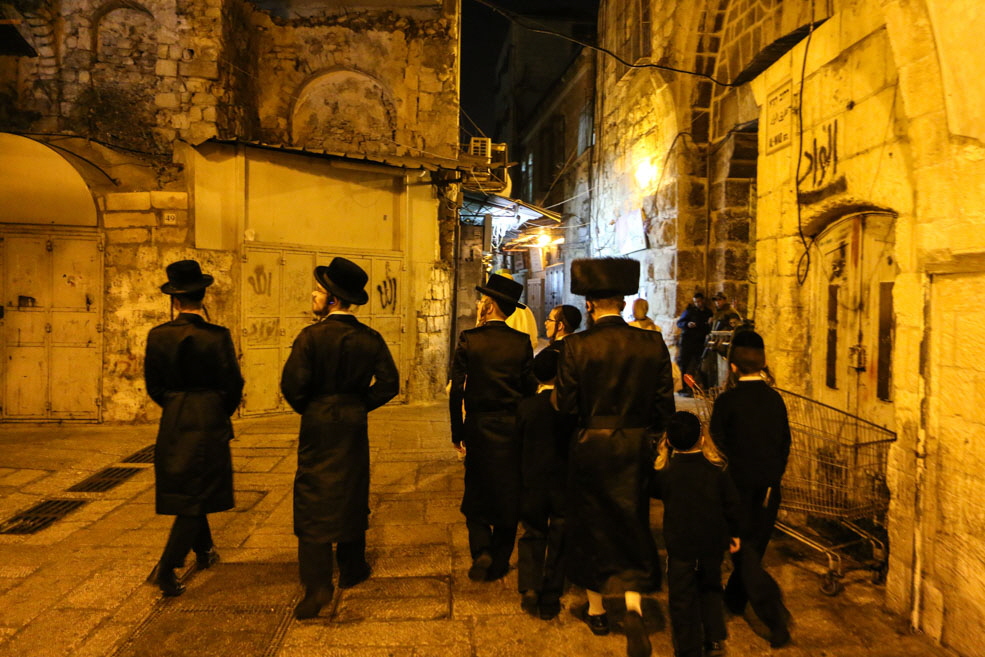
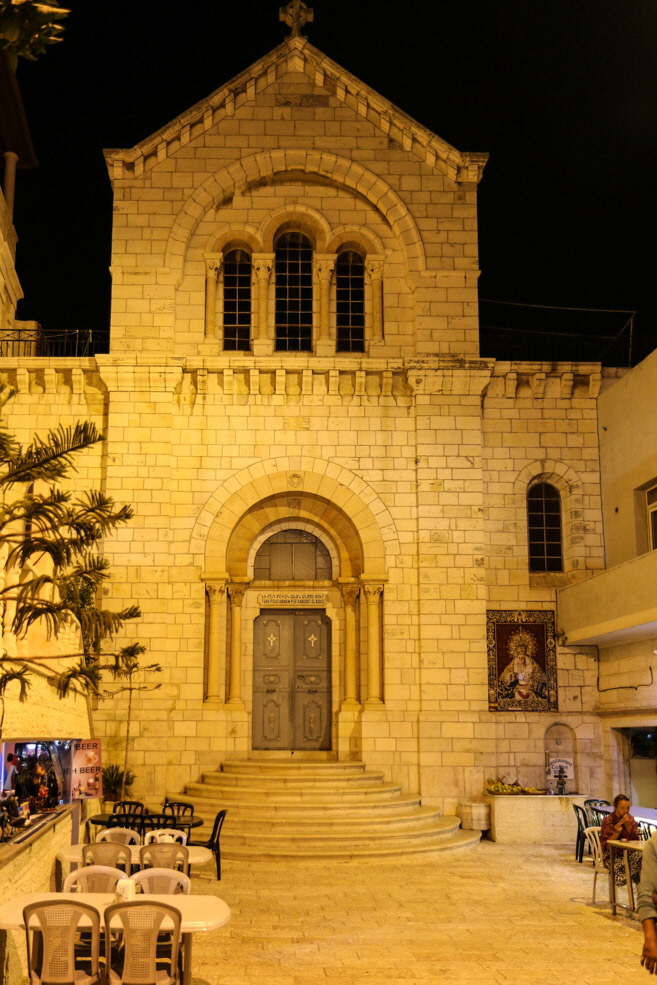
On Via Dolorosa we decided to have dinner in a restaurant on the street. Sitting here, with no other tourists around, was yet again a completely different experience.
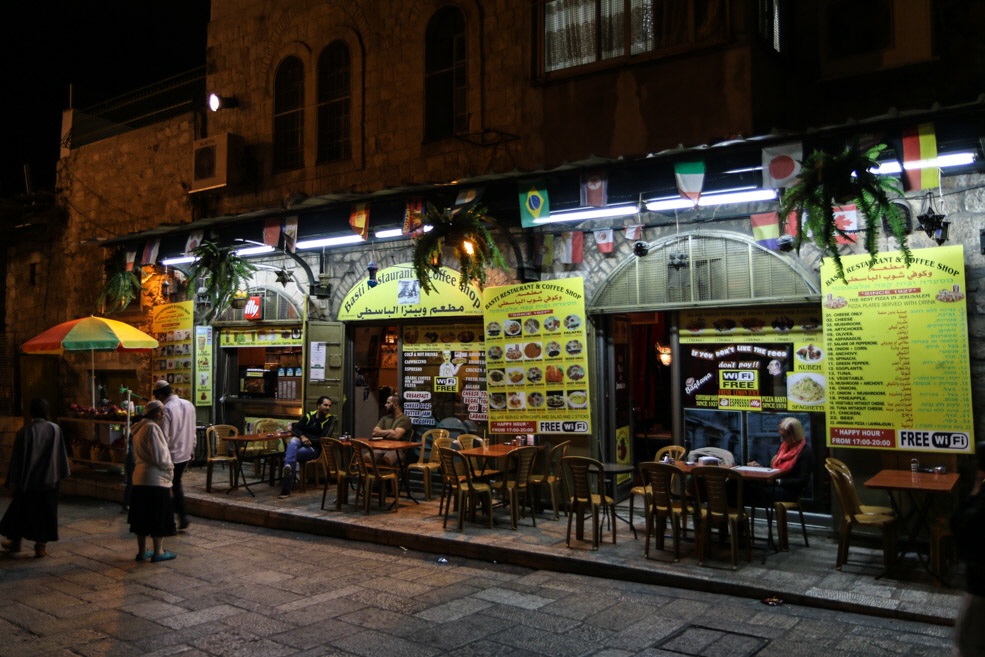
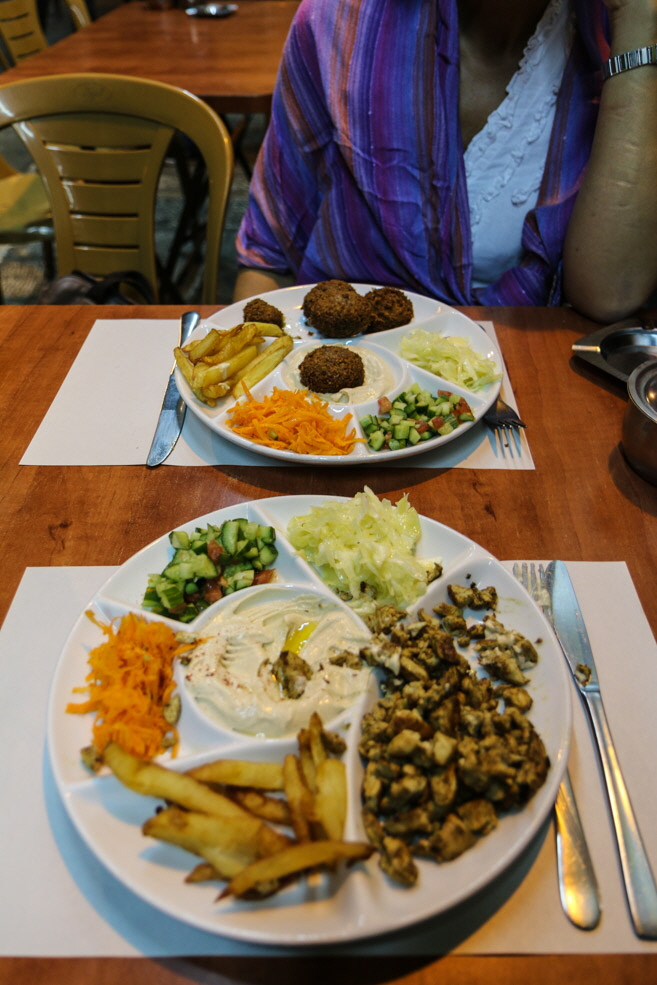
After a while we realized that it had been a long and eventful day and continued on our way through the empty alleys towards our hotel.
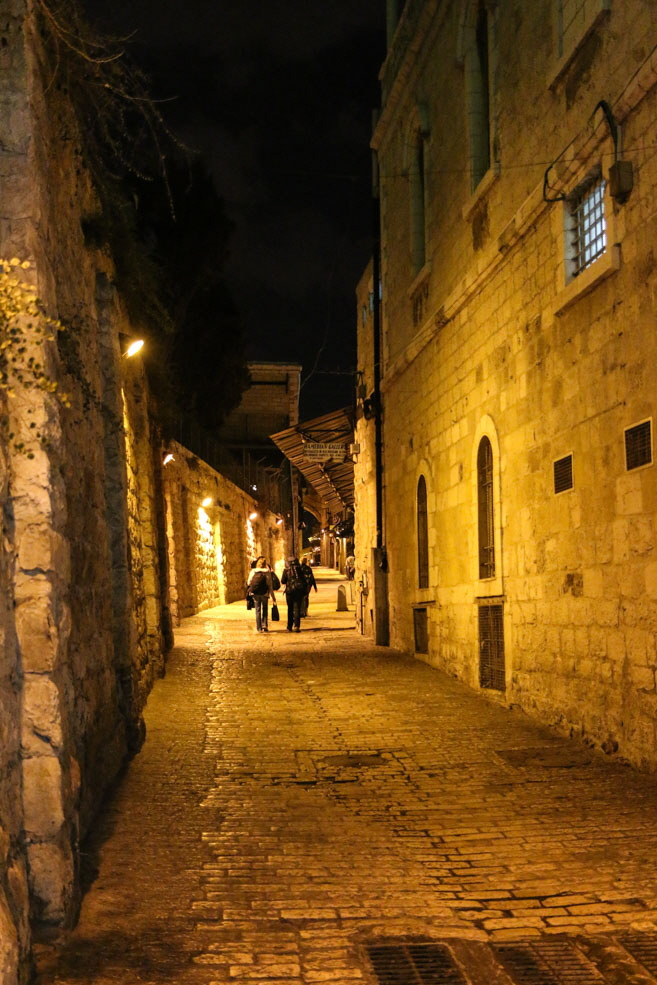
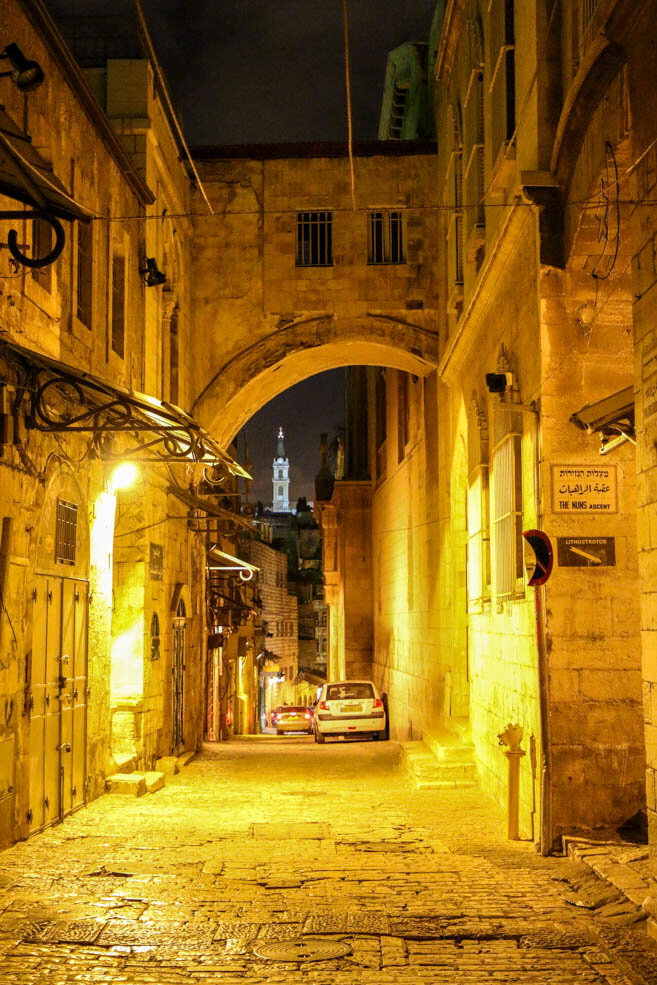
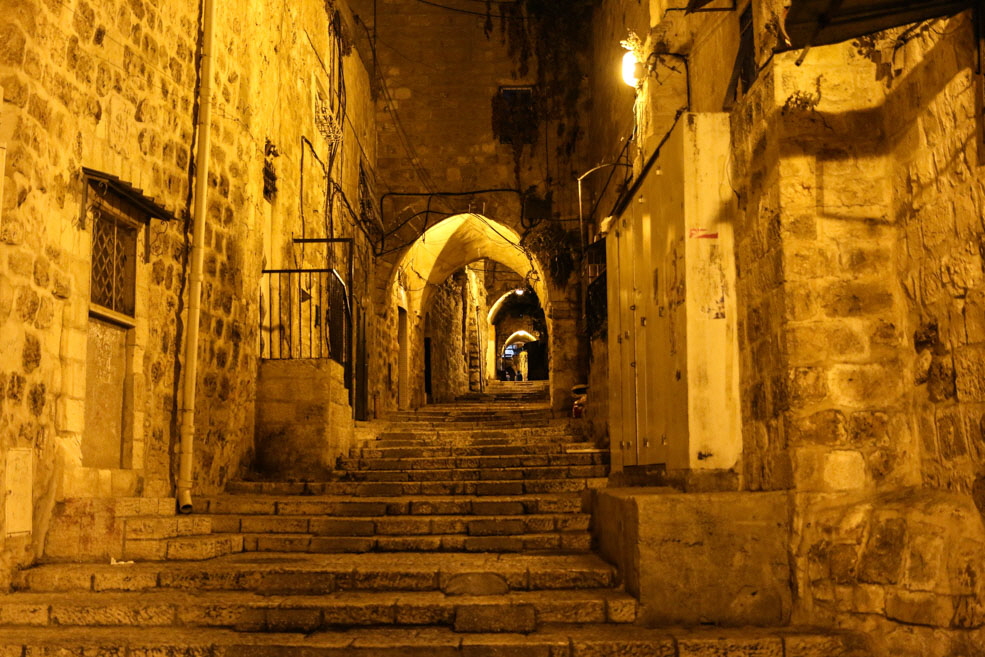
The view which was waiting for us at our hotel room was also beautiful by night.
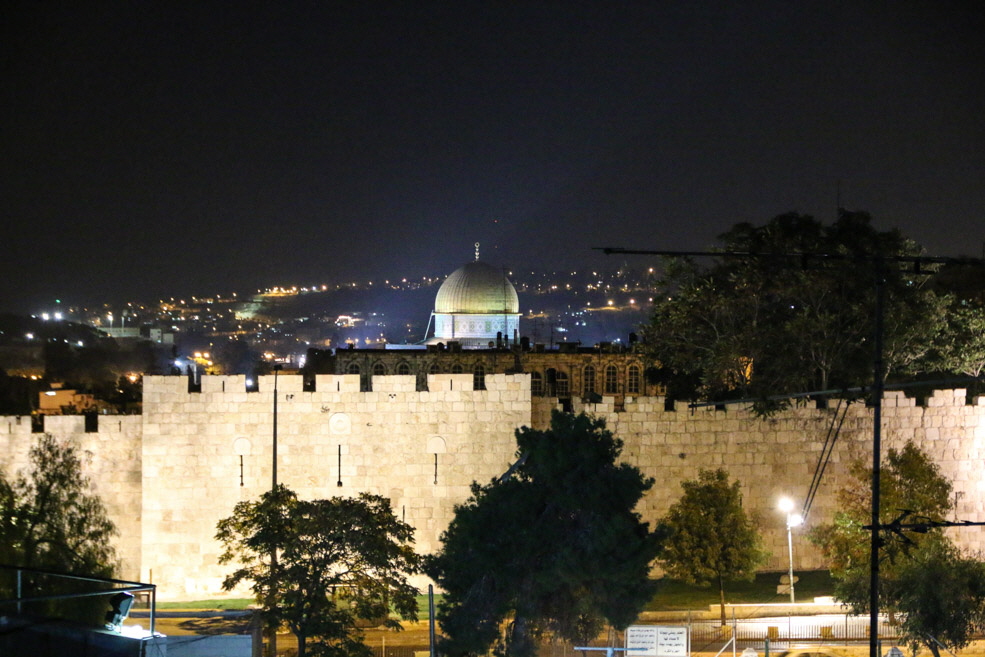
However, the nice view off the balcony could not compete with another view for long. It was this view which soon lured us into the realm of dreams.
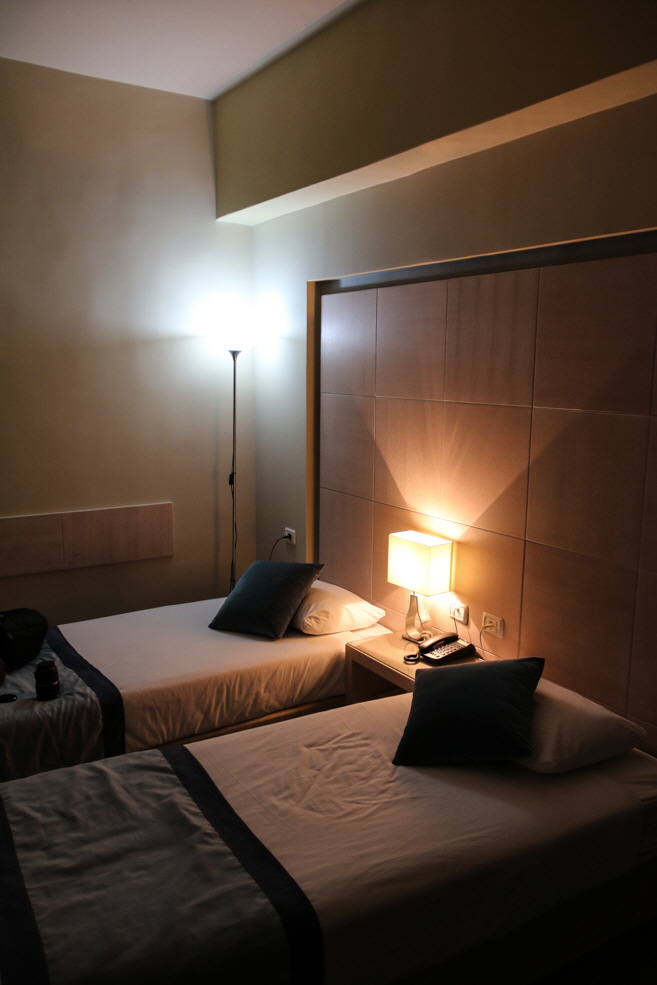
If we hadn’t known before, this first day in Jerusalem confirmed that our decision to book this cruise was spot-on. Everything we experienced would be sure to stay with us for a very long time, deeply embedded our memories.
www.travellove.one • www.thecruise.report • www.travelandcruise.net
© 2021 Die Rechte an Texten, Fotos und Videos liegen beim Autor der Webseite. Die Nutzung ist nur nach ausdrücklicher Freigabe erlaubt.
